-
Plant Name & Description
Botantical Name
-

Baby Blue Eyes Spruce Picea pungens 'Baby Blue Eyes'
This dwarf evergreen grows at a slow rate, only two to three inches per year. Nice pyramidal shape with sharply pointed, four sided, blue-green needles arranged radially on the shoots. Prefers full sun.
-

Baby Cakes Blackberry Rubus 'APF-236T'
This thornless hybrid dwarf blackberry provides an excellent addition to any edible home garden. The small size of this plant makes it a good option for either patio containers or garden beds. Produces large, juicy berries usually two times per year on second-year canes.
-
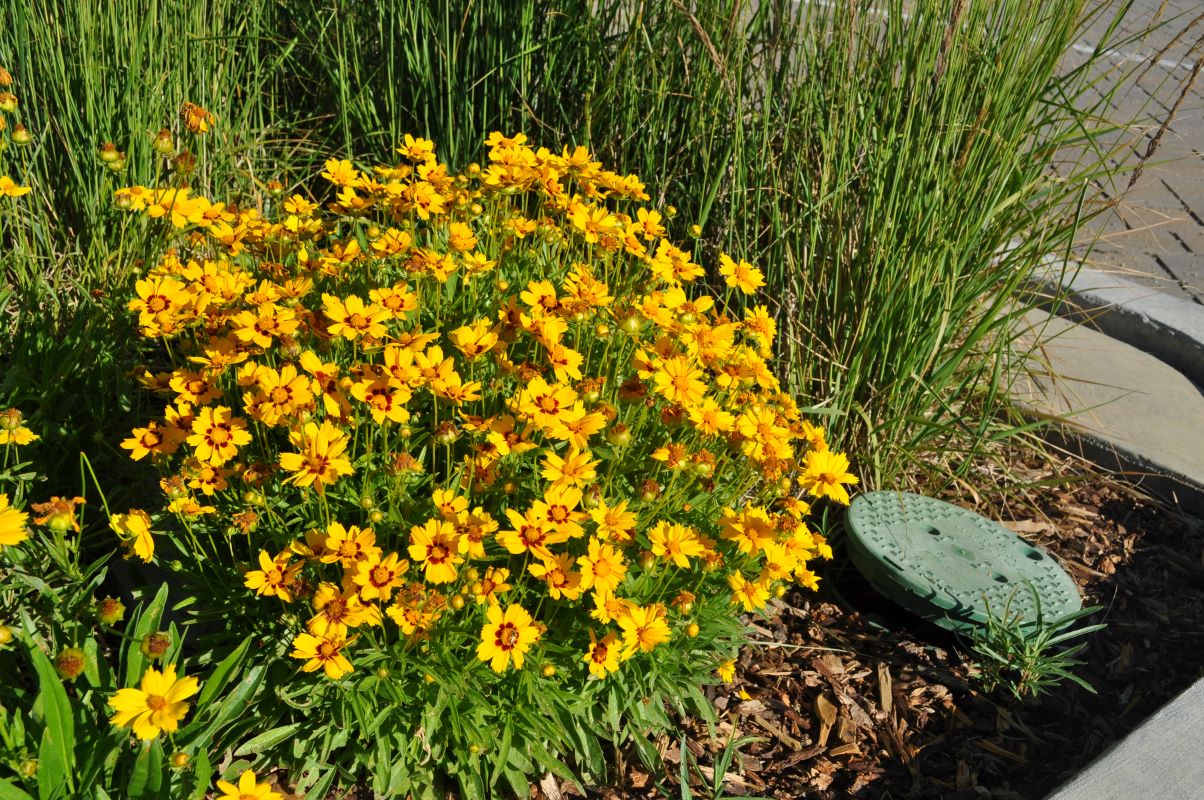
Baby Sun Lanceleaf Coreopsis Coreopsis grandiflora 'Baby Sun'
A compact coreopsis with solitary, yellow, daisy-like flowers that have jagged petal tips. It blooms from late spring through the summer. Grows best in dry to medium well drained soil in full sun. Loves poor or rocky soils. Prompt deadheading of spent flowers encourages additional blooming. Does not self seed. Tends to sprawl if grown in moist or fertile soil.
-
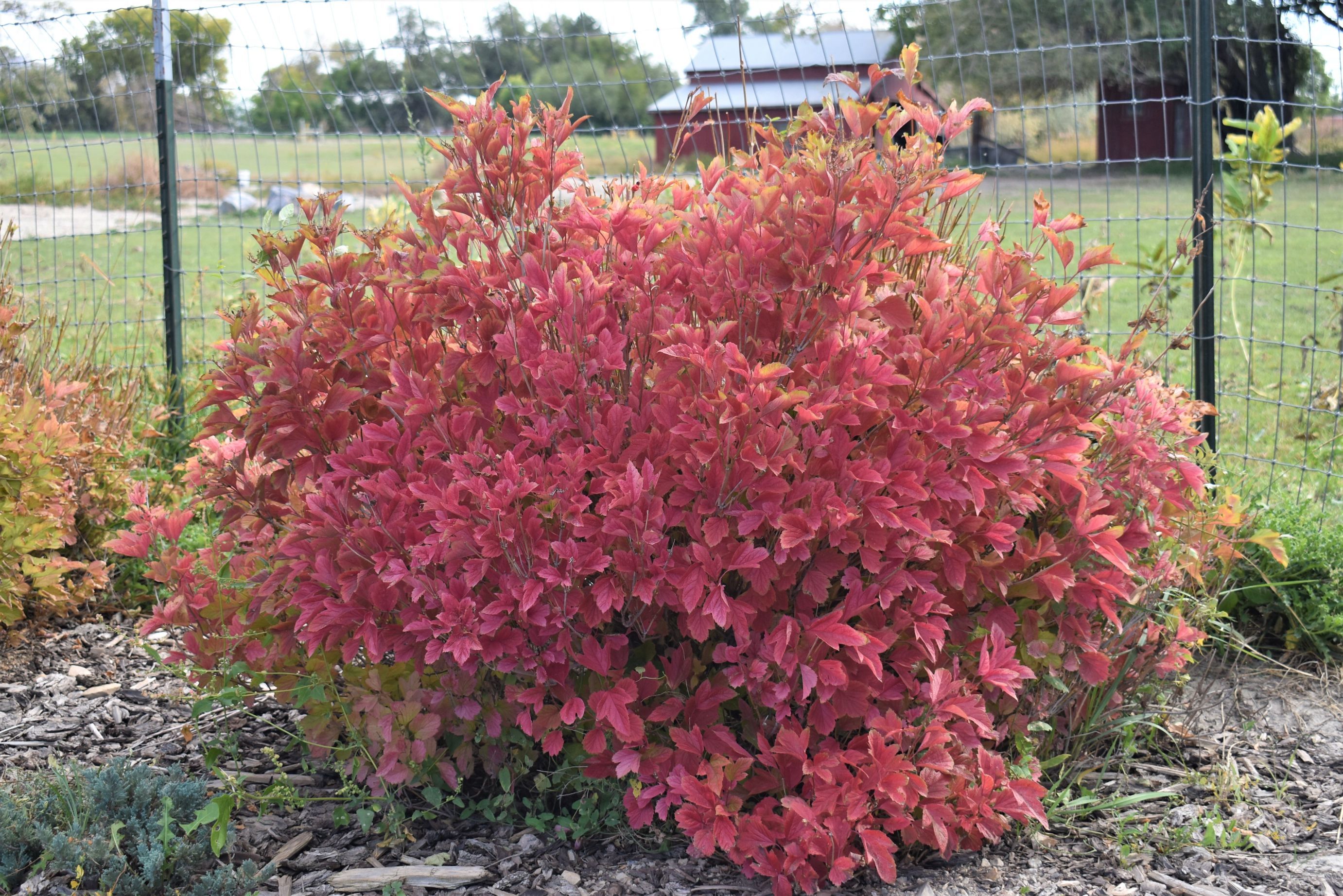
Bailey Compact American Cranberrybush Viburnum trilobum 'Bailey Compact'
This dwarf version of the species grows significantly shorter. Three-lobed leaves are green, but not showy until the fall when they turn striking shades of red. It produces clusters of white flowers in spring followed by small red berries that the birds won't touch. It prefers plenty of moisture but will handle some drought.
-

Bailey Red Twig Dogwood Cornus sericea 'Baileyi'
Vigorous, suckering, deciduous shrub with deep-red winter shoots. Has dark green leaves turning to red or orange in autumn. Small white flowers appear in clusters up to 2 inches across in late spring, followed by white fruit. Grows best in full sun and well-drained, moderately moist soil. Berries are mildly toxic and may cause stomach aches. The species, Cornus sericea, is synonymous with C. stolonifera and is native to Utah.
-
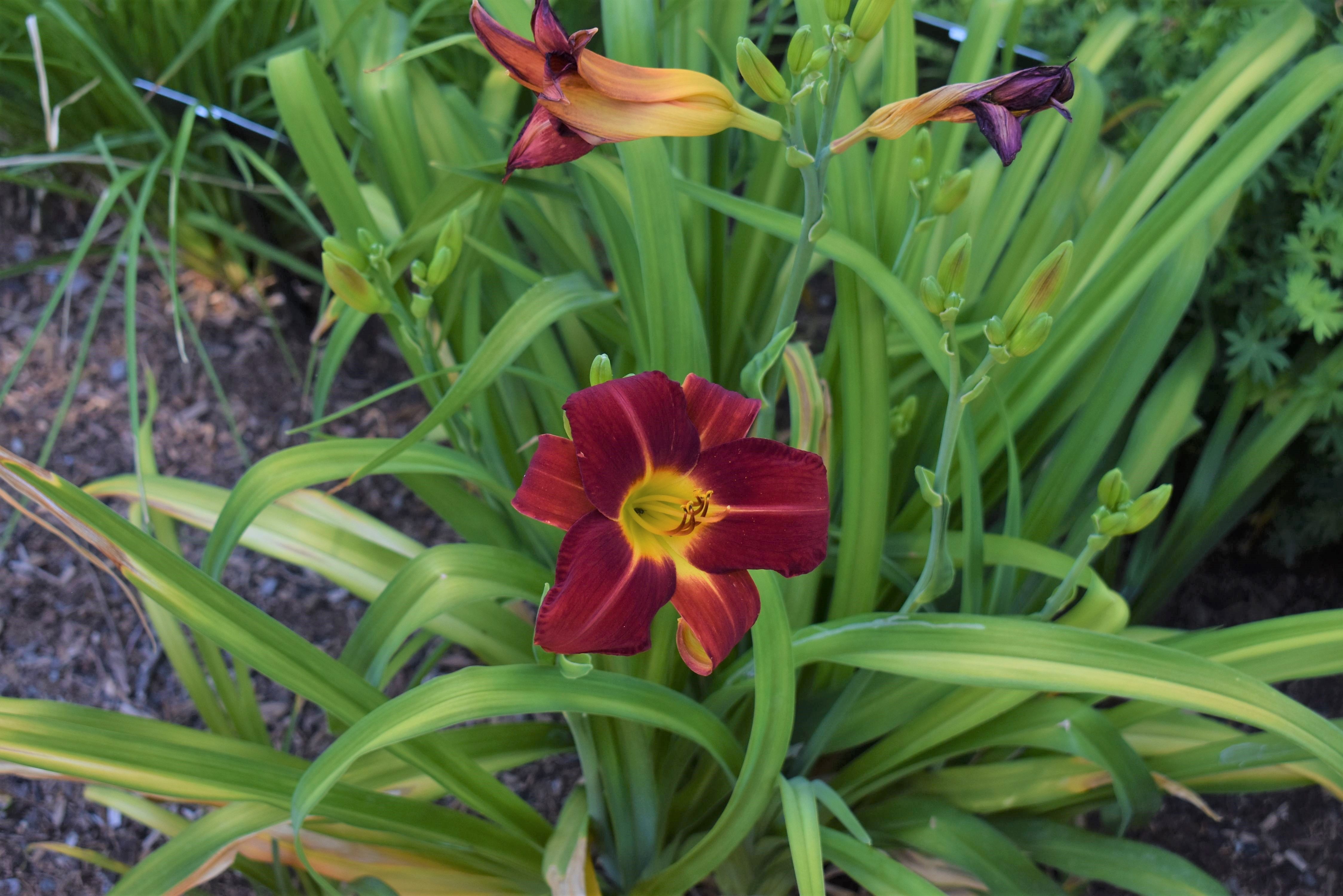
Baja Daylily Hemerocallis 'Baja'
Clump-forming herbaceous perennial with long, grass-like leaves. Large flowers are bright red with yellow centers and bloom throughout the summer. Tolerant of many soils, heat and low-water situations.
-

Bald Cypress Taxodium distichum
Although this conifer appears to be evergreen during the summer, it loses its needles in the late fall and winter, making it deciduous. The tall, conical tree grows broader with age. Can be found growing naturally in swampy areas but tolerates less water and somewhat dry conditions. Prefers acidic soil and should not be planted in soils with a pH higher than 7.5. Attractive bright green needles are quite flat and turn a bronze brown in the fall before falling off the tree. The base of the trunk is quite broad, even in youth and may form knobby "knees" in especially wet areas.
-

Ballerina White Wand Flower Gaura (syn Oenothera) lindheimeri 'Ballerina White'
This whimsical, low-water perennial provides striking small white flowers on tall stalks above a mound of leaves. The deep-green foliage can have traces of red in them. It blooms early summer until September.
-
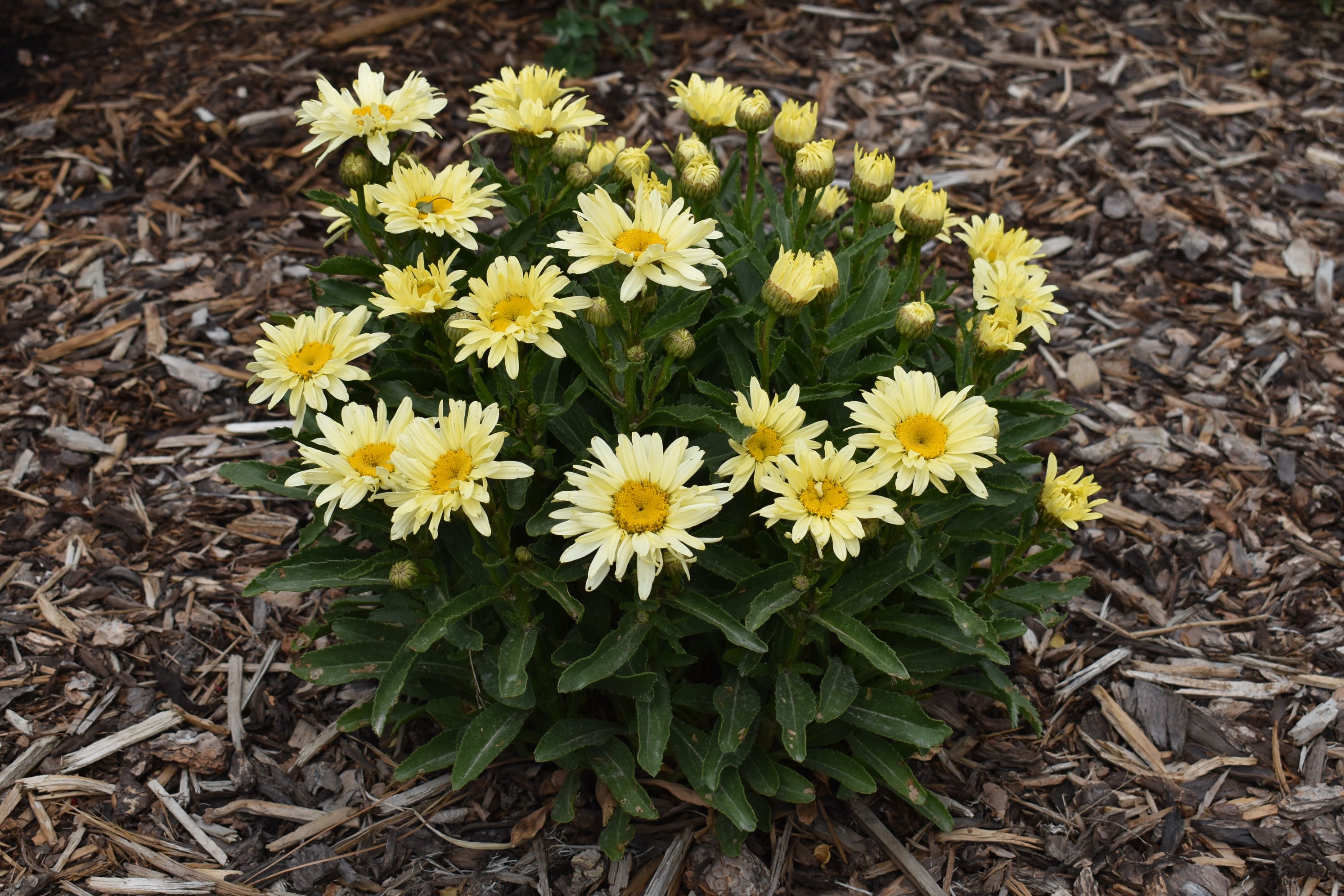
Banana Cream Shasta Daisy Leucanthemum x superbum 'Banana Cream'
All summer long, this compact perennial displays creamy white blossoms with hints of yellow. The centers are a vibrant dark yellow. These flowers are held on sturdy, upright stems held above roughly toothed, elongated, elliptical leaves. This shasta daisy is great for garden beds, pots and cut flowers.
-
Banana Yucca Yucca baccata
Rosette-forming evergreen shrub. Long lance-shaped gray to blue-green leaves grow from the woody base. Leaf tips are quite stiff and form a sharp spine. Creamy white pendant flowers grow on tall stalks above the plant in spring. With two or more plants the flowers will grow an edible banana-shaped fruit that was used as a food source by native Americans. Requires little or no water once established.
-

Bandwidth Maiden Grass Miscanthus sinensis 'Bandwidth'
An upright, dwarf maiden grass with vibrant bands of yellow and green foliage. There are light, airy, golden-brown plumes that emerge in the fall and hold on through winter. This ornamental grass is great as an accent plant or grown in mass groupings.
-
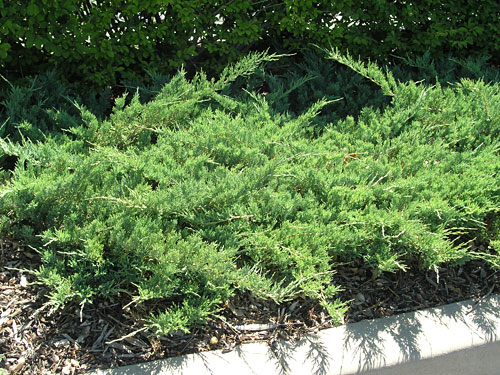
Bar Harbor Juniper Juniperus horizontalis 'Bar Harbor'
Low-growing evergreen shrub. Needles are scale-like when mature and more awl-like when younger. This cultivar does not flower or set fruit. The blue-green foliage turns purplish in the winter. Does not tolerate wet soils. Prefers hot and relatively dry sites. Though adaptable to many soils, this shrub prefers sandy soils.
-

Barbara Mitchell Daylily Hemerocallis 'Barbara Mitchell'
Clump-forming herbaceous perennial with long, grass-like leaves. Ruffled, soft-pink flowers bloom throughout the summer. Tolerant of many soils, heat and low-water situations.
-

Baroness Schroder Peony Paeonia lactiflora 'Baroness Schröder'
Clump-forming, bushy herbaceous perennial. Abundant mid-green deeply-lobed foliage grows on stiff upright stems. Large fragrant double white flowers are loose and irregularly margined. Plant in fertile well-drained soils. Tolerates some drought once established.
-
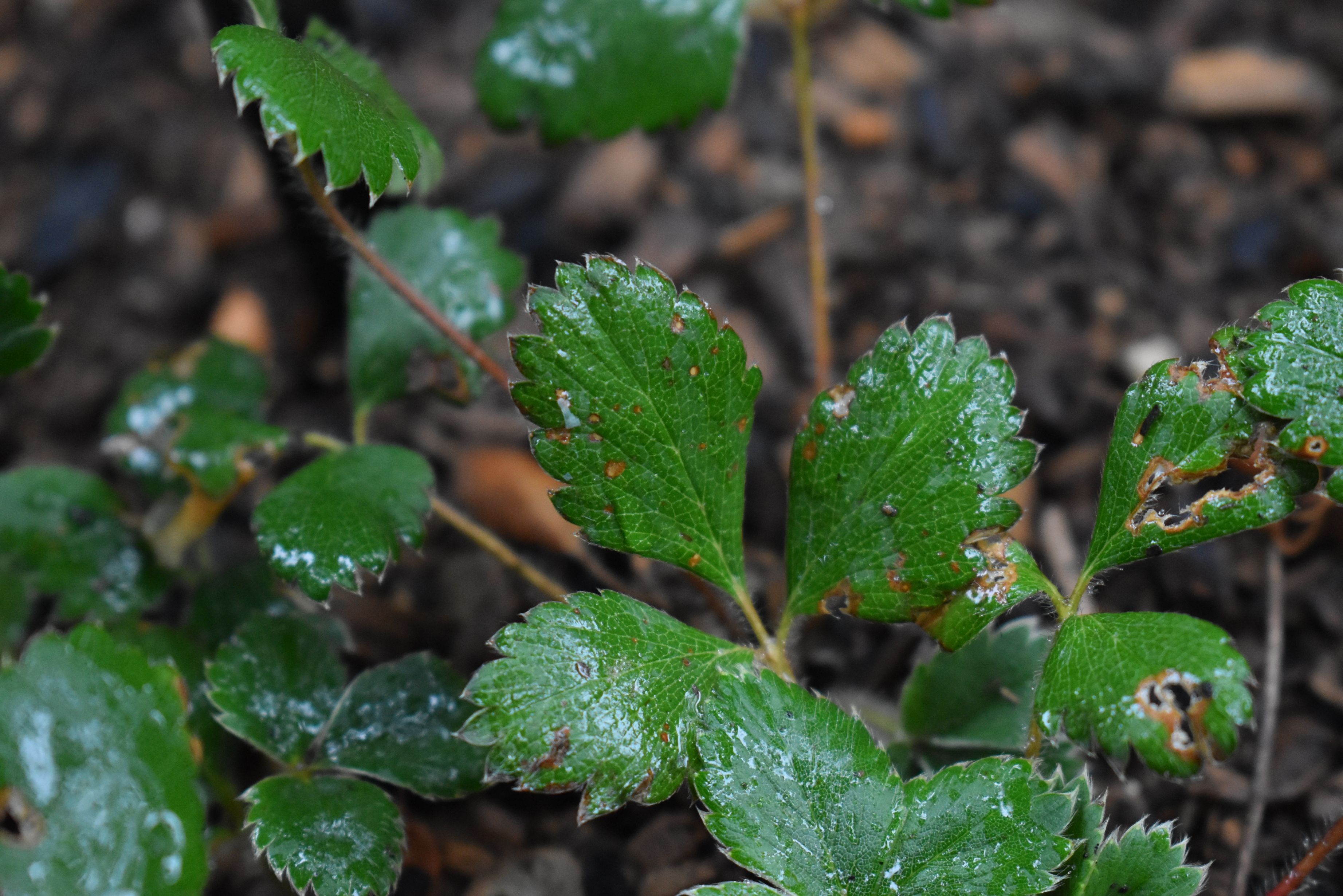
Barren Strawberry Waldsteinia ternata
Low-growing groundcover that looks similar to a strawberry. Leaves are trifoliate and medium green with serrated edges. Flowers resemble those of the strawberry but are yellow and produce inedible fruit. Spreads readily and forms an attractive green carpet.
-

Basin Wildrye Leymus cinereus
Large ornamental bunch grass native to much of North America especially the Great Basin. Foliage grows green to blue-green and begins to turn dormant in late-summer. Spiked seed head grow on tall stems above the clump. Tolerates a wide range of soil and water conditions.
-

Basket-of-Gold Aurinia saxatilis
This low-growing, spreading perennial is covered in profuse yellow flowers. Its sprawling form is particularly attractive in rock gardens or on rock walls. The foliage is gray-green and fades somewhat in the summer heat.
-

Batik Iris Iris 'Batik'
Upright growing perennial with fragrant flowers. Blooms are short-lived and may only last for 3-7 days. Flowers are deep purple with white splashes and stripes. Long, lance-shaped leaves are attractive and deer resistant.
-
Beacon Hill Cedar of Lebanon Cedrus libani 'Beacon Hill'
This weeping variety of the Cedar of Lebanon grows in a weeping form that can be trained to grow very tall or allowed to grow in a more meandering form. Short green needles are soft and grow on sweeping branches. It is adaptable to drought and poor soils but performs best with plenty of water.
-
Bear's Breeches Acanthus spinosus
This plant has a clumping habit but can spread aggressively by creeping rootstocks. The leaves are glossy green with spiny, thistle-like leaves that arch to the ground. The flowers are pure white snapdragon-like flowers with reddish-purple hooded look. Flower spikes are 3-4 feet tall. They prefer average, well-drained soil and should not be overwatered.
-
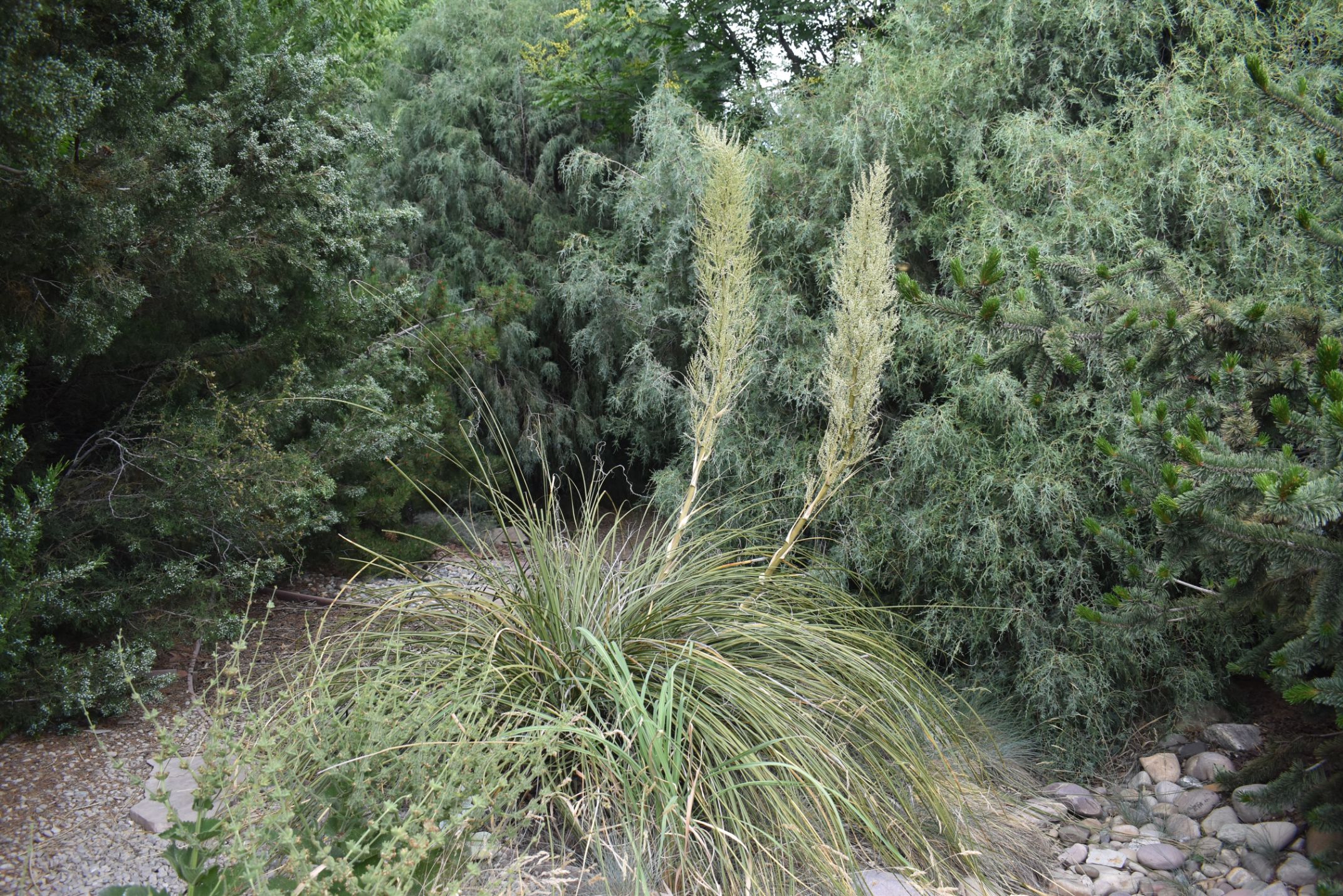
Beargrass Nolina microcarpa
Resembles a grass but is a member of the Agave family. Native to the southwestern United States. Very tolerant of a variety of soil conditions and requires little or no water once established. Spreads by rhizomes.
-

Beauty of Livermere Oriental Poppy Papaver orientale 'Beauty of Livermere'
Deep red flowers on sturdy stems bloom in late spring. This cultivar is characterized by a dark blotch at the base of each crepe papery petal. The foliage dies back after blooming, so hide among perennials that will later cover the browning foliage.
-
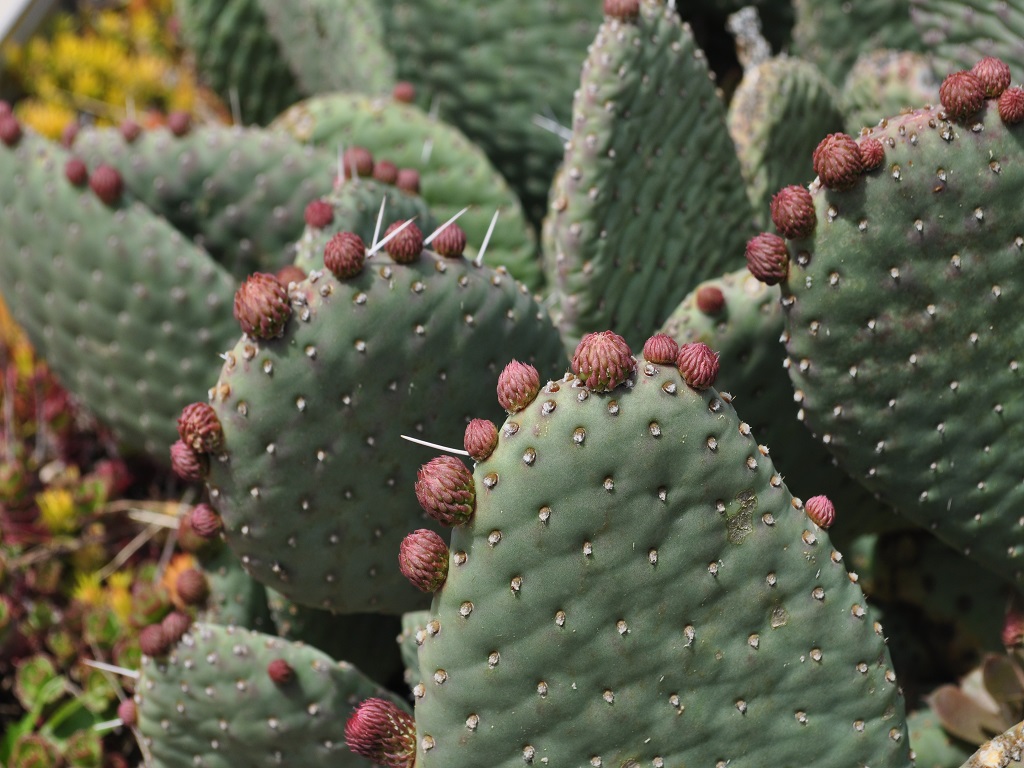
Beavertail Cactus Opuntia basilaris
Bristly succulent with gray-green, fleshy, flattened pads. Small needles are tinted red. Bright pink flowers bloom in spring. Prefers light soils and and little water once established.
-
Becky Shasta Daisy Leucanthemum x superbum 'Becky'
This clump-forming perennial produces large, pure white flowers with yellow centers in late-summer to autumn. Its leaves are green and glossy with toothed margins. This cultivar is noteworthy as one of the largest growing shasta daisies. Plant it in well-drained soils. It will tolerate some drought but prefers moderate amounts of water.
-
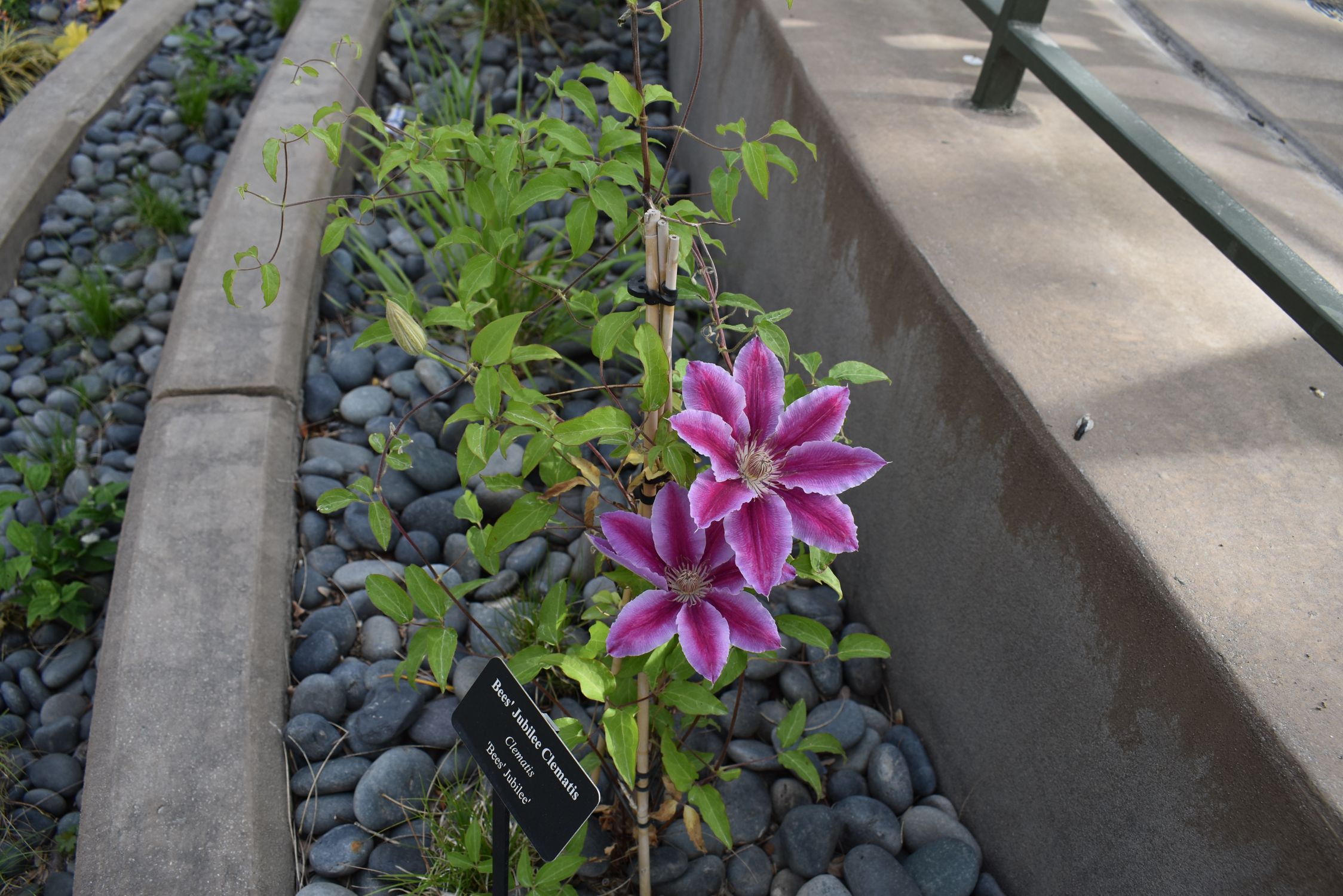
Bees Jubilee Clematis Clematis 'Bees Jubilee'
Large flowers in varying shades of pastel pink make an impact even in shady areas. A thick bar of magenta runs down the middle of each petal, creating a beautiful contrast for the creamy yellow stamens. Under ideal conditions, this vine puts on two flower shows: first in late spring to early summer, and another in late summer to early fall. When the flowers fade, attractive wispy seed heads follow. Perfect for spilling over containers, climbing up trellises and arches, or weaving its way through planting beds.
-
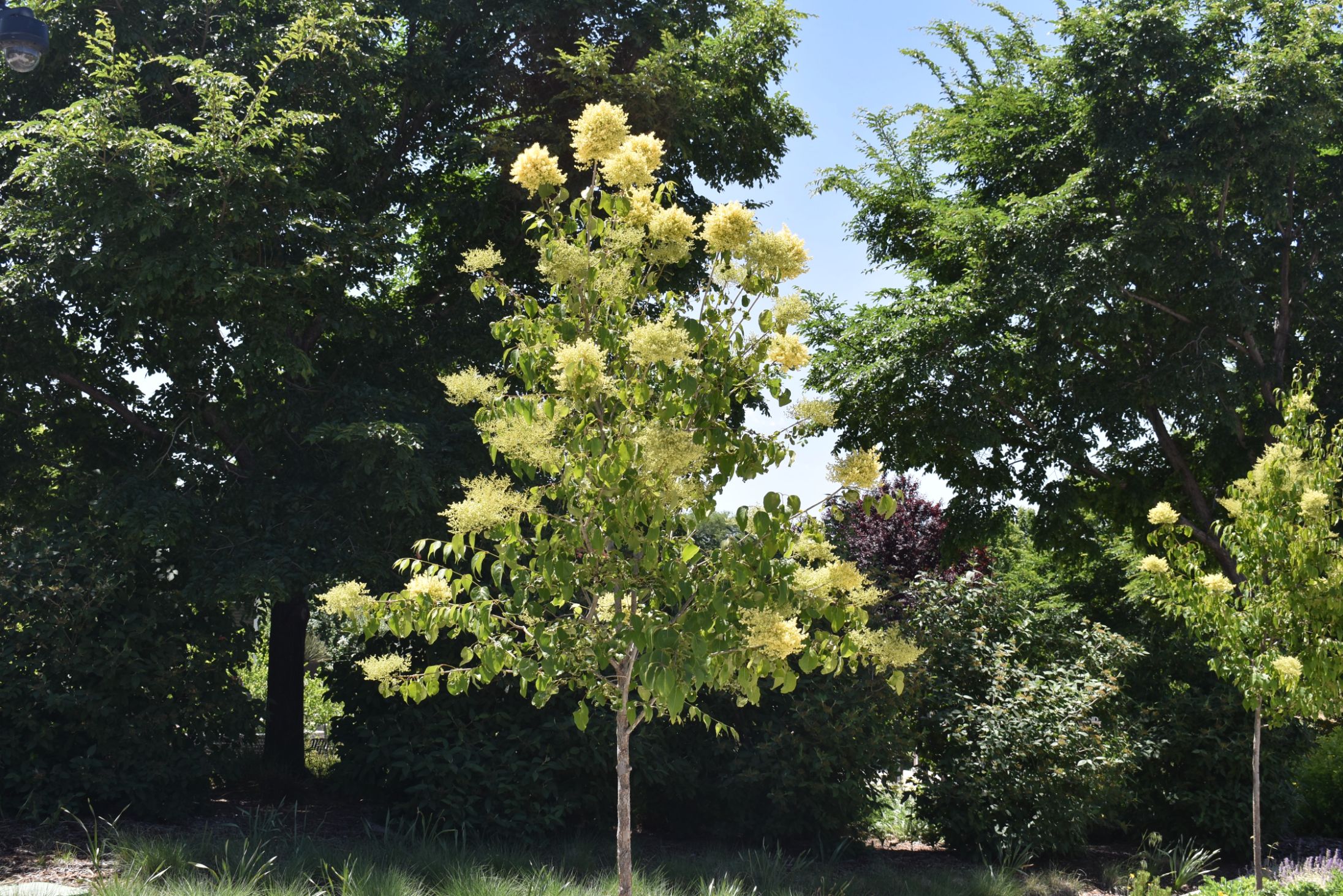
Beijing Gold Tree Lilac Syringa pekinensis 'Zhang Zhiming'
This beautiful, yet hardy tree is ideal for urban areas. It has an upright spreading habit with arching branches. Early summer brings creamy yellow blossoms. The foliage turns a golden yellow in fall that contrasts well with its cinnamon-colored bark.
-
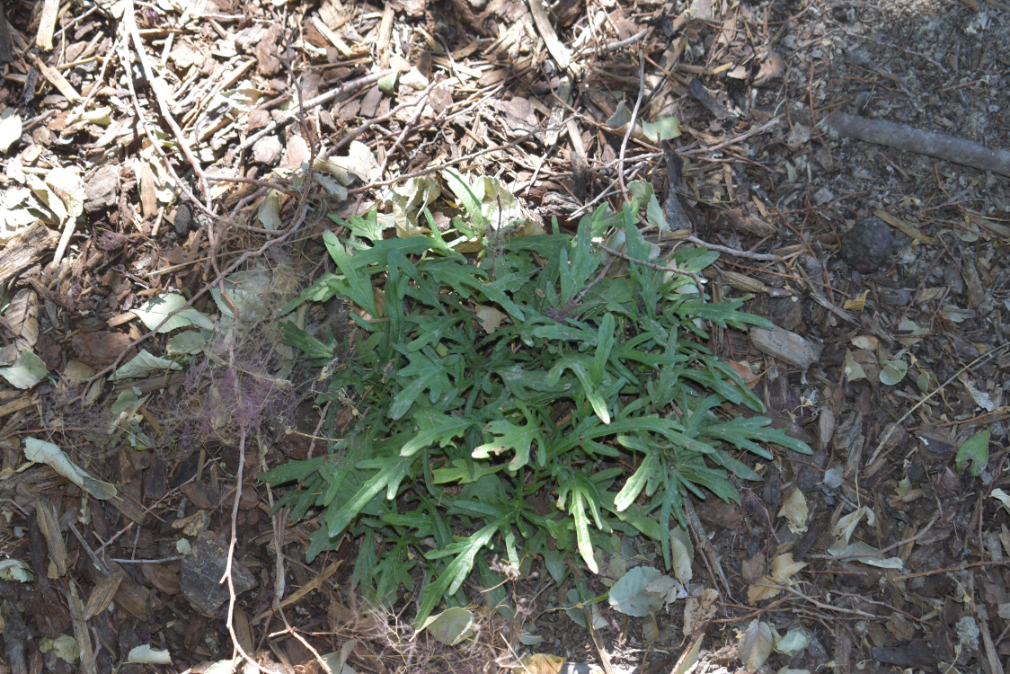
Bella Blue Self-Heal Prunella grandiflora 'Bella Blue'
A vigorous, low-growing groundcover to quickly fill in gaps in sun or part shade. Round clusters of purple flowers bloom profusely from late spring to early fall. This European plant was traditionally used to treat injuries and diseases.
-

Ben Ledi Sun Rose Helianthemum 'Ben Ledi'
Low-growing, evergreen, shrubby perennial. Small, silvery green, lance-shaped leaves are downy. Bears profuse deep pink rose-shaped flowers in late-spring to early-summer. Grows well as a groundcover or in rock gardens. Presents a very stunning show when covered with flowers.
-
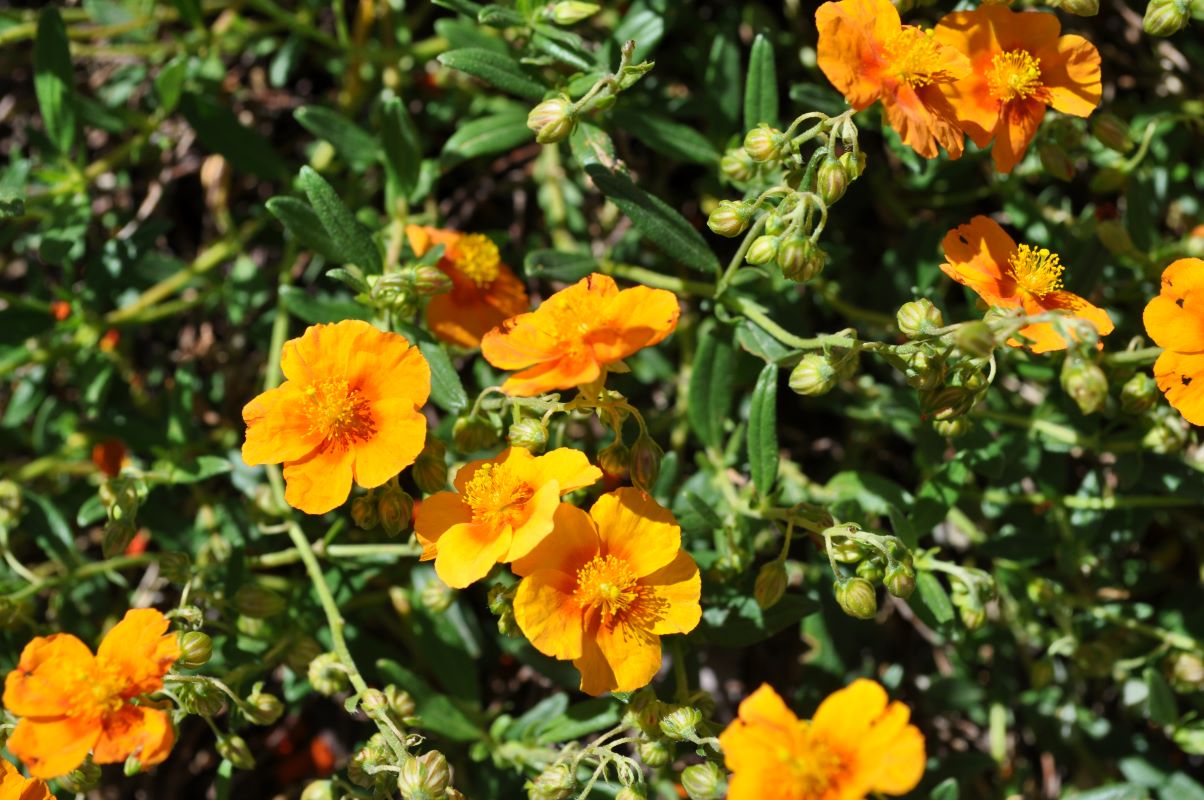
Ben More Sun Rose Helianthemum 'Ben More'
Low-growing, evergreen, shrubby perennial. Small, silvery green, lance-shaped leaves are downy. Bears profuse bright-orange rose-shaped flowers in late-spring to early-summer. Grows well as a groundcover or in rock gardens. Presents a very stunning show when covered with flowers.
-
Berggarten Sage Salvia officinalis 'Berggarten'
This cultivar of the wonderfully aromatic culinary sage can be used ornamentally and for culinary purposes. 'Berggarten' has a more compact shape and wider, rounder leaves than other types of sage. This semi-evergreen shrub has rounded, fuzzy, gray-green foliage that takes on a hint of purple in the sun. Clusters of purple-blue flowers bloom on upright stems above the plant, attracting large numbers of bees and butterflies. Tolerates drought and heat, but do not overwater.
-

Berry Blue Honeyberry Lonicera caerulea var. edulis 'Berry Blue'
This upright shrub has small, cream-colored flowers in the spring that give way to large, sweet fruit that taste like wild blueberries with a hint of currant. Honeyberries ripen much earlier than other fruits, such as a couple weeks before strawberries. They can be harvested in late May to early June. It requires two varieties with similar bloom time to pollinate such as Blue Belle, Blue Sky, or Blue Bird.
-

Berry Garcia Itoh Peony Paeonia 'Berry Garcia'
Clump-forming, bushy herbaceous perennial. Abundant mid-green deeply-lobed foliage grows on stiff upright stems. Large fragrant double peach flowers are loose and irregularly margined. Petals flare out from light to dark orange-pink, with contrasting yellow stamens in the centers. Plant in fertile well-drained soils. Tolerates some drought once established.
-
Bertram Anderson Lungwort Pulmonaria longifolia 'Bertram Anderson'
A very dependable and showy spring-blooming perennial with attractive long, narrow, green foliage with silver spots. The pink buds open to reveal cobalt-blue flowers which bloom on the ends of arching stems and can add color to completely shady beds. They can handle some morning sun but need to be in afternoon shade to avoid leaf scorch. This Lungwort is semi-evergreen in warmer areas.
-
Betty's Blue Lavender Lavandula angustifolia 'Betty's Blue'
Great multi-use plant used as an herb for its soothing fragrance and as a water-wise landscape plant. A compact, bushy shrub with gray-green leaves and a pretty Mediterranean look. The fragrant, deep purple to blue blossoms form on long stalks up to 3 inches long, in late spring to early summer. These can be harvested in their bud stage and dried for indoor use. Prefers full sun but can handle some shade.
-
Beurre D'Anjou Pear Pyrus communis 'Beurre D'Anjou'
Deciduous, fruit-bearing tree. Pure white flowers bloom in mid-spring followed by medium to large pears that ripen in September. Unlike other pears, D'Anjou's ripen green with only a slight blush and are more tart than other pears. Requires moderate amounts of water to support fruit growth.
-
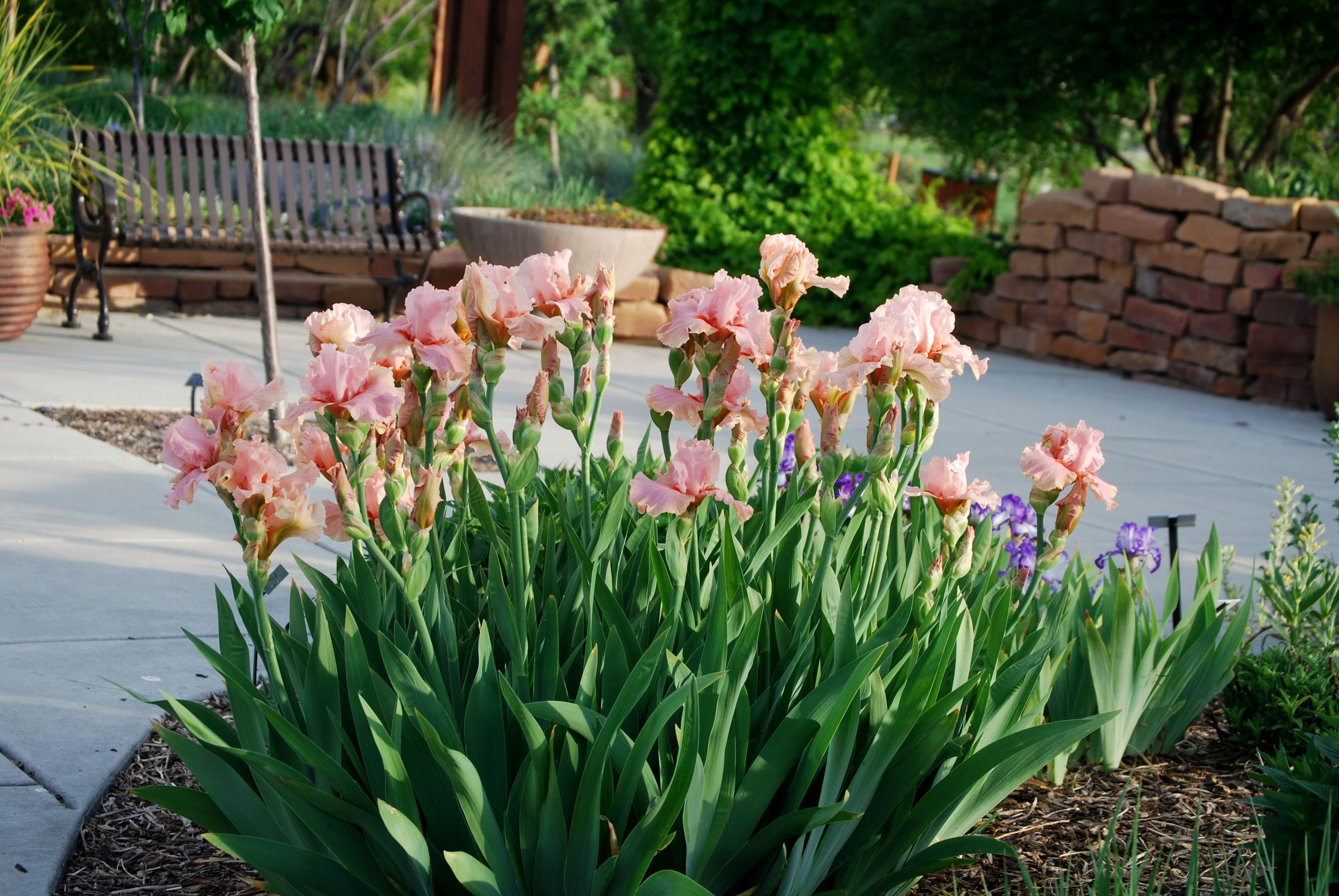
Beverly Sills Iris Iris 'Beverly Sills'
Upright growing perennial with fragrant flowers. Blooms are short-lived and may only last for 3-7 days. Flowers are bright pink. Long, lance-shaped leaves are attractive and deer resistant.
-
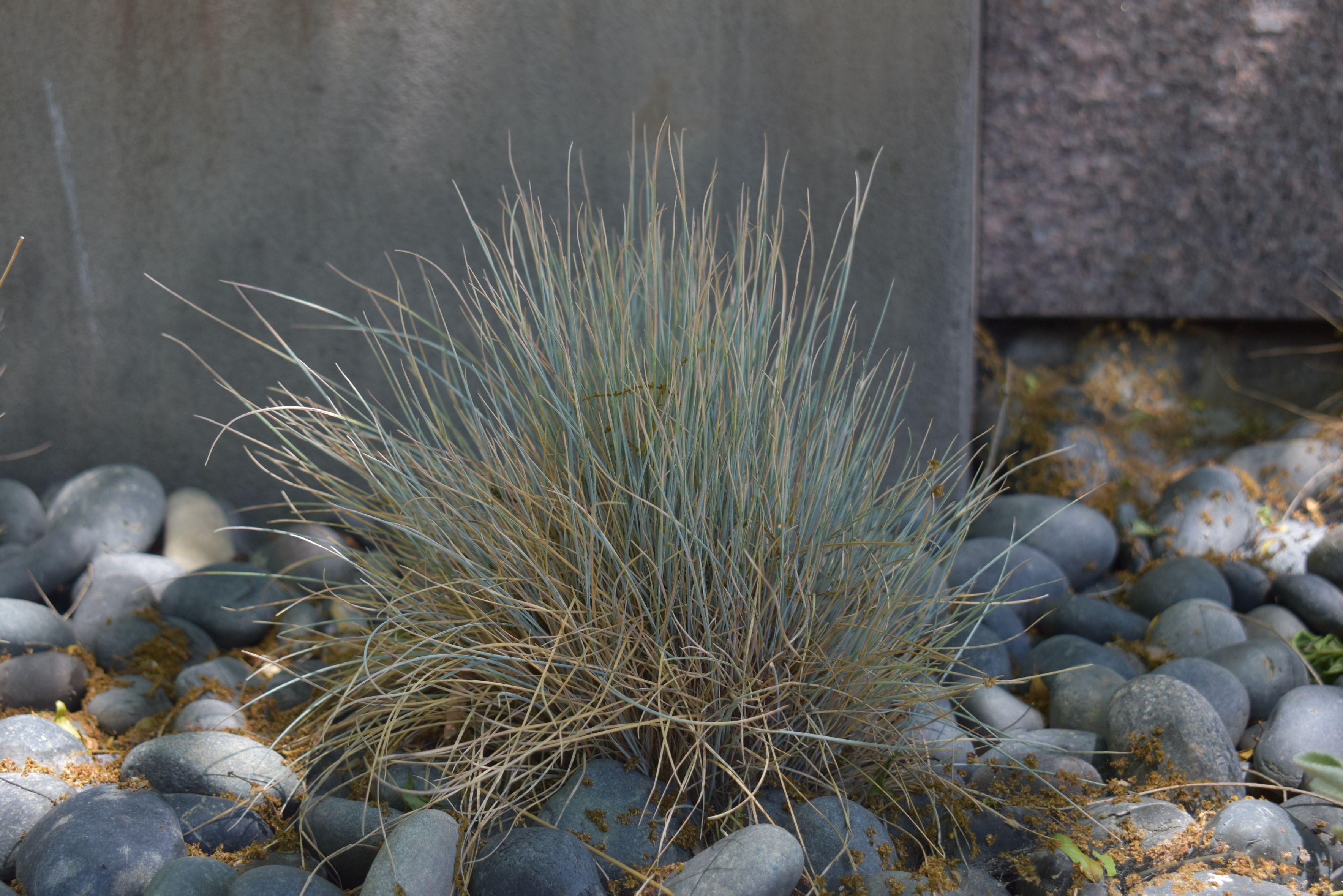
Beyond Blue Fescue Festuca glauca 'Casca11'
‘Beyond Blue’ was found in the Netherlands as a naturally growing mutation of the beloved ‘Elijah Blue’ fescue. This evergreen to semi-evergreen grass comes in neat, compact mounds of slender, cascading silver-blue foliage. Attractive tan seed heads stand above the foliage in late summer. A great choice for a dynamic groundcover or for areas needing a burst of color.
-
Beyond Midnight Bluebeard Caryopteris x clandonensis 'CT-9-12'
A very dependable and showy summer-blooming perennial with attractive long, narrow, green foliage with silver spots. The pink buds open to reveal cobalt-blue flowers which bloom on the ends of arching stems and can add color to completely shady beds. They can handle some morning sun but need to be in afternoon shade to avoid leaf scorch.
-
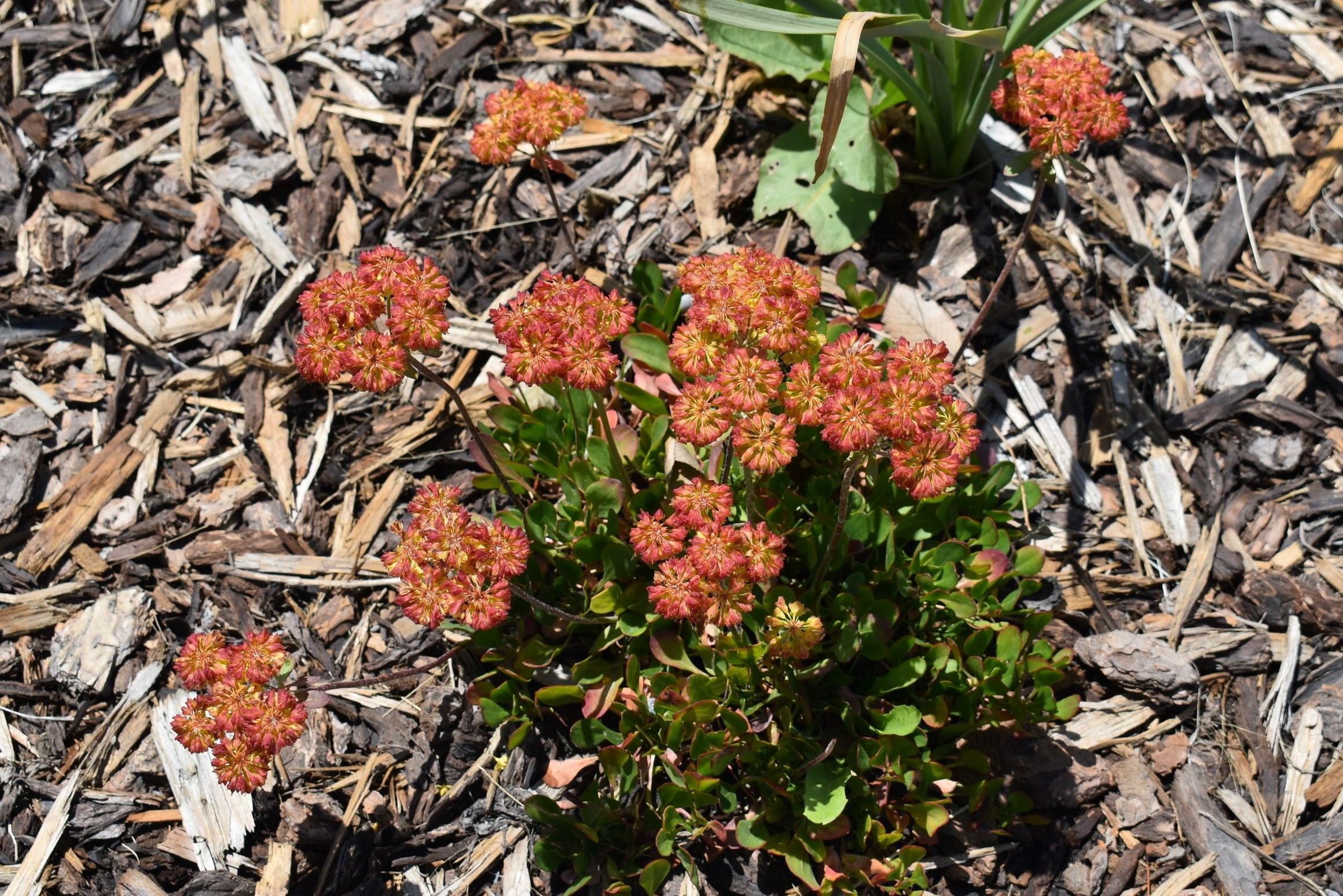
Bicolor Sulfur-flowered Buckwheat Eriogonum umbellatum var. dichrocephalum
This evergreen perennial spreads into a mat of small glossy leaves and produces fluffy yellow clusters of flowers that become copper-red tinted with age. Begins flowering in early summer and continues until the fall. The leaves turn burgundy and remain attractive through the winter. Prefers moderate to dry well-drained soil. Do not overwater.
-

Big Berta White Spruce Picea glauca 'Big Berta'
This hardy Spruce has long needles with an upright and narrow habit. Big Berta has a faster growth rate than other Spruces which results in more open branching.
-
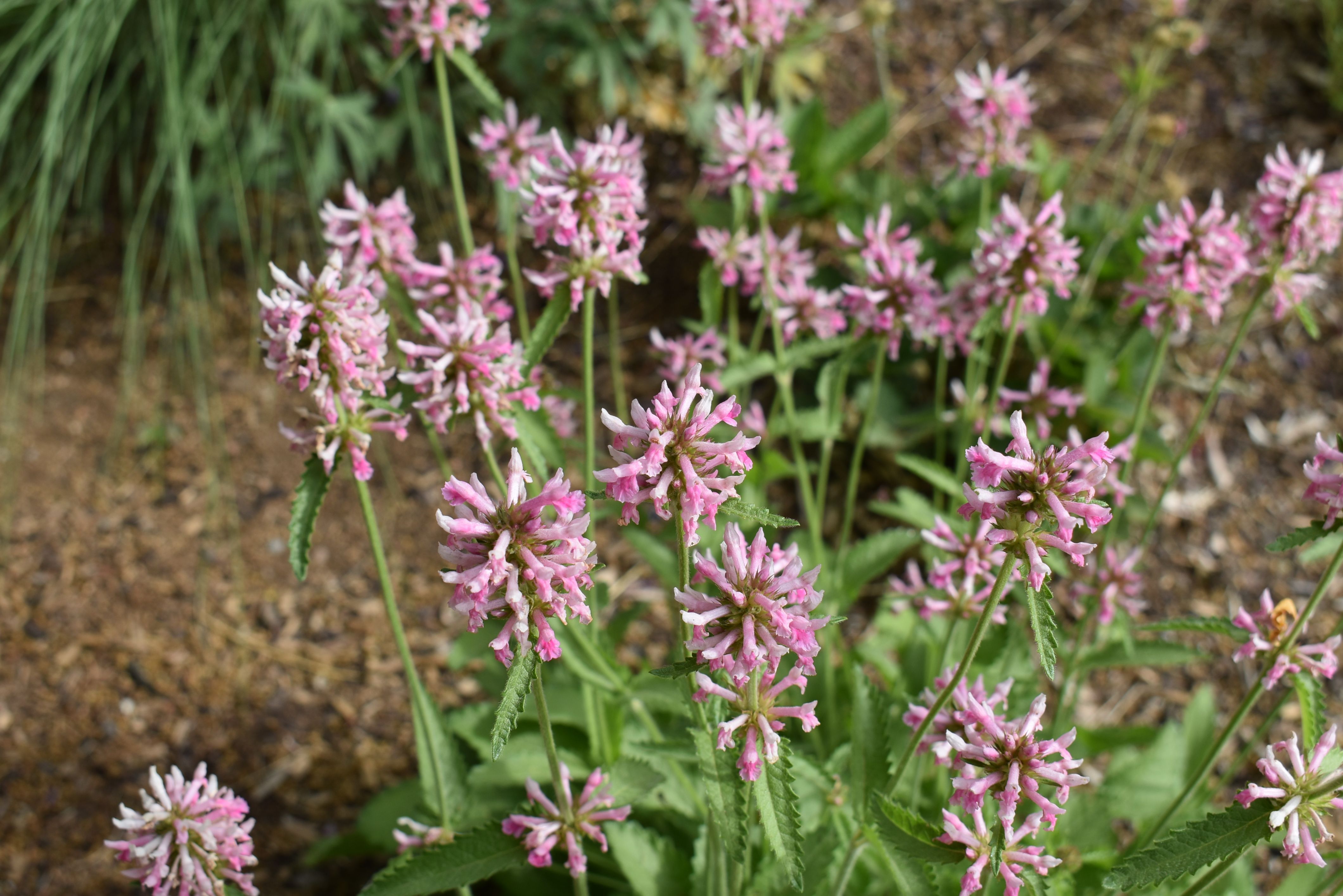
Big Betony Stachys macrantha
Upright-growing, hairy perennial. Broad, scalloped, green leaves are deeply veined. Hooded purple flowers grow in spikes on tall stems. Grows best in moderately fertile, well-drained soils. Reguires moderate amounts of water. Avoid excessive moisture during the winter months.
-
Big Leaf Variegated Periwinkle Vinca major 'Variegata'
An evergreen groundcover with cream and green variegated leaves. Two-inch purple flowers bloom sporadically throughout the summer. Long, trailing stems root as they spread, forming a mat that prevents weeds and fills in large areas in sun or shade. Can handle unfavorable sites where other plants have failed.
-
Big Sagebrush Artemisia tridentata
Medium to large shrub common to Utah and the Intermountain West. Small blue-gray leaves are characterized by three lobes on the tips. Flowers are small and very inconspicuous. Very tolerant of many soil types. Overwatering can cause excessive growth.
-

Big Sky Summer Sky Coneflower Echinacea 'Katie Saul'
This is a hybrid coneflower that was developed by ItSaul Plants®. This perennial has multiple, upright-growing stems that produce large (up to 5 inch in diameter) salmon-peach to rose flowers throughout the summer. Prefers full sun and can survive with moderate to low amounts of water.
-

Big Sky Sundown Coneflower Echinacea 'Evan Saul'
New hybrid coneflower from ItSaul Plants® with deep orange colored flowers with slender petals and orange centers. Dark green leaves are lance-shaped and forms mounds. Makes an excellent cut flower. Attracts butterflies and other wildlife. Once established it can handle short periods of drought but performs best with moderate water.
-

Big Sky Sunrise Coneflower Echinacea 'Sunrise'
New hybrid coneflower from ItSaul Plants® with yellow colored flowers with slender petals and orange centers. Dark green leaves are lance-shaped and forms mounds. Makes an excellent cut flower. Attracts butterflies and other wildlife. Once established it can handle short periods of drought but performs best with moderate water.
-
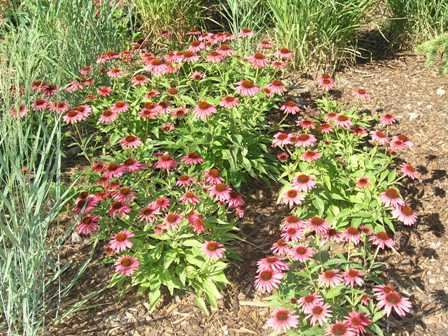
Big Sky Twilight Coneflower Echinacea 'Twilight'
New hybrid coneflower from ItSaul Plants® with rosy-red colored flowers with slender petals and dark red centers. Dark green leaves are lance-shaped and forms mounds. Makes an excellent cut flower. Attracts butterflies and other wildlife. Once established it can handle short periods of drought but performs best with moderate water.
-
Big Tuna Mugo Pine Pinus mugo 'Big Tuna'
Medium to large rounded to spreading evergreen shrub. Spreading branches are scaly and gray. Dark green needles are born in pairs up to three inches long. Bears dark brown female cones. May require some pruning to shape, simply prune the new growth or "candles." Tolerant of many soil types. Needs well drained soils and fairly drought tolerant.
-

Bigroot Geranium Geranium macrorrhizum
As suggested by the name, this geranium has thicker rhizomes than many other geraniums making it more adaptable to dry soils and difficult climates. It forms spreading clumps and will form a groundcover over time. Its five-petaled flowers are shades of pink, usually on the lighter side.
-

Bigtooth Maple Acer grandidentatum
This deciduous tree native to the Western United States has outstanding fall color varying from red to yellow depending on the climate. It tends to stay relatively small when grown in the Salt Lake valley, although it may grow larger in ideal conditions. It often has multiple stems but can be trained to grow on a single trunk. Requires occasional deep soaking to keep healthy. Subject to winter sunscald on bark and some chlorosis. Avoid Rocky Mountain Glow variety due to inferior performance in Utah.
-
BioBlue Kentucky Bluegrass Mix Poa pratensis (group)
Cool-season turf-grass with attractive blue-green foliage. This variety, distributed by BioGrass Sod Farms, is a mixture of the more drought tolerant varieties. This mix consists of Moonlight, Prosperity, and Moonlight II varieties of Kentucky bluegrass as well as Silver Dollar and Road Runner perennial rye grass.
-
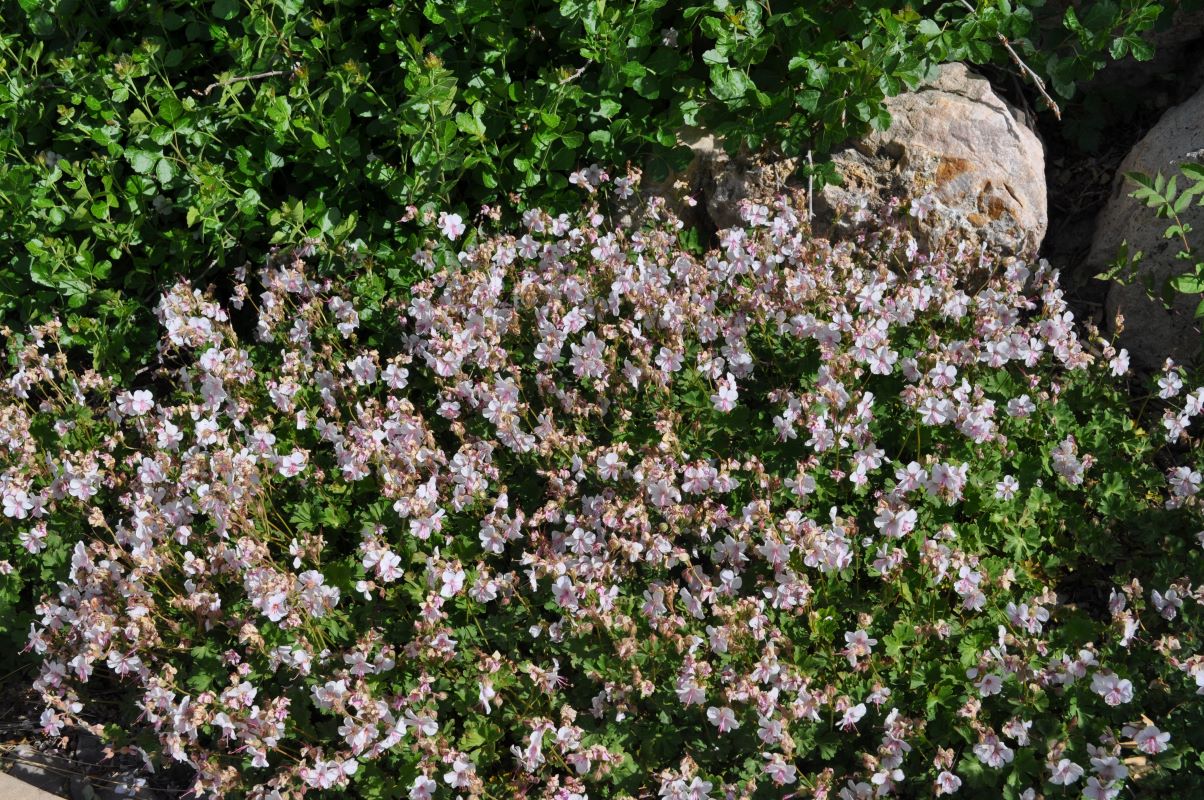
Biokovo Cranesbill Geranium x cantabrigiense 'Biokovo'
Low-growing herbaceous perennial that spreads by rhizomes. Produces masses of white flowers with pink hues at their throats. Under preferrable conditions it can form a dense mat. Dark green foliage is rounded and slightly lobed.
-

BioMeadow Fine Fescue Mix Festuca spp.
A mixture of fine fescue grasses including hard fescue (Festuca brevipila), chewings fescue (Festuca rubra subsp. commutata) and red fescue (Festuca rubra). Fine dark green leaves grow from a crown near the soil. Handles cold temperatures well and can be left unmowed for a meadow appearance. It is reported to require less water and fertilizer than Kentucky bluegrass and performs well in both sun and shade. This particular mix is available through BioGrass Sod Farms.
-
BioNative Wheatgrass Mix Agropyron spp.
A mix of grasses specifically selected to adapt to Utah soils and climate. Species include Critana Thickspike Wheatgrass (Agropyron dasystachym 'Critana'), Fairway Crested Wheatgrass (Agropyron cristatum 'Fairway') and Rosana Western Wheatgrass (Pascopyrum smithii 'Rosana'). Will reach one to three feet tall if left unmowed. Cool season grasses keep a suitable green color throughout the year. Great choice for low-maintenance lawn areas.
-
BioTurf Dwarf Fescue Mix Festuca arundinacea 'Bolero'
Deep rooted, dark green, cool season perennial turf grass. Tolerates some shade, foot traffic and recovers well after drought. Does best in well drained clay soils. Uses less water than Kentucky bluegrass with a similar look. Tall-fescue leaf blades are generally more coarse but this variety was grown for a finer texture. Best kept cut at 3 inches or longer. Improvements are constantly being made in the varieties available commercially. Consult your local sod or seed provider for information on the best varieties available.
-

Birch's Double Cranesbill Geranium himalayense 'Plenum'
Clump forming perennial with mid-green leaves. Purplish-pink flowers are double with shades of blue and resemble tiny roses. Attractive, finely cut leaves are deeply veined. May not be as vigorous as the species. Somewhat tolerant of drought and poor soils but prefers regular water and fertile soils.
-

Bird Cherry Prunus padus
Also called European Birdcherry. Medium to small deciduous tree and close relative of the native Chokecherry. Spring brings pendulous clusters of white flowers followed by small bitter black edible berries that may be better left for the birds. Serrated green leaves turn yellow in the fall. A very adaptable and easy to grow tree.
-

Bird's Nest Spruce Picea abies 'Nidiformis'
A shrubby low-growing variety of Norway Spruce. Forms dense bowl-shaped mounds resembling a bird's nest, hence its name. Needles are dark green and grow up to one-and-a-half inches long. Common choice in traditional landscapes due to its adaptability.
-

Bishop's Hat Epimedium x rubrum
A shade-loving, rhizomatous, clump-forming perennial. It's primarily used as a groundcover in shady areas. The leaves are shaped like a bishop's mitre and hence the common name was coined. Leaves emerged in the spring red-tinged but turn green as they mature. Red and yellow flowers bloom in early spring. This is a good plant for dry shade.
-
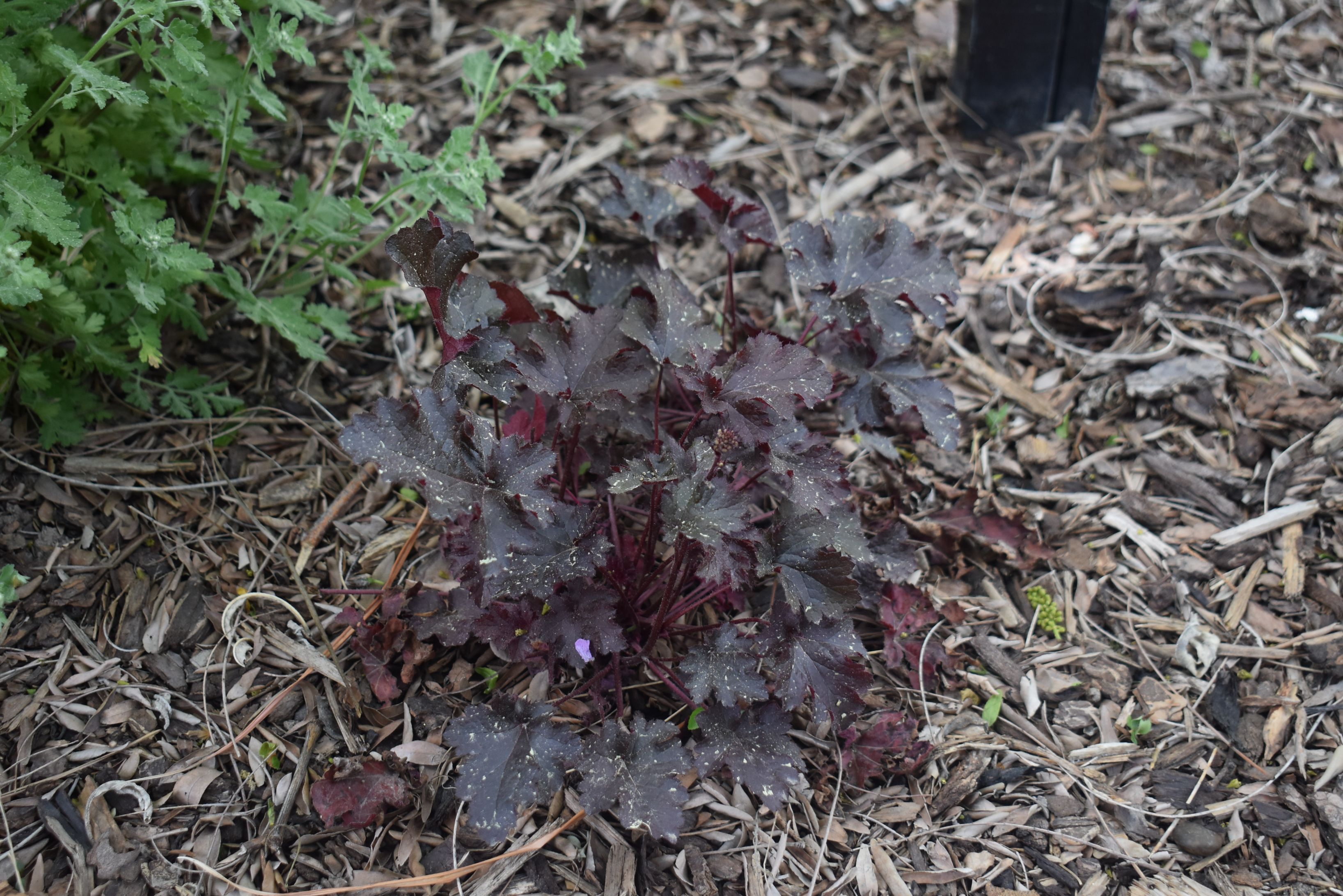
Black Beauty Coral Bells Heuchera 'Black Beauty'
This is a beautiful Heuchera with dark purple, glossy, ruffled semi-evergreen leaves. It has small light pink to white flowers which appear on tall, dark stems in the early summer. These dark, rich colors contrast well with variegated, gray-green and golden foliage plants. This plant can be evergreen, but in harsh winters it might die back and come up from the roots the next year.
-

Black Beauty Elderberry Sambucus nigra 'Gerda'
Medium to large deciduous shrub with purple leaves. A cultivar of the European Elderberry. Pinkish-white flowers appear in early summer turning to black fruit. Flowers are lemon scented. Berries are edible and very attractive to wildlife. Have been used to make jams, jellies, and wine. Fruit is not considered as useful as that of the American Elderberry. Leaves and stems are considered mildly toxic.
-
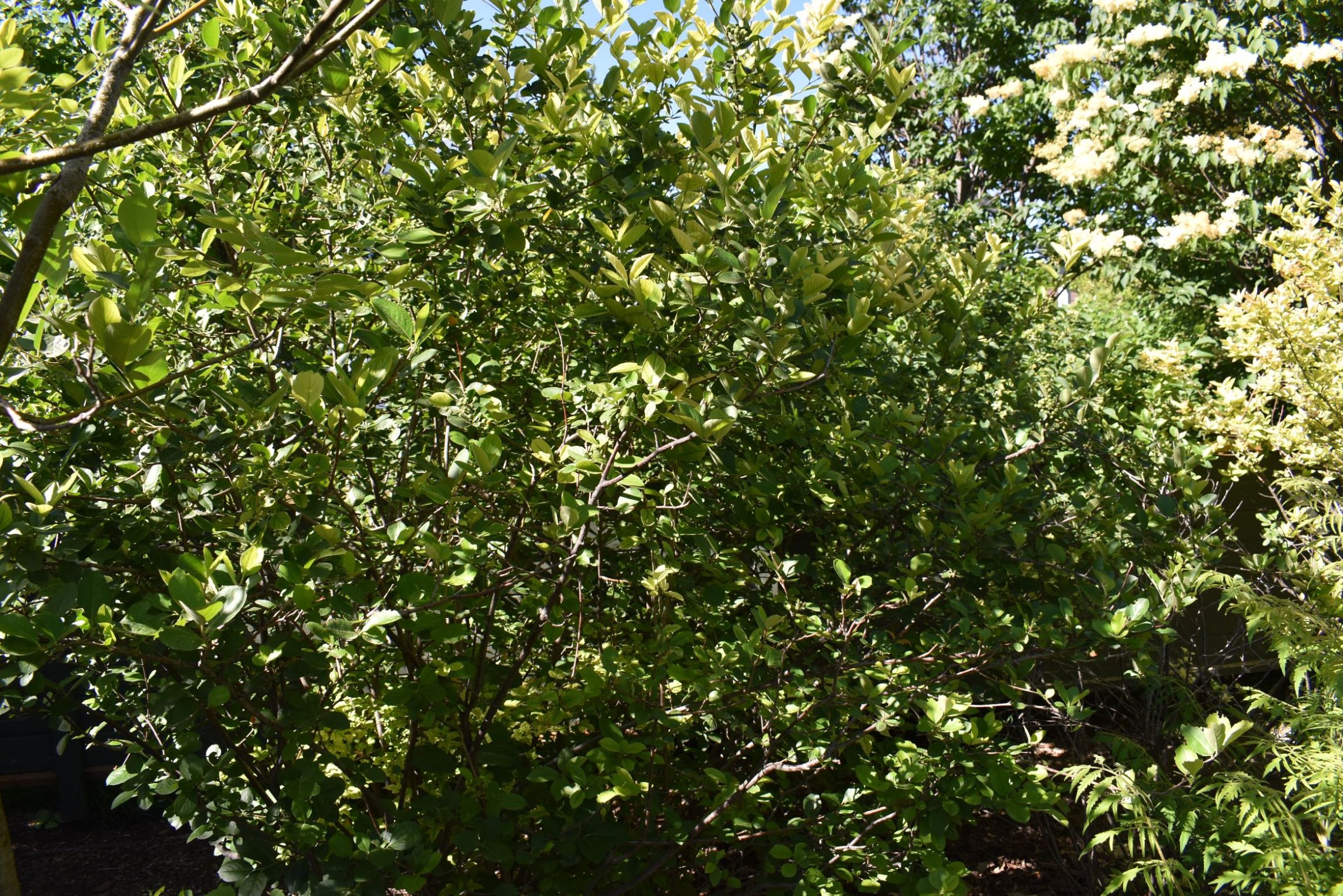
Black Chokeberry Aronia melanocarpa var. elata
Upright, multi-stemmed shrub native to the eastern United States. Dark-green glossy leaves turn wine-red in winter. Clusters of small white flowers bloom in May and are followed by black astringent berries. Berries are edible and have been used to make jams and jellies, but are best left to the wildlife. Tolerates a wide range of soil types.
-
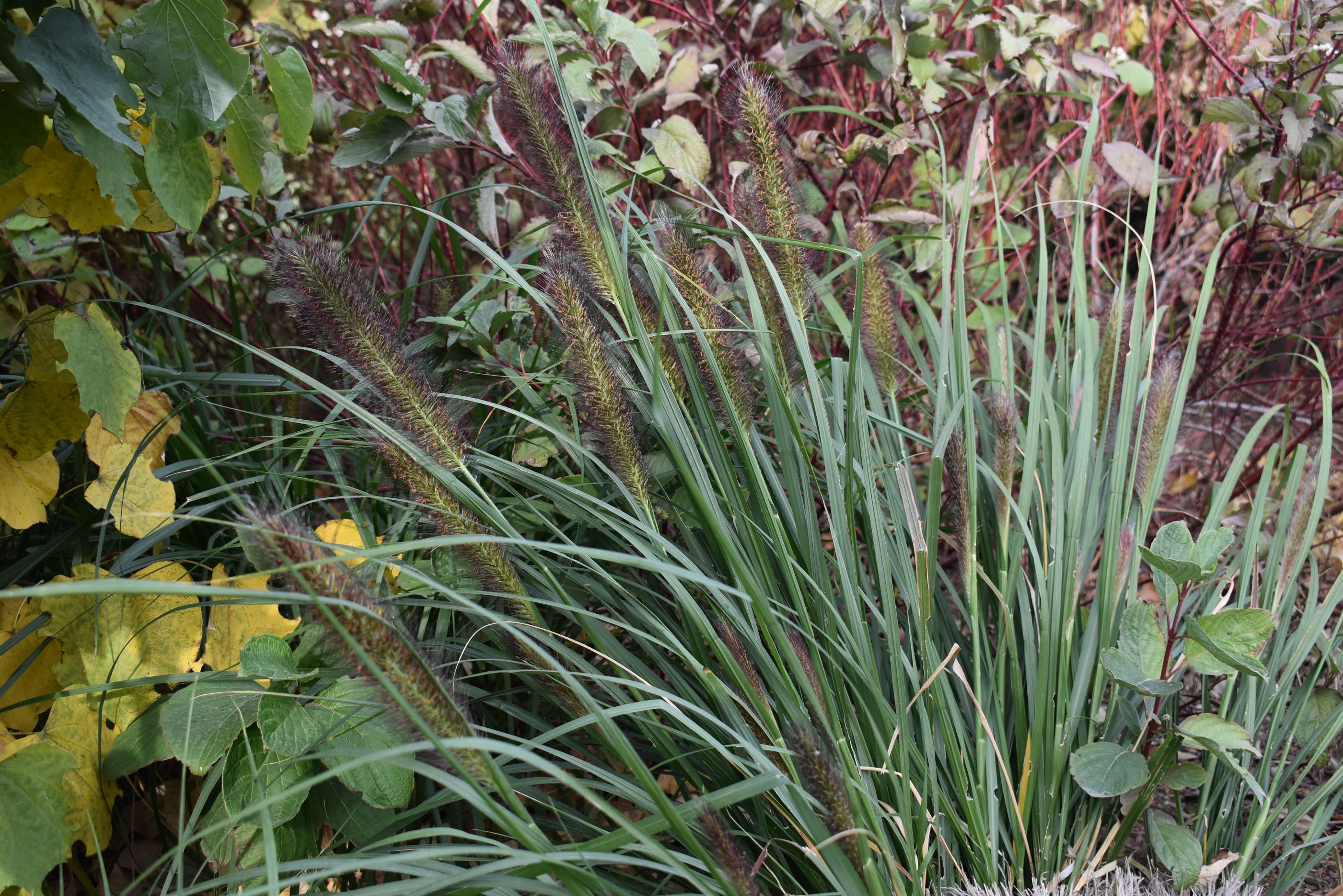
Black Flowering Fountain Grass Pennisetum alopecuroides 'Moudry'
Dense, clump-forming, perennial grass with foxtail-like inflorescenses. Has narrow, mid-green leaves up to half an inch wide. Tiny creamy-white flowers are begin blooming in June. Very attractive foxtails last into fall. Prefers full sun. Moderately drought tolerant. Shorter than average species height.
-
Black Hills Spruce Picea glauca 'Densata'
A slower-growing drought tolerant variety of white spruce. Very dense growth makes it good for wind screens. Bright green foliage turns to bluish-green with age. Makes a great accent plant.
-

Black Knight Butterfly Bush Buddleja davidii 'Black Knight'
Beautiful medium to large shrub flowering shrub. Can be pruned back to desired height each year, even to the ground if desired. Once established, this plant is tolerant of many conditions. Attracts butterflies and bees. This variety is hardier than most and develops extremely dark purple flowers in long panicles.
-
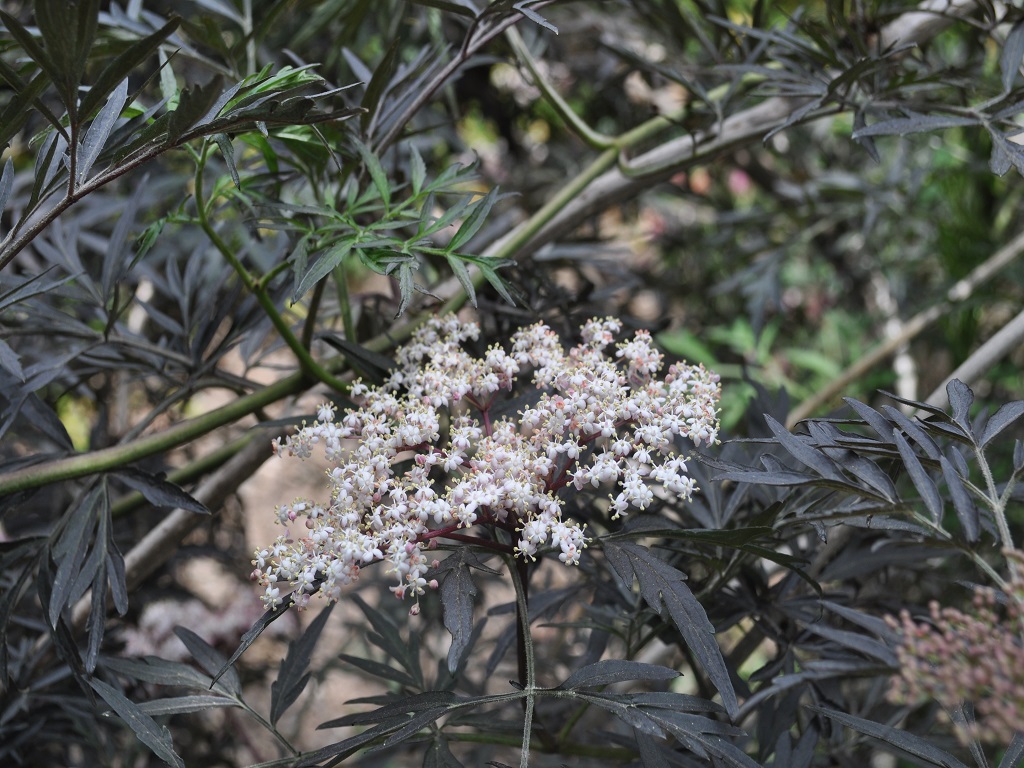
Black Lace Elderberry Sambucus nigra 'Eva'
Dark lacy leaves characterize this cultivar of the European elderberry. Pink, lemon scented flowers in the spring to early-summer add to it's beauty. This shrub is an excellent replacement for the Japanese maple as it is more suited to the Utah landscape. It does produce berries that, while edible when cooked, are not as useful for jams and jellies as the American elderberry.
-

Black Mondo Grass Ophiopogon planiscapus 'Nigrescens'
These slender, jet-black leaves will be a standout in the garden. This is a unique grass-like specimen for borders or rock gardens in partially shaded areas. It grows in arching clumps with pale purple-pink bell-shaped flowers which bloom in the summer.
-
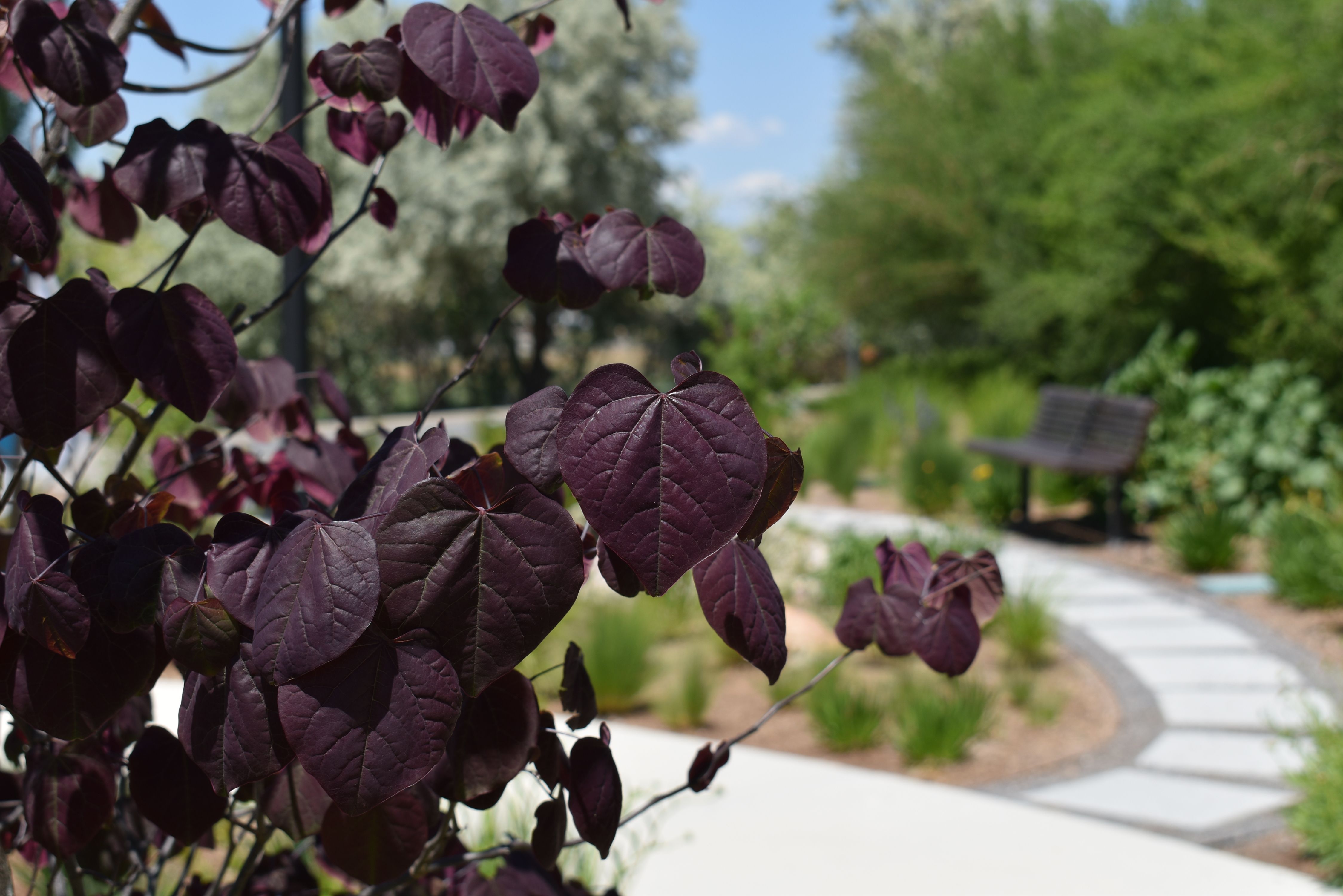
Black Pearl Eastern Redbud Cercis canadensis 'JN16'
A unique cultivar of a classic American tree, with glossy, eggplant-purple leaves that appear almost black. In early spring, vivid pink-purple flowers coat the length of the bare branches. Its graceful open shape is well suited to woodland borders, and its striking color makes it an eye-catching focal specimen.
-

Black Sagebrush Artemisia nova
Evergreen, woody shrub native to the western United States. Elongated leaves with 3-lobed tips are more gray than green. Similar in appearance to A. tridentata except for more compact form. Inconspicuous yellow flowers bloom during the summer. Bark is colored black. Plant in well-drained soils and do not overwater. Works will in informal dry landscape areas.
-
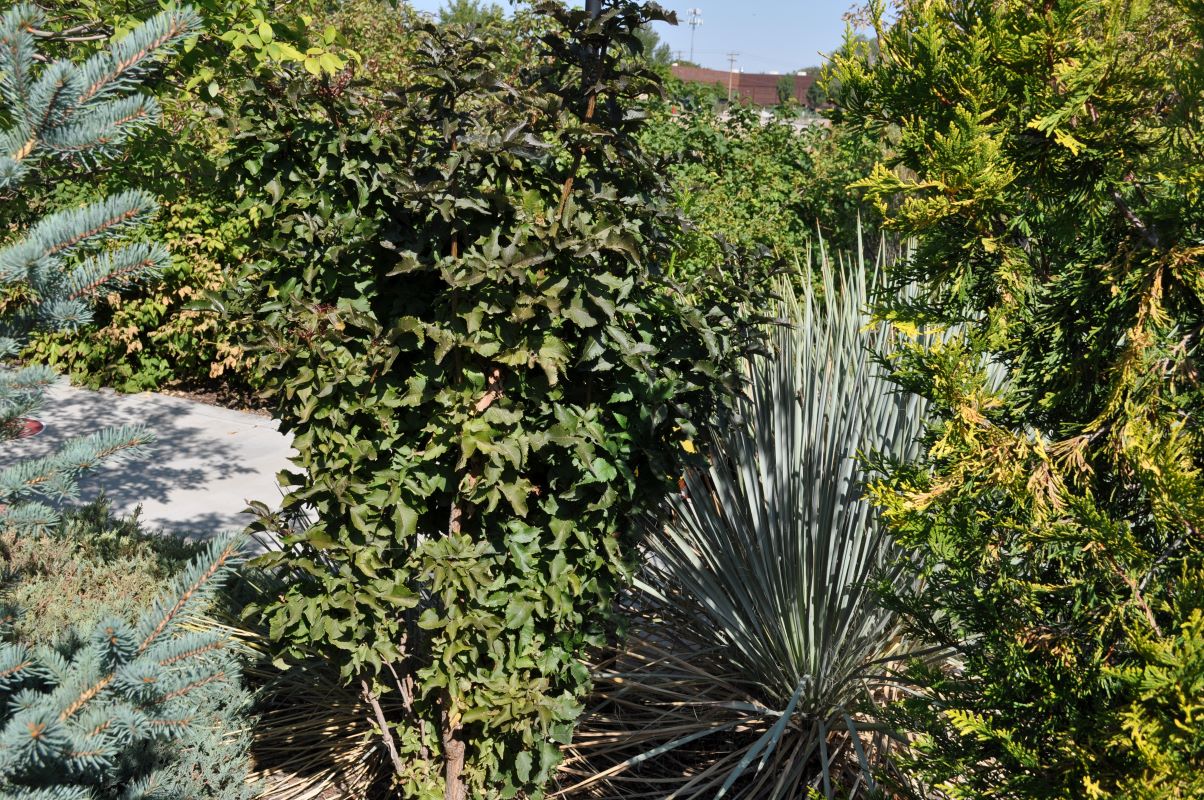
Black Tower Elderberry Sambucus nigra 'EIFFEL 1'
The dramatic deep burgundy foliage makes this upright deciduous shrub a statement in any garden. Bright pink flowers stand out against the dark leaves. Spring flowers turn to blackish berries in the fall. If flowers are not deadheaded berries can be harvested for wine and jam or left for wildlife to enjoy.
-
Black Walnut Juglans nigra
Large deciduous tree valued for its hard wood. Nuts are edible and can be messy when they fall. Black walnuts produce a natural growth inhibitor that can cause plants beneath it to grow slowly or die. Usually best planted in large open areas such as parks. May drop its leaves in extreme drought situations.
-

Blackhawks Big Bluestem Andropogon gerardii 'Blackhawks'
This upright native ornamental grass is a colorful accent plant for any landscape. It has slender leaves that begin dark green and turn purple when nights start to cool down. The foliage will be nearly black by mid-fall. Late summer brings beautiful purple-red, flowering stems that rise high above the foliage and are 3-pronged like turkey feet.
-
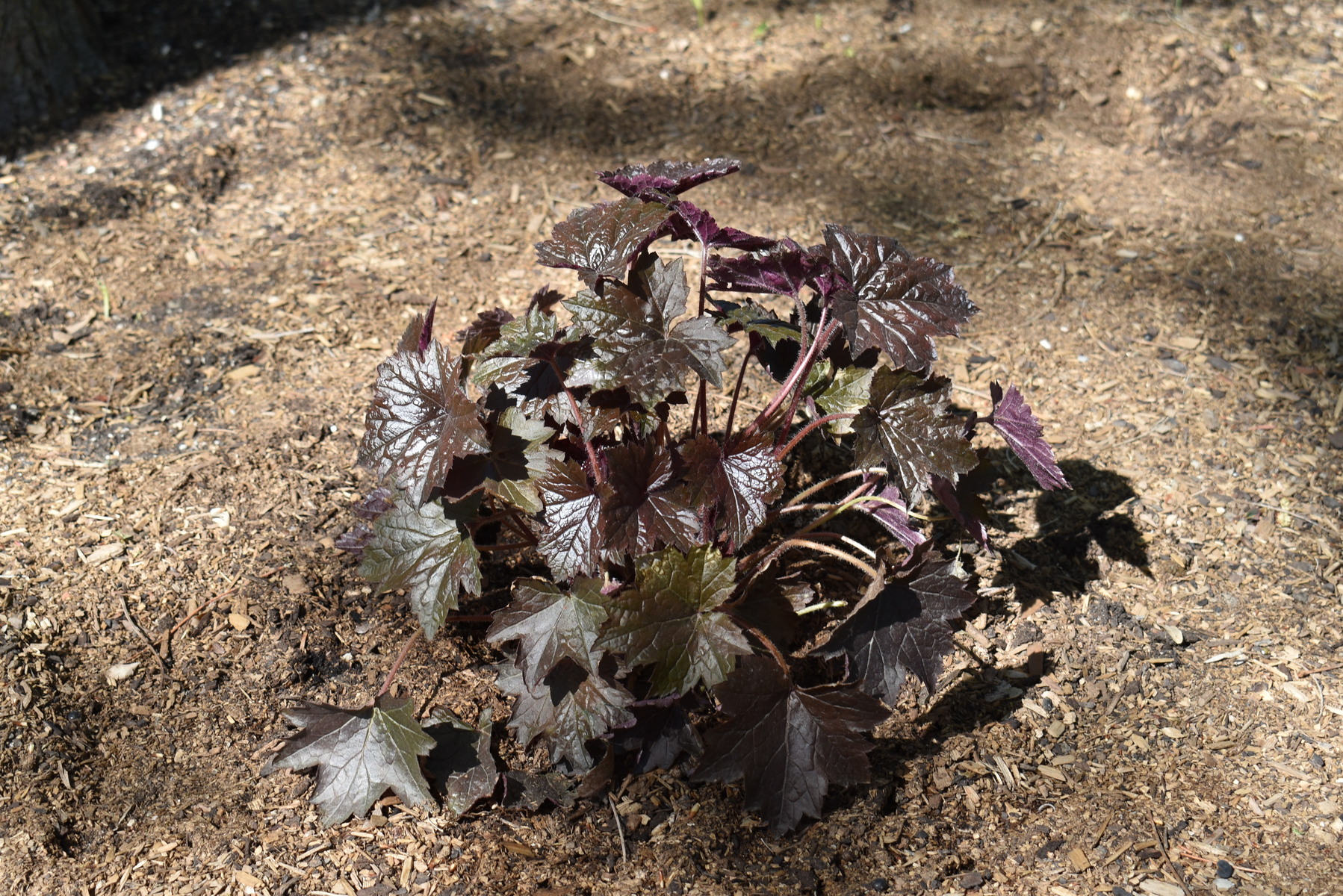
Blackout Coral Bells Heuchera villosa 'Blackout'
This coral bell was given the name “Blackout” for its densely packed, glossy, nearly black leaves. The foliage retains its attractive dark purple foliage throughout the growing season. Summertime brings creamy white blossoms that open into airy, dainty panicles atop long, slender stems. They stand out against the rich foliage beneath.
-
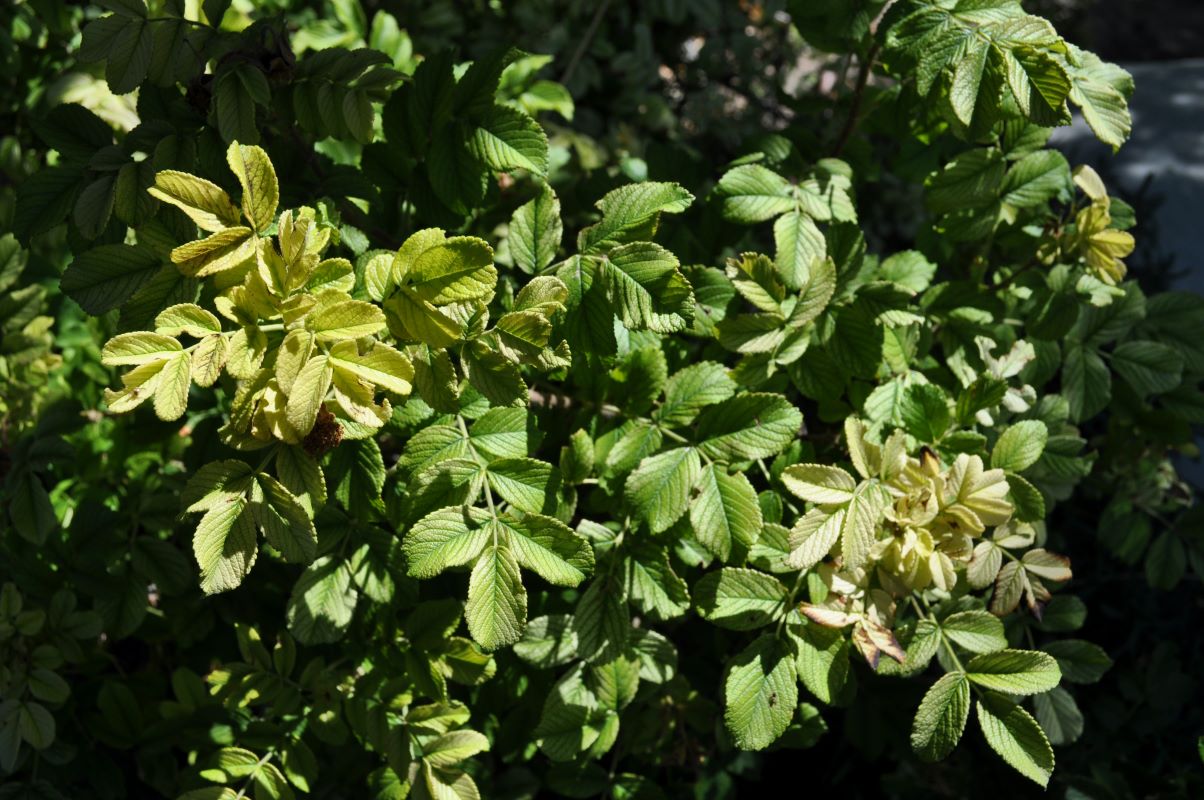
Blanc Double de Coubert Rose Rosa 'Blanc Double de Coubert'
This beautiful, fragrant rose is a long-blooming, disease resistant option that thrives in full sun and has some shade tolerance. Attractive deep green foliage provides a nice contrast to the large, beautiful, semi-double pure white flowers. This plant prefers moderately moist, loamy soil with regular, deep watering’s. If cared for properly, it can continue blooming all summer long and up until the first frost.
-
Blaze Little Bluestem Schizachyrium scoparium 'Blaze'
This tall, upright ornamental grass will add colorful interest to the landscape. The slender grass blades start off light blue in spring, darken to gray-green in summer and eventually burst with deep reds in the fall. The reds fade into vivid pinks as winter approaches. Summer also bring reddish-brown flowers that sit high above the foliage. They turn into feathery, silver-white seed heads that can persist through winter. Grows in clumps up to eighteen inches across. Grows well in many soil including alkaline and clay. Requires little water once established.
-
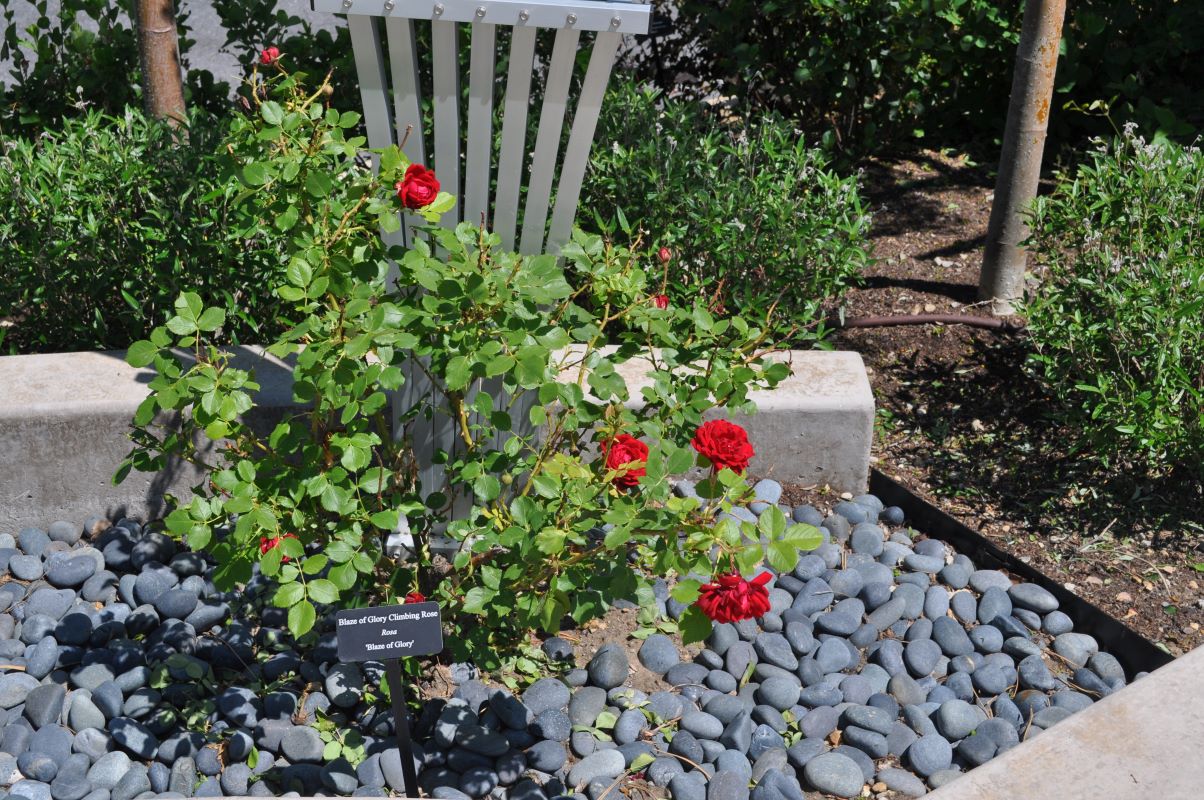
Blaze of Glory Climbing Rose Rosa 'Blaze of Glory'
Showy and lightly fragrant, this fiery orange and coral-colored climbing rose is an excellent option for adding brilliant summer color to any full-sun landscape. This climbing rose is a good candidate for growing up fences, pillars or arbors. It prefers moderately moist, well-drained soil, and is disease resistant.
-

Blazing Star Liatris spicata
Upright clump-forming perennial that is attractive to bees and butterflies. Spikes of pink-purple flowers appear in the summer opening from the top downwards. Multiple stalks arise from basal tufts of narrow leaves. Will tolerate some drought and poor soils but prefers moderate amounts of water in fertile soils. Requires full sun. Makes excellent cut flowers.
-
Blireana Plum Prunus x blireana
A cross between Cherry Plum (Prunus cerasifera 'Pissardii') and Japanese Apricot (Prunus mume). This small deciduous tree produces a multitude of double, pink, fragrant flowers in early spring. Long slender branches are covered with dark-purple leaves that turn greenish-purple in the summer. This hybrid is sterile and does not produce fruit. Prefers moderate moisture but tolerates some drought.
-

Blizzard Mock Orange Philadelphus lewisii 'Blizzard'
Multi-stemmed deciduous shrub developed in Alberta, Canada. Selected for its exceptional cold-hardiness and profuse, large, white flowers. Flowers are single with 4-6 petals and very fragrant. Blooms begin in spring and last up to 4 weeks. Tolerates some shade but produces more flowers in full sun. Requires low to moderate amounts of water.
-

Blizzard Pearl Bush Exochorda 'Blizzard'
This shrub has an upright, rounded form. It has a brilliant show of white, frilly flowers that bloom in the spring. This plant is adaptable to most soils, but does prefer good drainage.
-

Blonde Ambition Blue Grama Grass Bouteloua gracilis 'Blonde Ambition'
Introduced by David Salman of High Country Gardens, this surprising selection of blue grama boasts chartreuse seed heads held horizontally above the blue green foliage, creating a lovely contrast. Provides great winter interest if left uncut. Requires little care and is adapted to Utah conditions.
-

Bloody Cranesbill Geranium sanguineum
Low-growing, compact, clump-forming perennial. Dark green leaves are deeply toothed and smaller than other geraniums. Rose-pink to purple flowers mainly bloom in spring but reappear to a lesser degree throughout the year. Will tolerate some drought. Prune to keep it to a desirable size.
-
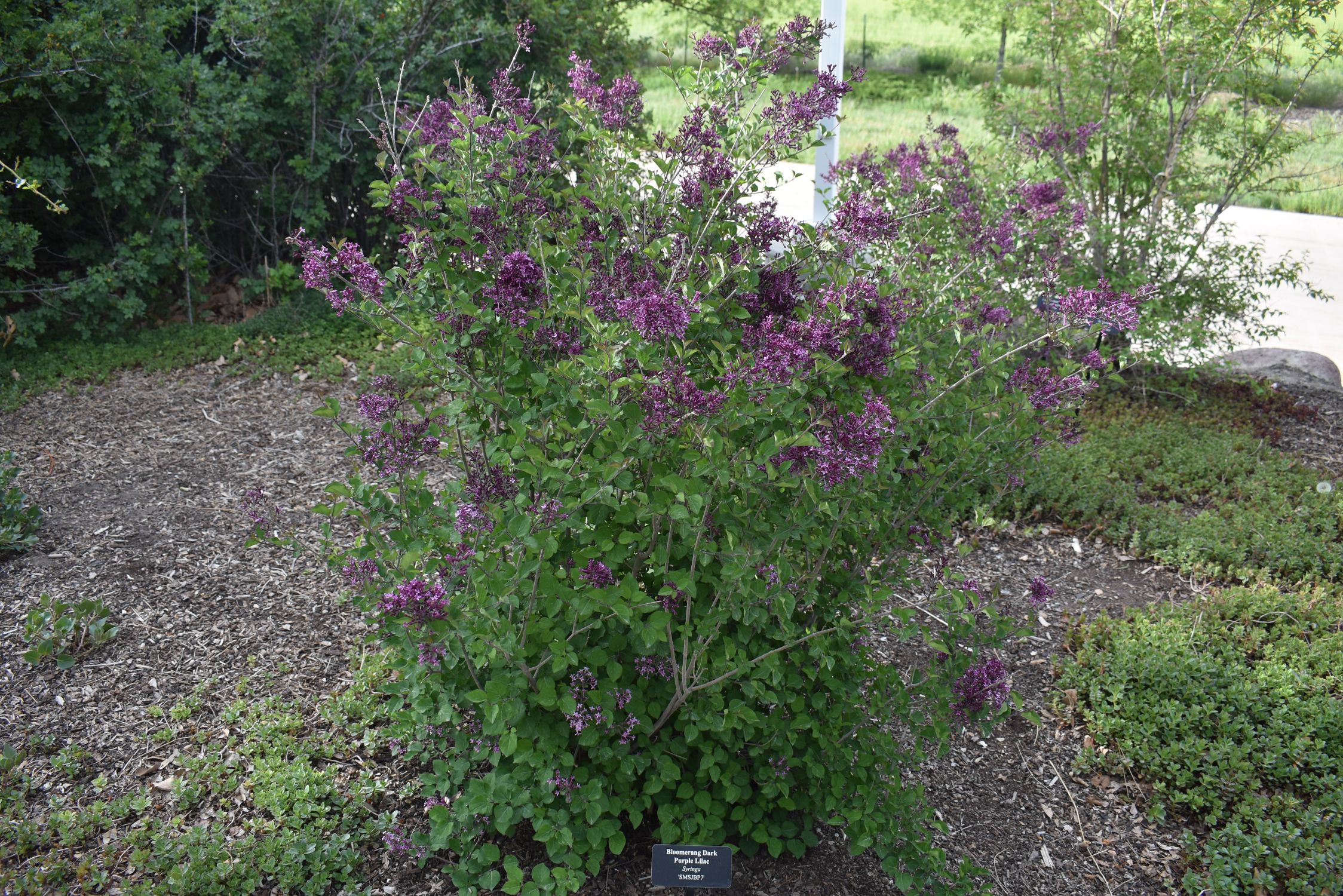
Bloomerang Dark Purple Lilac Syringa 'SMSJBP7'
A reblooming hybrid lilac with dark purple flowers in mid spring and again in late summer. The lilacs in the Bloomerang series are extremely disease resistant and enjoy full sun, making them an easy-care choice. Pruning should only be done after the spring flush of blooms, and only if desired. The second bloom occurs on new growth after the spring bloom.
-
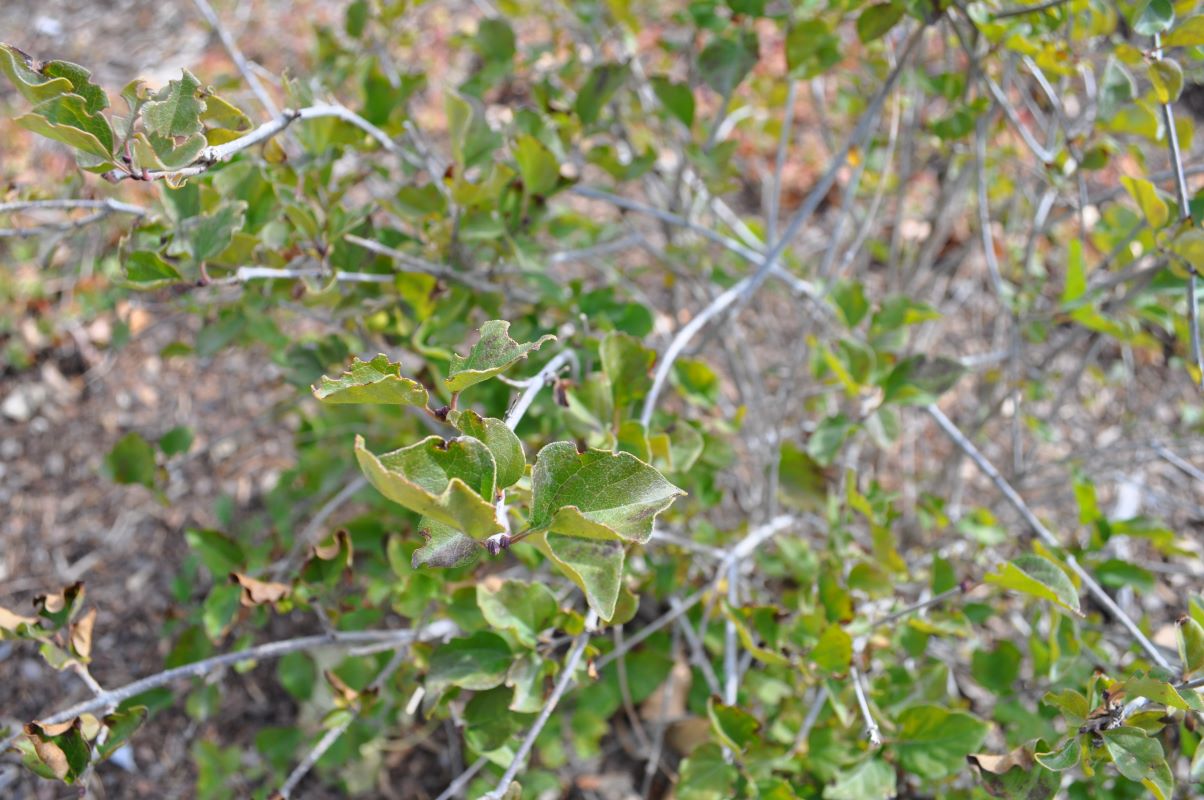
Bloomerang Pink Perfume Lilac Syringa 'Pink Perfume'
This is a reblooming lilac with fragrant pink flowers that bloom in mid spring and again in late summer. The lilacs in the Bloomerang series are extremely disease resistant and enjoy full sun, making them an easy-care choice. Pruning should only be done after the spring flush of blooms, if desired. Second bloom occurs on new growth after the spring flush.
-

Bloomerang Purple Lilac Syringa 'Penda'
A deciduous flowering shrub with clusters of purple flowers that first appear in spring, but unlike most lilacs, reblooms again in summer lasting into fall. This hybrid lilac is a compact form.
-
Blue Angel Hosta Hosta 'Blue Angel'
A hardy perennial that grows in large mounds of thick, rough, wide, oval shaped leaves. The noticeable ribbed veins create additional texture. These leaves come in an attractive shade of blue-green and will bring out the best blue color in light shade. In mid-summer, tall, slender stems rise above the foliage and the tops are covered in dainty, bell-shaped blossoms that come in pale lavender to pure white.
-
Blue Arrow Juniper Juniperus scopulorum 'Blue Arrow'
Slow-growing evergreen tree with a narrow upright habit. Perfect where space is limited or as a tall screen. Has scale-like needles with attractive blue-green foliage. Reddish-brown bark peels off in long strips. Requires full sun and will tolerate alkaline soils and drought.
-
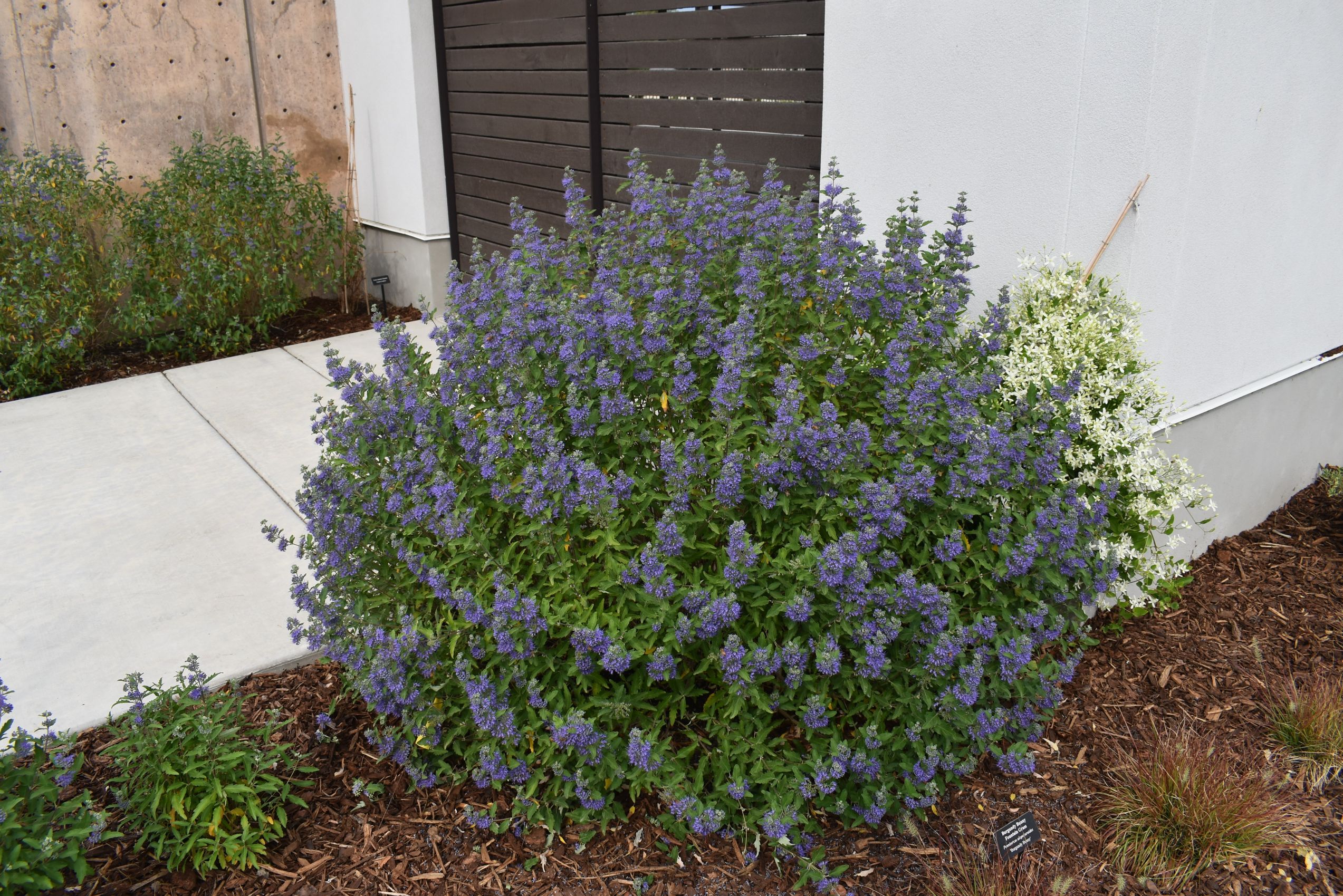
Blue Balloon Bluebeard Caryopteris x clandonensis 'Korball'
This medium sized shrub is best treated as a perennial along the Wasatch Front. Cut back in the fall or early spring to promote fresh new growth each year. Prefers drier soils and full sun. Produces small blue flowers clustered together along each long stem. This variety has a spherical habit, from which "balloon" in the common name is derived. Dark green foliage has a silvery underside. It's fast growing and fragrant.
-
Blue Beaked Yucca Yucca rostrata
This yucca is usually single trunked and has a treelike habit. The blue-green foliage is evergreen and forms a pom-pom shape on top of the trunk. The narrow foliage is about 2 feet long and has sharp tips. It has beautiful white, bell shaped flowers. It requires very little water.
-

Blue Bell Bellflower Campanula persicifolia 'Blue Bell'
Strong growing, compact, small mounding plant with leafy base. The foliage is shaped similar to that of a small peach tree. Blue cup shaped flowers bloom in summer. Choice plant for borders.
-
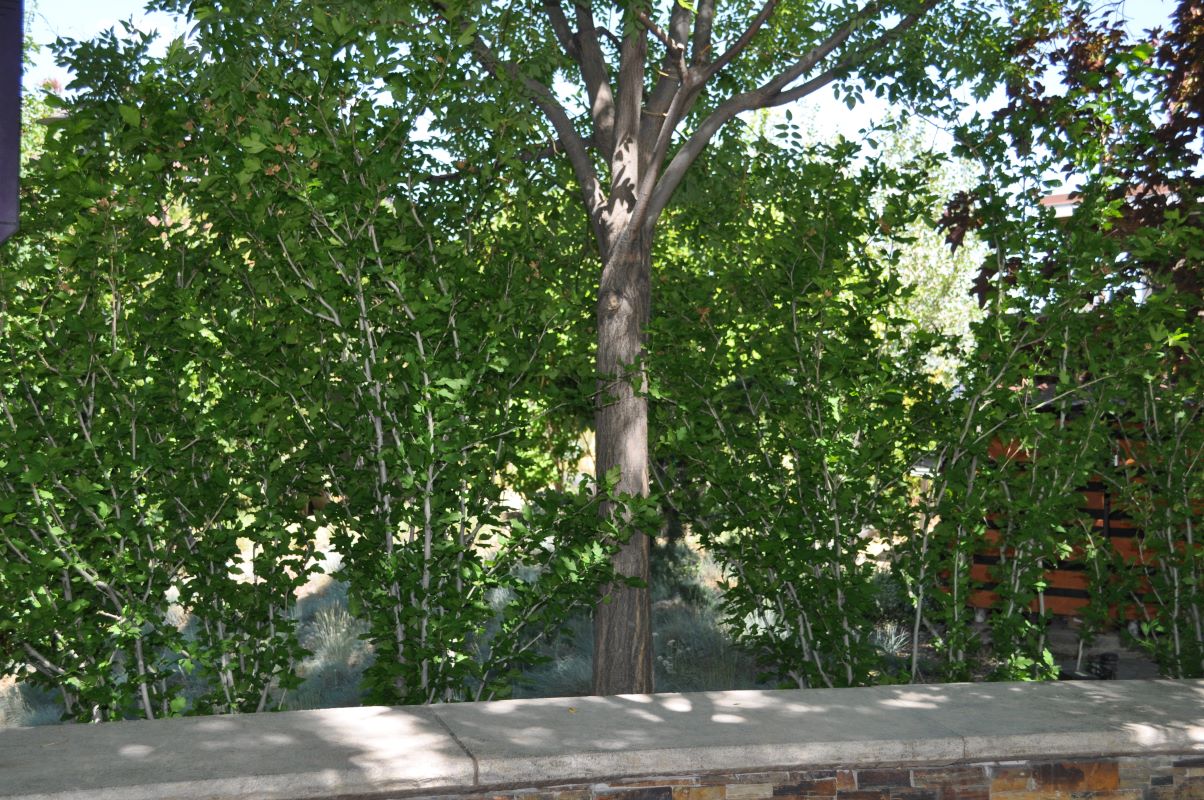
Blue Bird Rose of Sharon Hibiscus syriacus 'Blue Bird'
Vigorous, multi-stemmed, upright, deciduous flowering shrub. Numerous showy, violet-blue, 5-petaled flowers with purple eyes are borne throughout the summer. Attractive 3-lobed, coarsely toothed leaves grow on erect stems. Tolerant of heat, drought, and poor soils. Prefers fertile soils with moderate amounts of water.
-
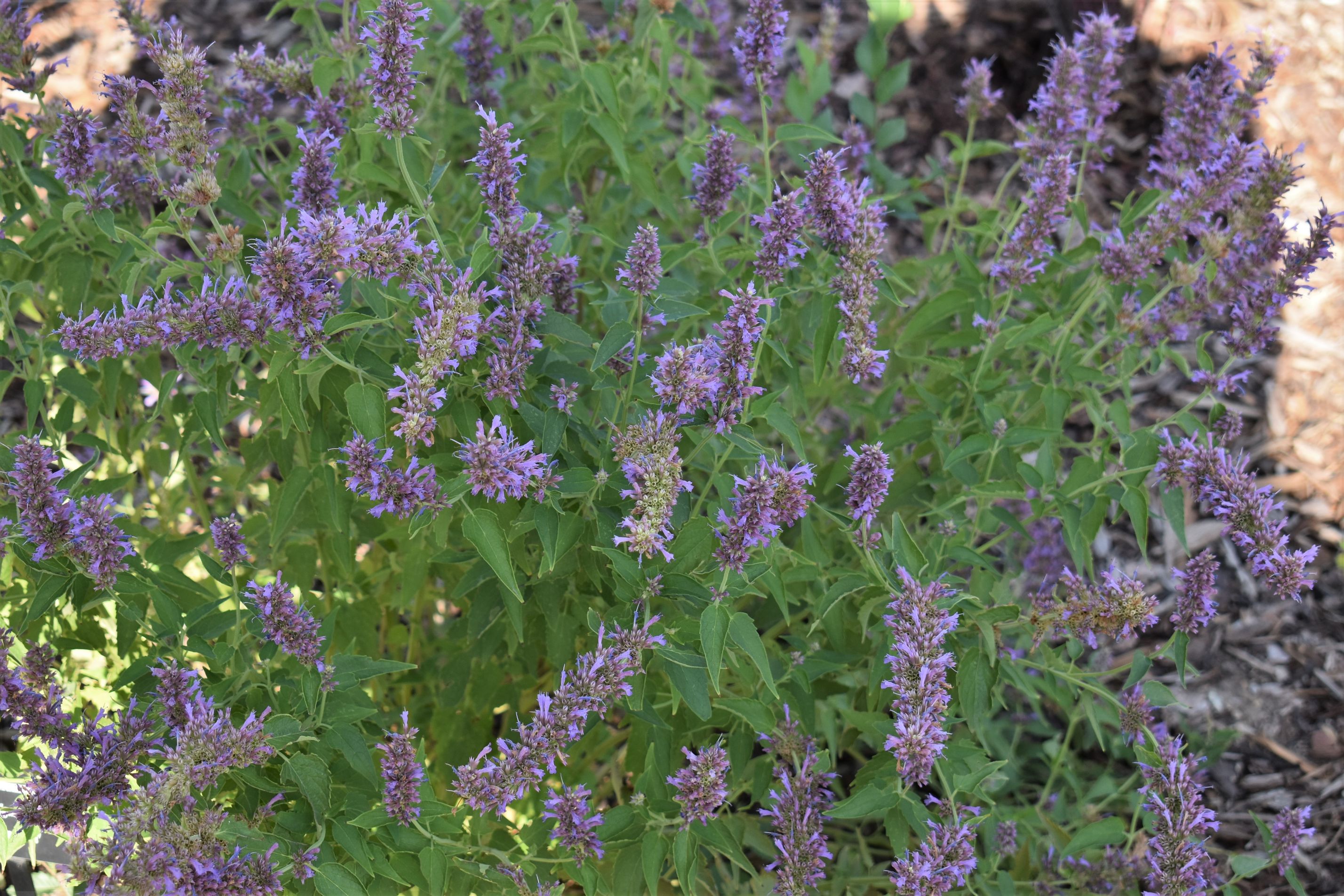
Blue Boa Hyssop Agastache 'Blue Boa'
This is a showy, low-maintenance, clumping perennial. It provides a brilliant show of deep, violet-blue flowers which bloom June-September. Flower spikes bloom above the aromatic, green foliage. Well-drained soils are preferred.
-

Blue Bouquet Speedwell Veronica spicata 'Blue Bouquet'
Clump-forming perennial with ascending, tapered spikes dark violet blossoms during early summer. Dark green leaves are lance-shaped and grow on short stems Prefers full sun and well drained soil. A great cut flower. Attracts bees and butterflies.
-
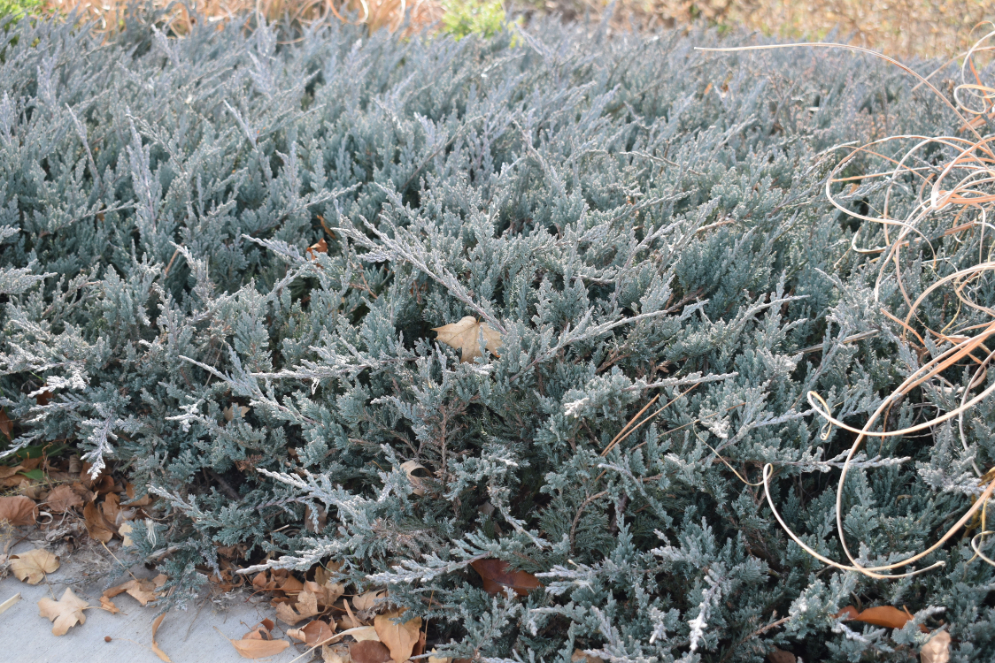
Blue Chip Juniper Juniperus horizontalis 'Blue Chip'
Low-growing evergreen shrub with steel-blue foliage that turns purplish in the winter. Forms a dense mat that keeps out weeds and minimizes maintenance. This cultivar does not flower or set fruit. This is a fairly adaptable plant that thrives in hot, dry sites. Prefers sandy soils and does not tolerate wet soil.
-
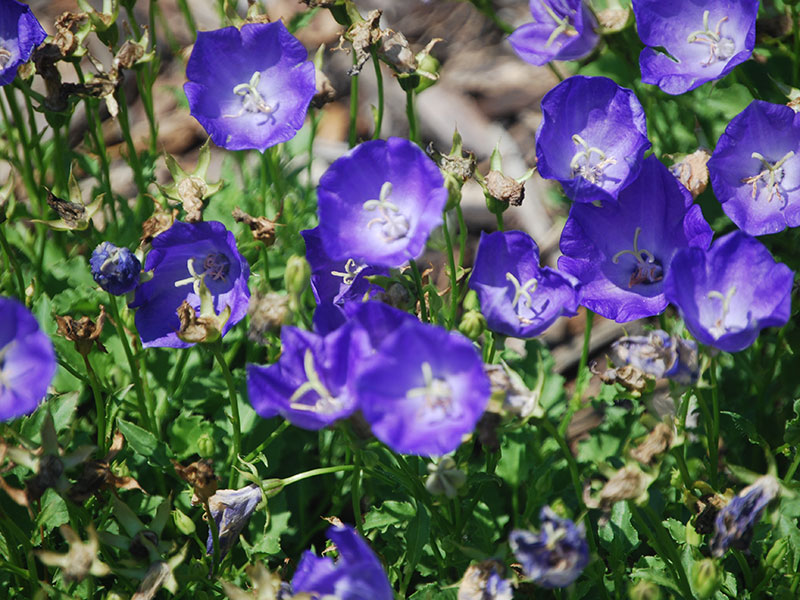
Blue Clips Bellflower Campanula carpatica 'Blue Clips'
Low-growing herbaceous perennial. Violet-blue bell shaped flowers grow profusely in mid to late-spring. Forms a mass of small dark-green leaves that stay compact and mounded. Prefers moderate amounts of water and organic soils. Use mulch to keep the soil cool. Needs moderate watering during the heat of the summer.
-

Blue Diddley Chastetree Vitex agnus-castus 'SMVACBD'
Although referred to as a tree within its name, it acts as a rounded, dwarf shrub with slender, green foliage that can have a slight silver sheen to it. Spikes full of lavender-blue blossoms contrast beautifully with the foliage throughout summer. Blue Diddley Chaste Tree is a colorful addition to perennial planting beds and mixed borders.
-

Blue Dwarf Sea Holly Eryngium planum 'Blauer Zwerg'
Clump-forming, herbaceous perennial with tall clusters of unique, spiky blue flowers. Leathery, blue-green, spiny leaves grow from basal rosettes and also on upright-growing stems. Plant in well-drained soils. Prefers moderately fertile to poor soils. Protect from excessive winter moisture.
-
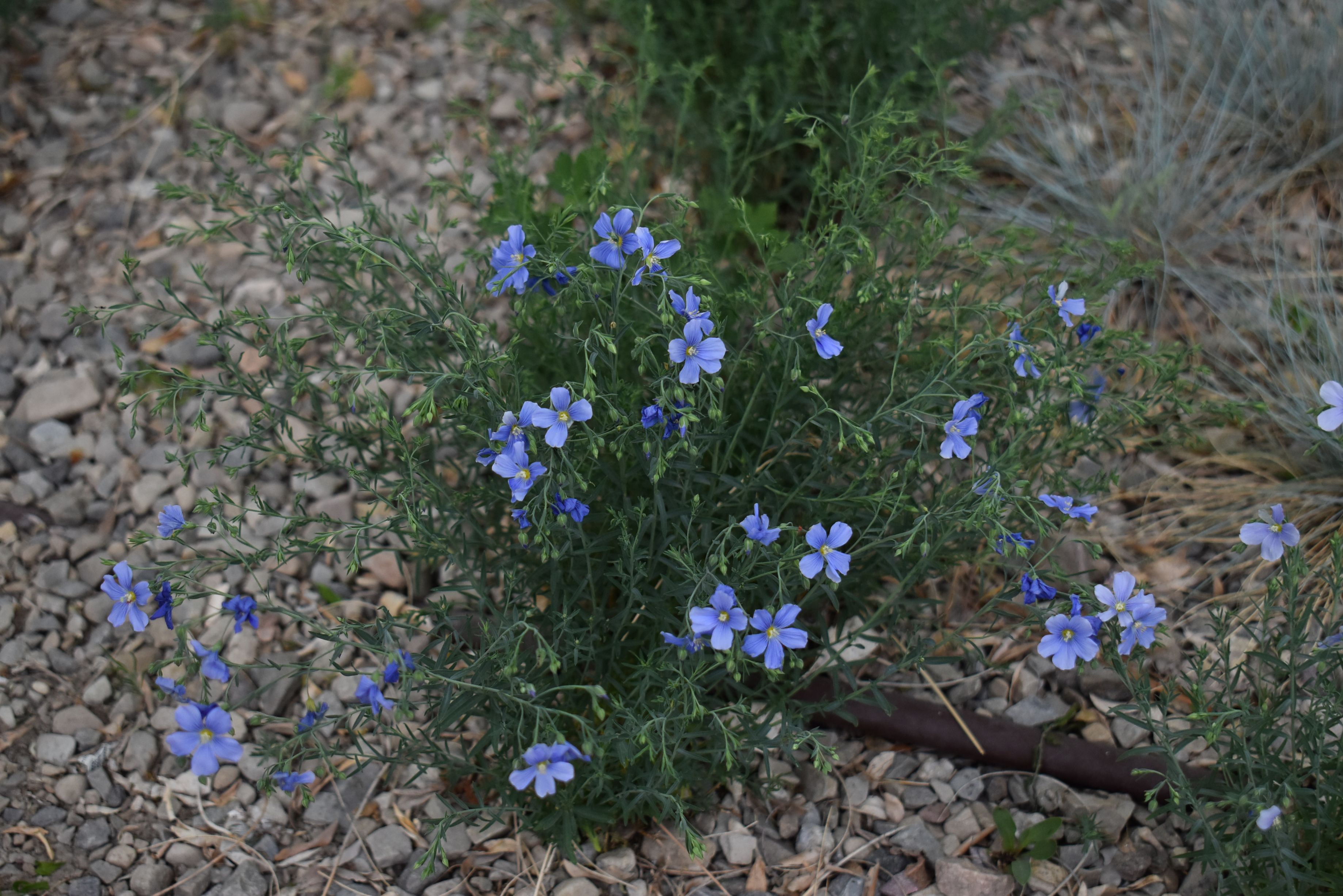
Blue Flax Linum perenne var. lewisii
Also known as Lewis Flax or L. lewisii, this upright native perennial has delicate, vivid blue blooms that come in spring and disappear by June. Fine green leaves grow in hardy clumps. Named after Lewis of the Lewis & Clark Expedition who discovered it in North American prairies.
-
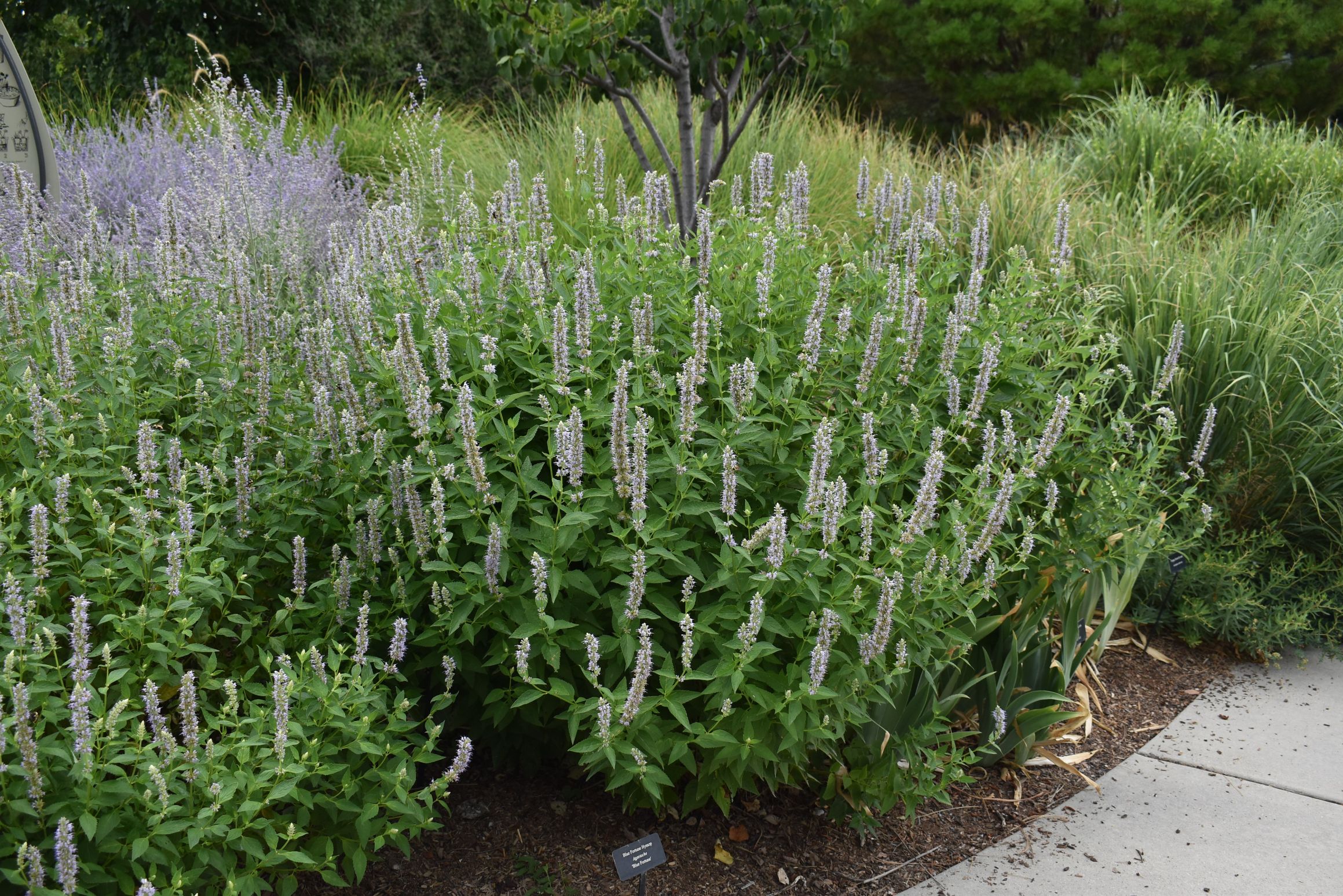
Blue Fortune Hyssop Agastache 'Blue Fortune'
This long blooming, upright perennial is a late summer beauty. Five inch tall spikes of sky blue flowers bloom in mid-summer through autumn and are loved by bees and other pollinators. Its large triangular green leaves are silver underneath. The plant has a slight mint fragrance which is more apparent when leaves are bruised. Prefers moderate amounts of moisture.
-
Blue Giant Glory-of-the-Snow Chionodoxa forbesii 'Blue Giant'
As implied by the name, this bulb blooms in early-spring sometimes before the snow melts. Blue flowers with white centers bloom prolifically over thin green leaves. They are ephemeral, disappearing as the weather warms, avoiding drought all together.
-
Blue Globe Onion Allium caeruleum
Clump-forming herbaceous perennial with dramatic, blue, globe-shaped flower clusters that bloom in mid to late spring. Long, thin, strap-like leaves grow basally. Enters dormancy after flowering and will die back to the ground only to rebloom next year.
-

Blue Glow Globe Thistle Echinops banaticus 'Blue Glow'
This upright-growing perennial grows up to 4 feet tall, topped with thistle-like steel-blue flower heads in the summer. The leaves are spiny and dissected with a rough, dark-green top and downy-white underneath. It is tolerant of many soil types but generally prefers soils that aren't too organically rich. It grows easily from seed and is difficult to transplant due to its large tap root. Deadheading helps to prevent it spreading by seed in the garden.
-
Blue Grama Bouteloua gracilis
A low-growing bunch-type grass native to the northwestern United States plain. This grass can either be left natural, showing off wispy, yellow to tan seed heads or it can be planted densely and mowed short to form a warm season, water-conserving lawn. As a lawn, this grass greens up during May-June and grows well in the heat but will reach dormancy in September.
-
Blue Haze Euphorbia Euphorbia 'Blue Haze'
Compact mounding perennial with outstanding narrow blue-green leaves. Summer brings bright yellowish-green flowers. Foliage provides year-round interest. Does not require large amounts of water. Hardy plant needs very little attention.
-
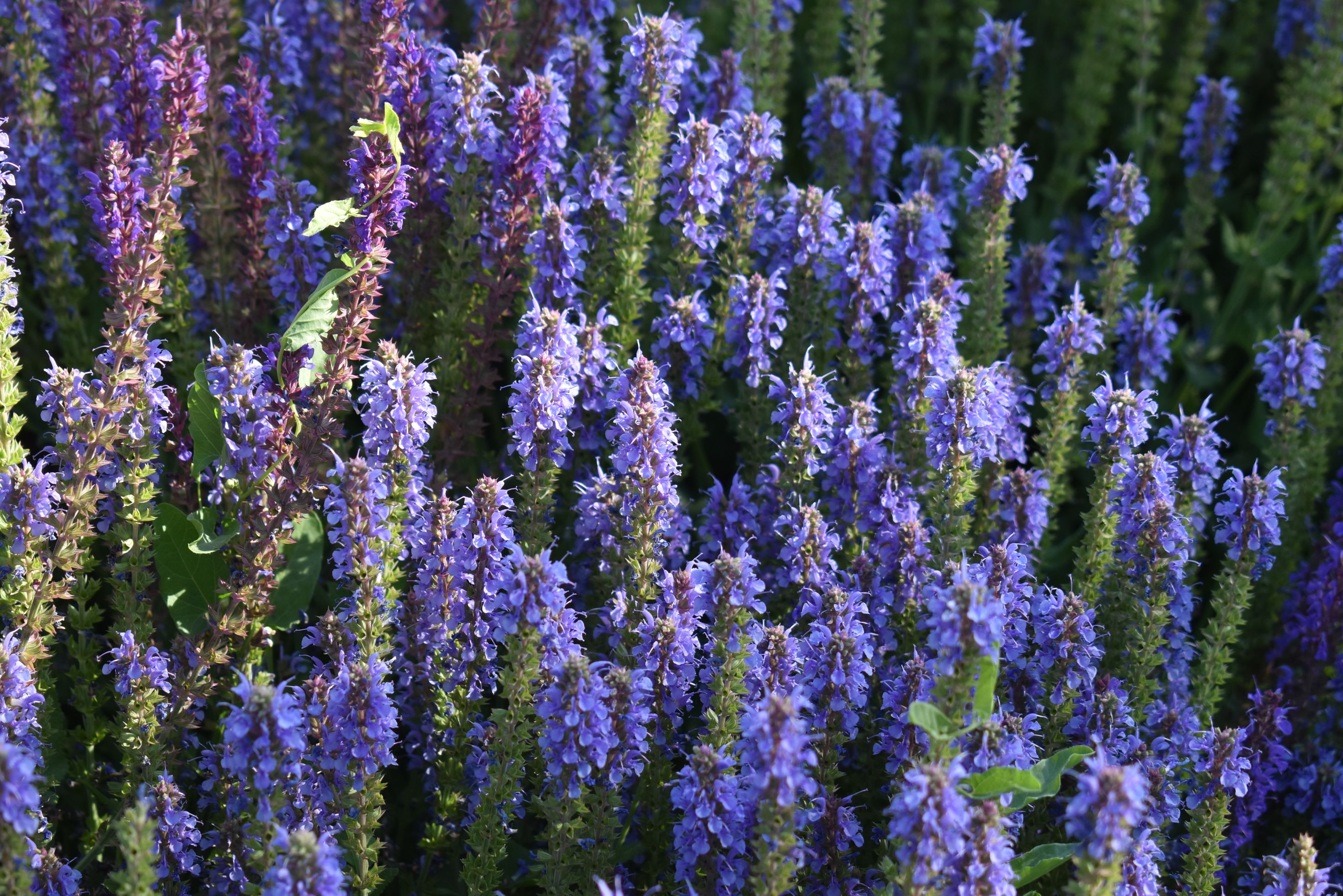
Blue Hill Sage Salvia x sylvestris 'Blauhügel'
Clump-forming perennial. Dark-green, scalloped leaves grow basally. Bears spike-like clusters of pure blue flowers in summer to fall. Flowers are attractive to bees and butterflies. Tolerant of drought. Prefers dry to medium wet soils. Do not overwater.
-
Blue Ice Arizona Cypress Cupressus arizonica 'Blue Ice'
This is a small, fast growing evergreen tree. It works well as a single specimen or row for windbreak. It is perfectly suited for a home evergreen tree due to its small size. This plant has an upright, pyramidal form with handsome blue-grey foliage. It is drought tolerant once established.
-
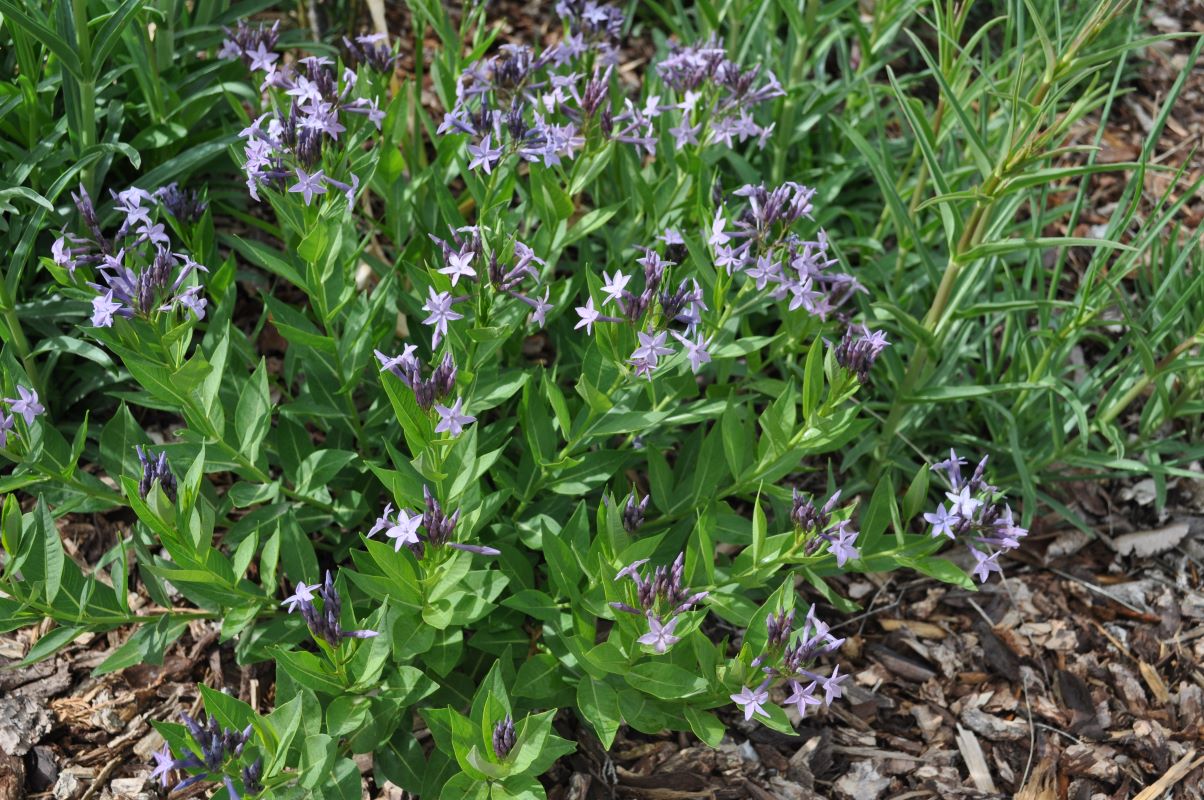
Blue Ice Blue Star Amsonia 'Blue Ice'
This is a long-blooming, compact Amsonia that blooms longer and has stronger stems than the original species. The deer-resistant foliage turns bright yellow in fall. It blooms in early spring with very dark blue-lavender flowers.
-
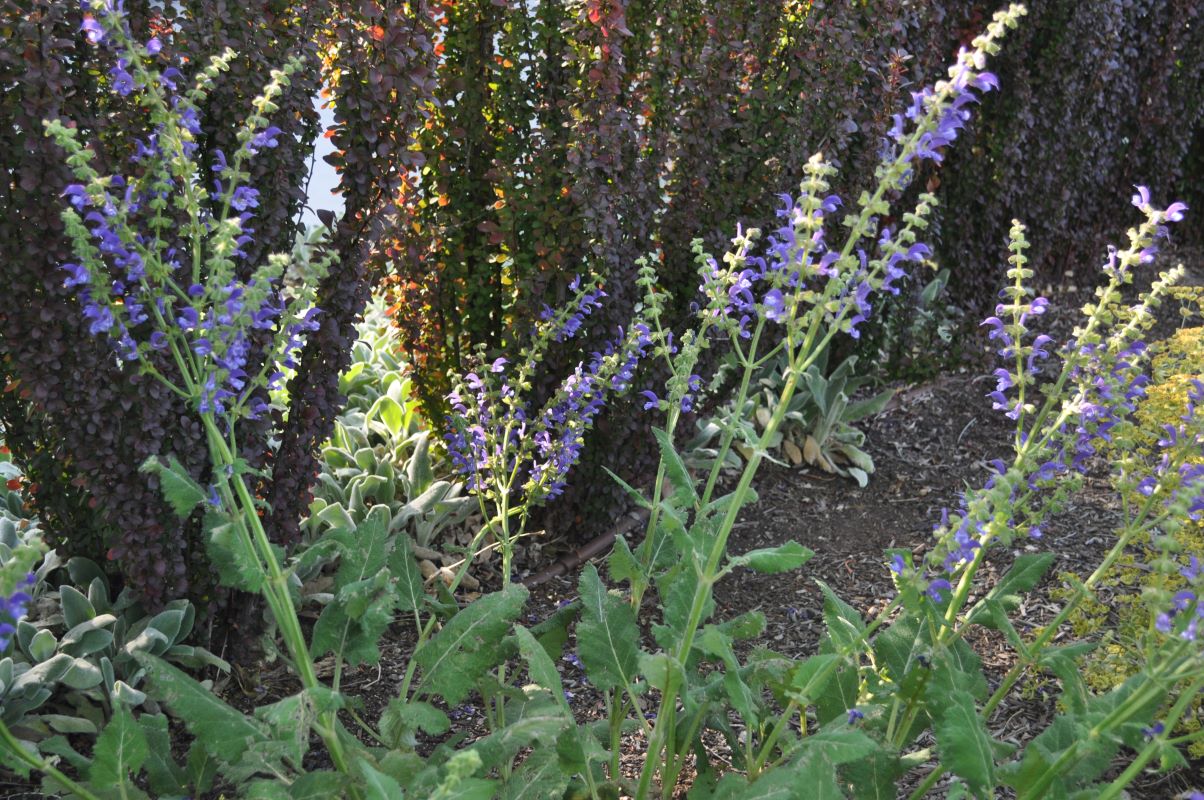
Blue Marvel Sage Salvia nemorosa 'Blue Marvel'
Spikes of violet flowers bloom in early summer over a mound of aromatic, dark green foliage. As the summer progresses, the flowers and the foliage fade. Cutting back the foliage to the basal leaves will result in new growth and blooms, up to three re-blooms in a year in Utah. The plant is drought tolerant once established.
-
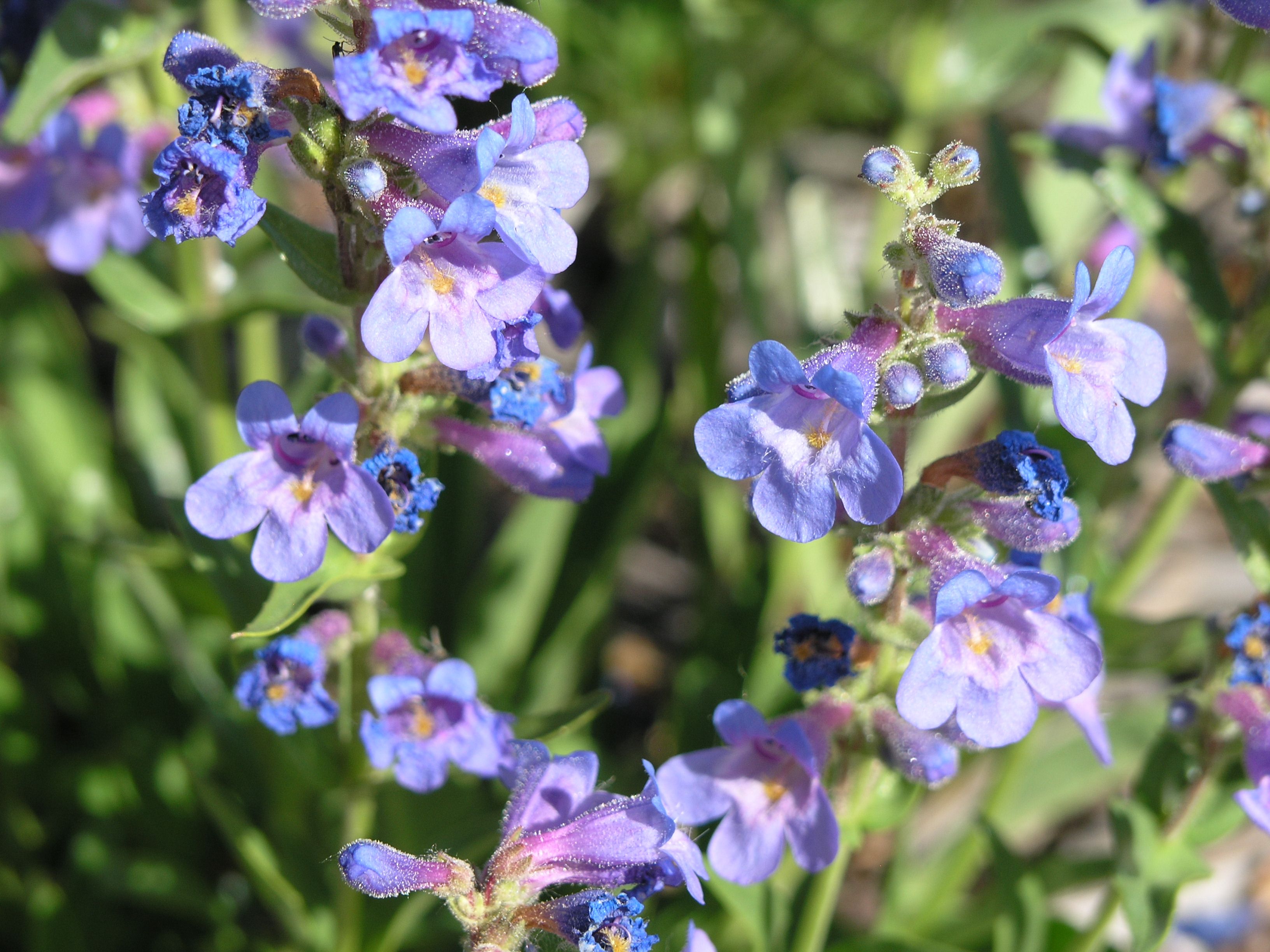
Blue Mist Penstemon Penstemon virens 'Blue Mist'
This small penstemon can be found growing in the foothills of Colorado and Wyoming. Dainty spikes of sky blue flowers bloom on upright stalks. The foliage is dark green and the basal rosettes are evergreen.
-
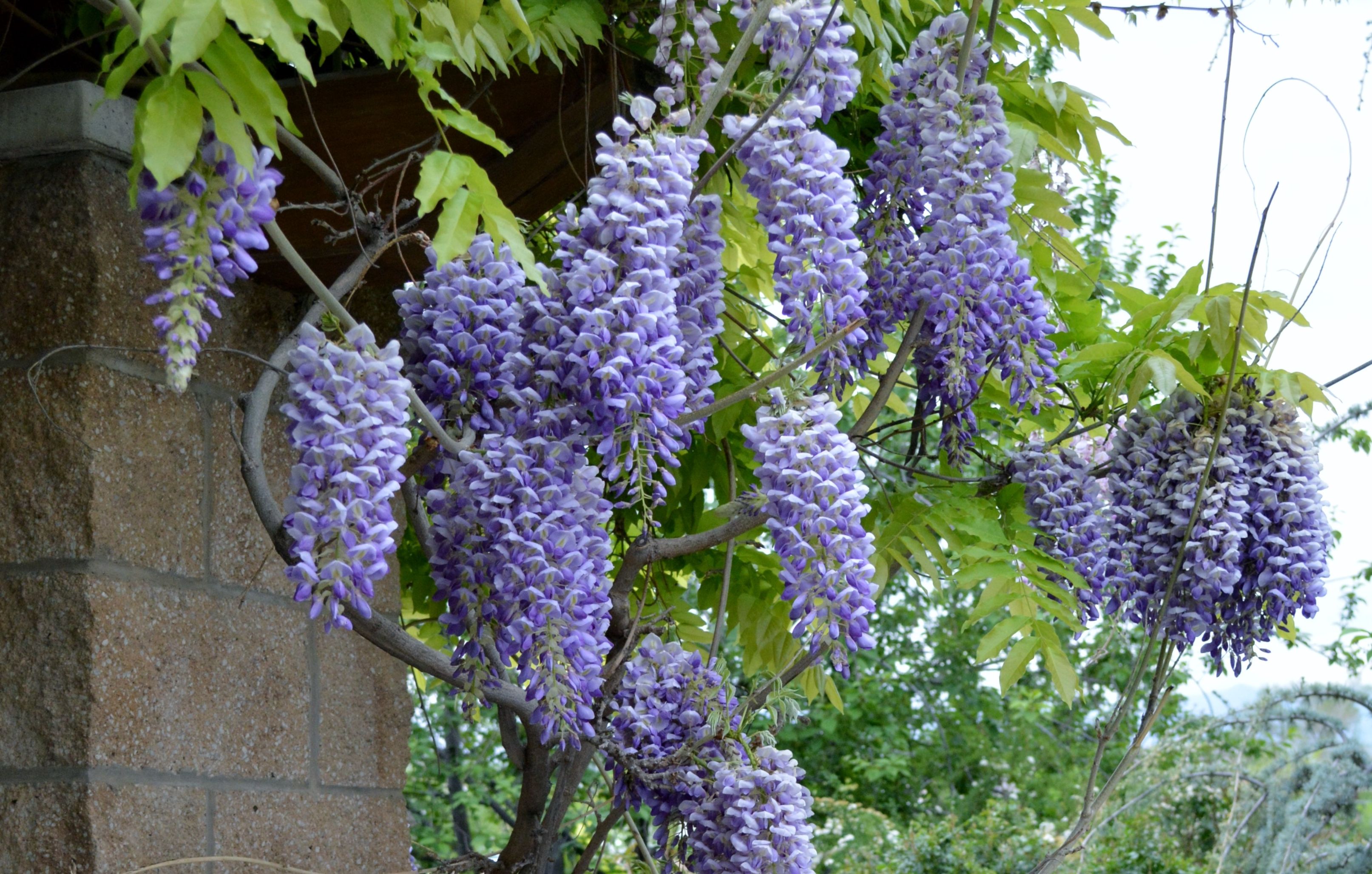
Blue Moon Wisteria Wisteria macrostachya 'Blue Moon'
This climbing vine is a selection of a wisteria native to the southcentral United States. Though less aggressive than other wisterias, this variety is more cold hardy. Clusters of blue pea-like flowers can create a stunning floral display, but the vine may need several years to establish before blooming. This variety may bloom up to three times through the growing season.
-
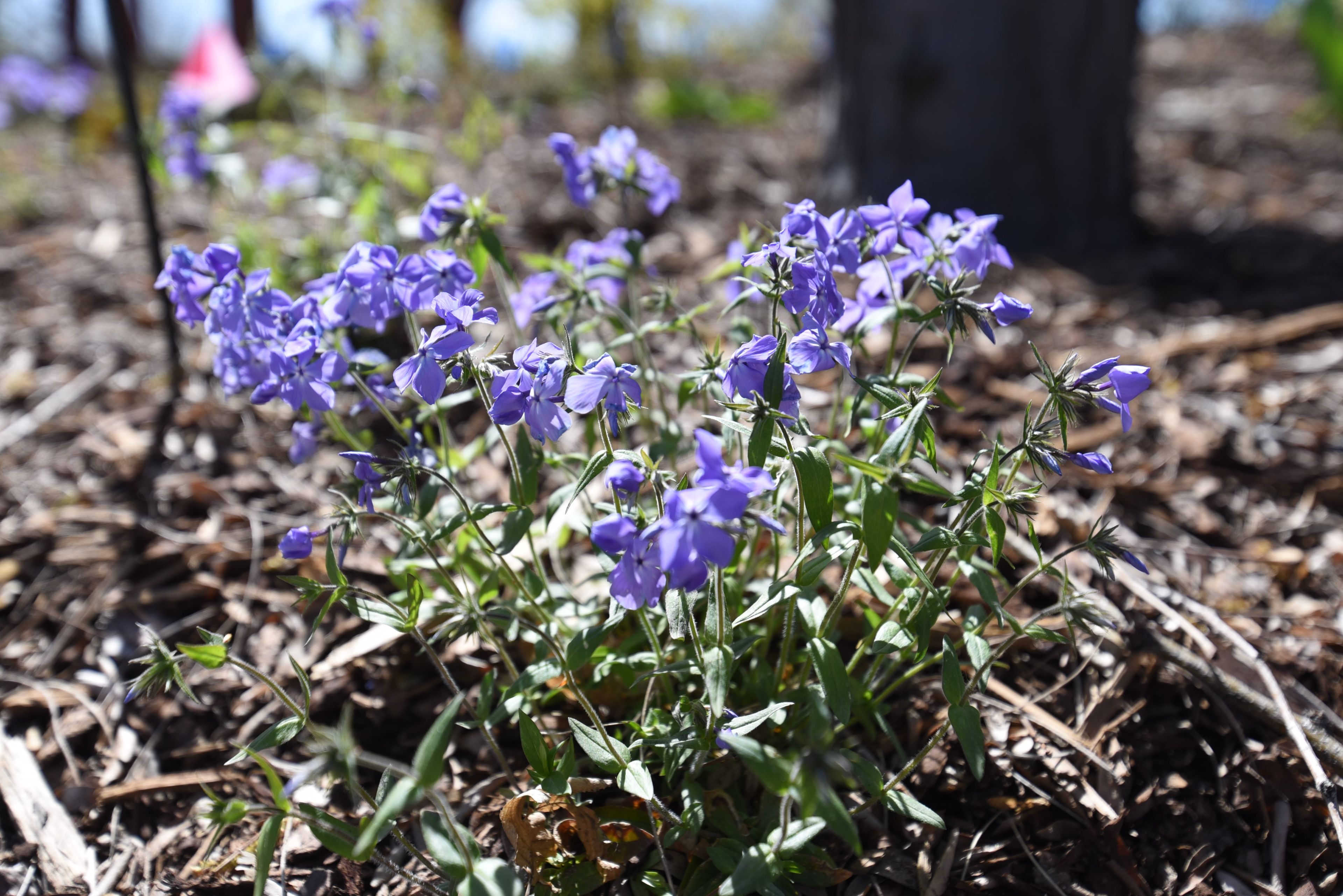
Blue Moon Woodland Phlox Phlox divaricata 'Blue Moon'
A large-flowered cultivar of Woodland Phlox, a wildflower native to the Midwest. Clusters of overlapping 5-petalled pastel purple flowers give this perennial a timeless, romantic look. The loosely trailing stems from a low mat of dark, semi-evergreen leaves. Perfect for partly shady woodland gardens. Could be used as a groundcover if planted densely. Prefers moist soil.
-

Blue Muffin Arrowwood Viburnum Viburnum dentatum 'Christom'
A charming, compact cultivar of a North American native shrub, with many clusters of cream-colored flowers in spring and vibrant blue fruits that ripen in late summer and persist into the winter. The tidy green foliage turns shades of apricot and red in the fall. This shrub is perfect for providing visual structure in the landscape while also benefiting songbirds and pollinators.
-

Blue Oat Grass Helictotrichon sempervirens
Evergreen, perennial bunch grass forming a hemispherical mound of bright grey-blue leaves. Bears upright stems with straw colored seed heads in late spring to early summer Prefers well drained, moderately fertile soil and full sun.
-
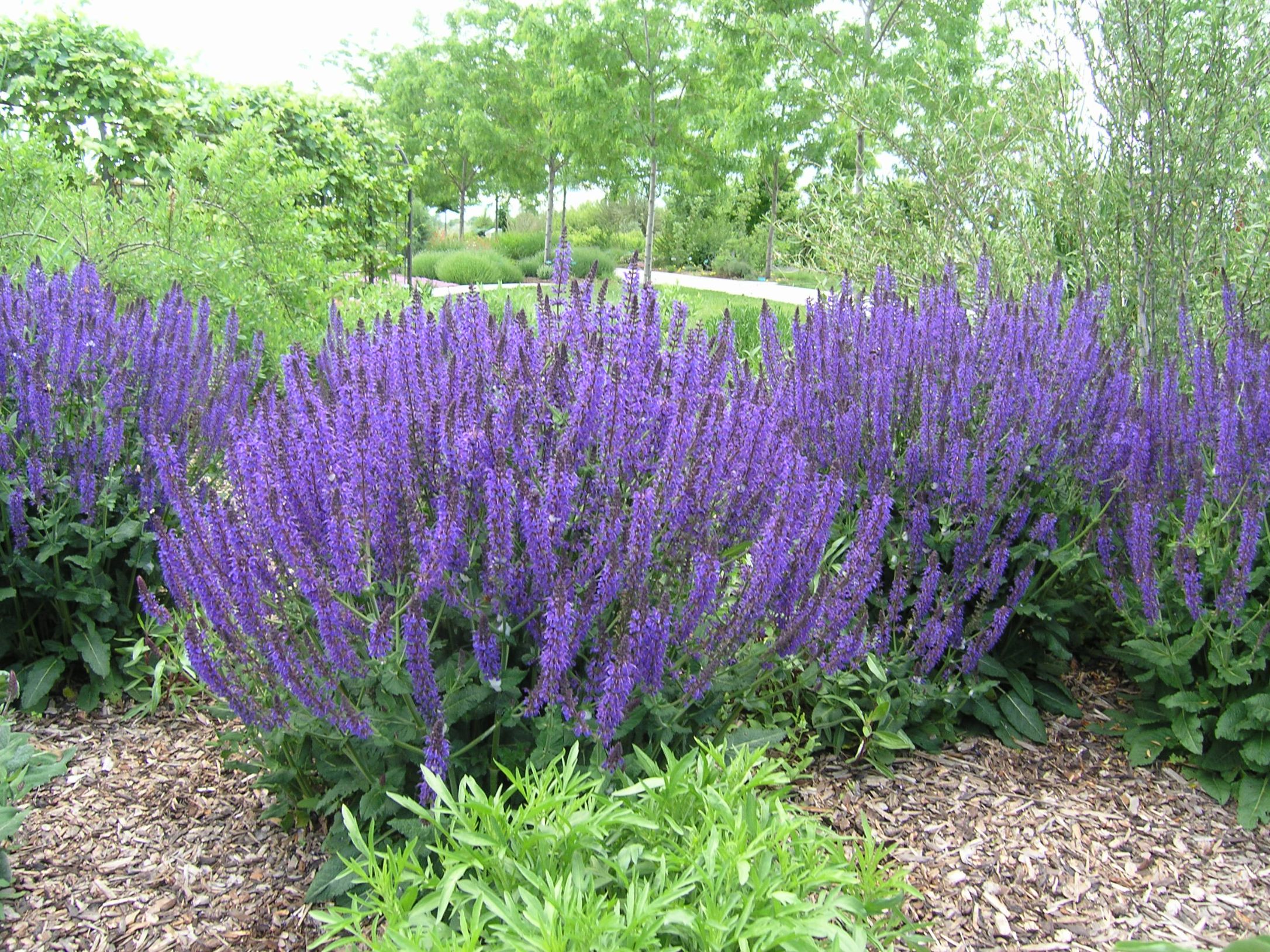
Blue Queen Sage Salvia x sylvestris 'Blaukönigin'
Upright, multi-branched perennial. Mid-green leaves are scalloped and often clasping. Bears dark violet-blue flowers on upright spikes from early summer into autumn. Adaptable to varied types of soils. Prefers full sun to minimal shade. Do not overwater.
-

Blue Sage Salvia azurea
An upright, woody-based perennial with several branched stems having mid-green, grey-green foliage. Produces beautiful pure blue blossoms in dense clusters from late-summer to autumn. Prefers dry to medium moist soils and requires full sun.
-
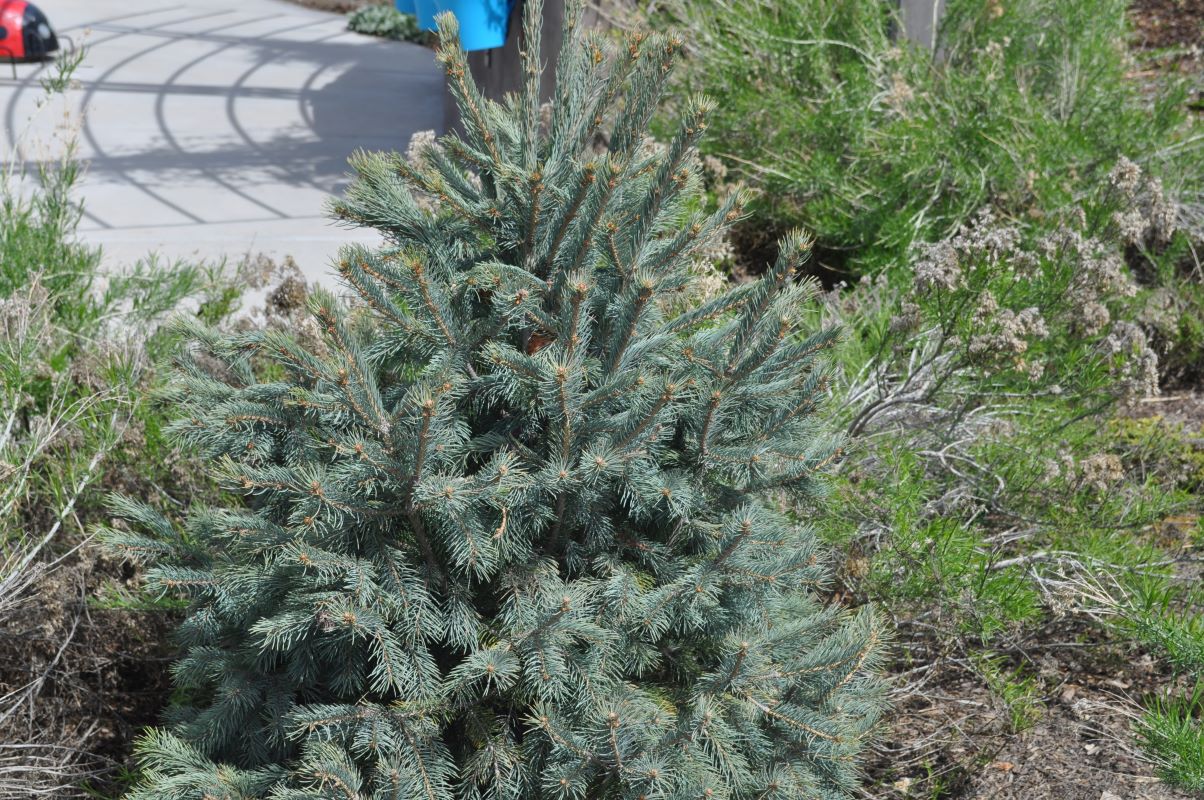
Blue Softie Engelman Spruce Picea engelmannii 'Blue Softie'
Slow-growing evergreen conifer. Dense growth takes a pyramidal form. Provides winter interest. Soft blue foliage color contrasts the needle's pointy texture.
-
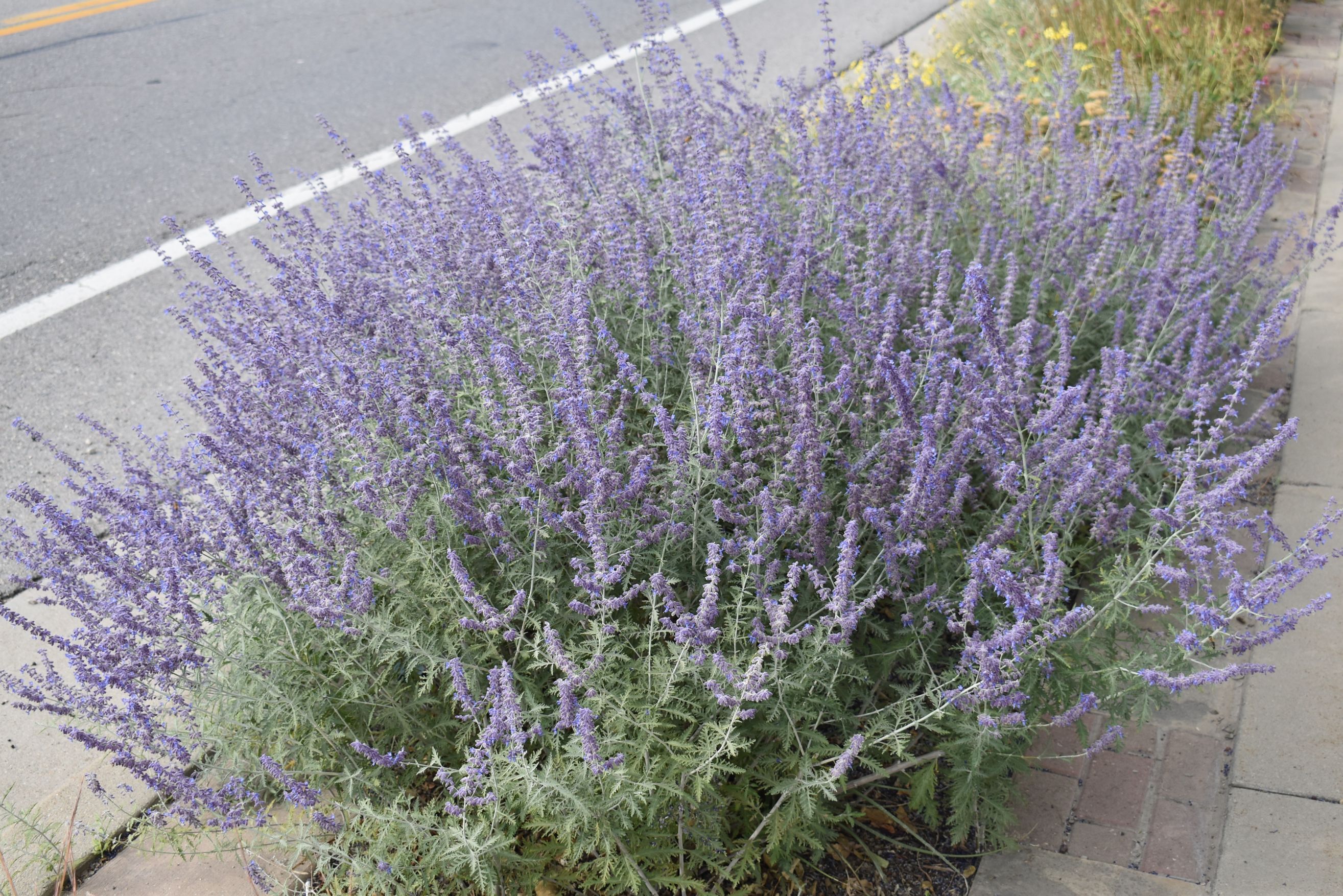
Blue Spires Russian Sage Salvia yangii (syn Perovskia atriplicifolia) 'Blue Spire'
Upright-growing perennial or subshrub. Deeply cut grey-green aromatic leaves grow on tiered branches. Small, tubular, lavender-blue flowers appear in late-summer and are the best feature of this plant. Looks best when cut down to the ground each year. Plant in well-drained soils in a spot with plenty of room to grow.
-
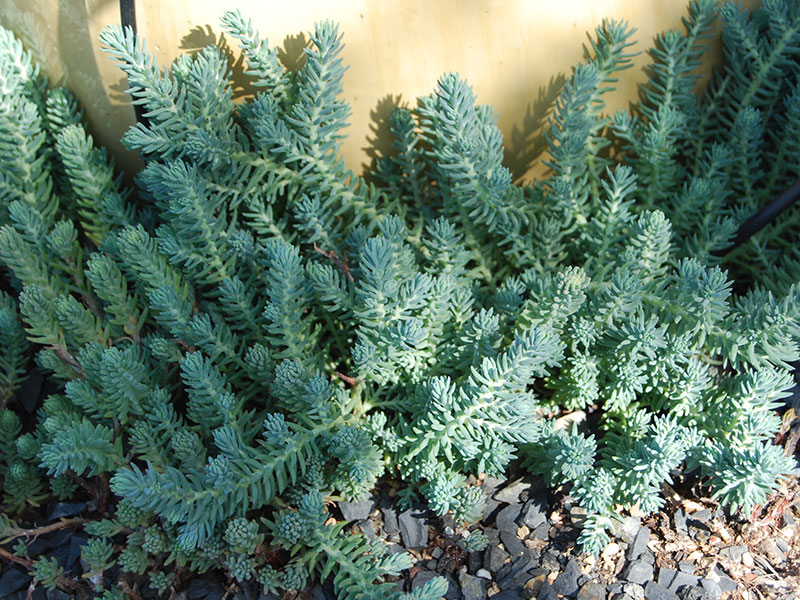
Blue Spruce Stonecrop Sedum reflexum 'Blue Spruce'
A low growing succulent with fine, blue, needle-like leaves. It spreads, but isn't overly aggressive. Yellow flowers bloom in early summer, but aren't showy. It tolerates heavy soils and drought.
-
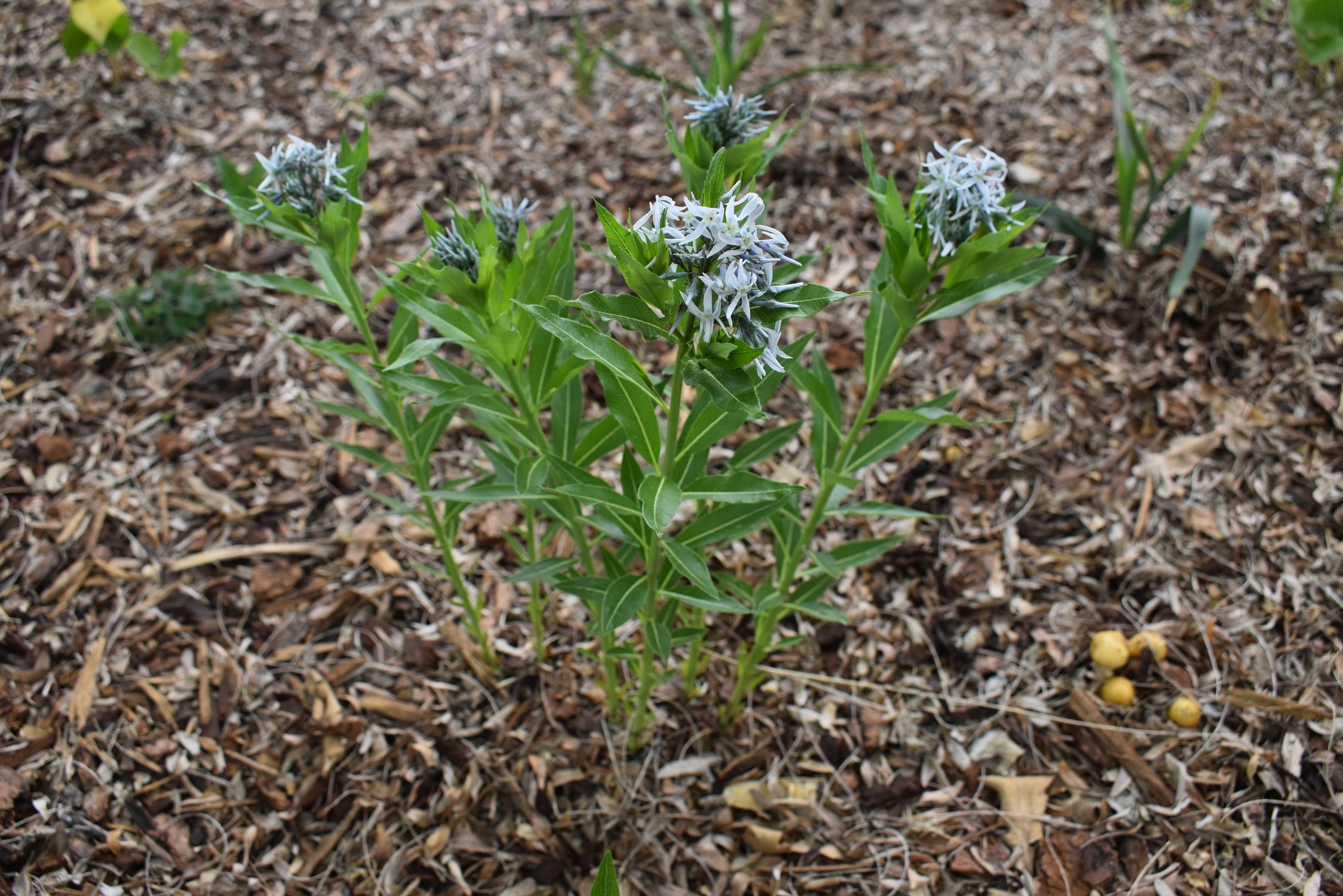
Blue Star Amsonia tabernaemontana var. salicifolia
This native of the Southeastern United States is a clump-forming perennial and can often be found growing naturally in thickets. Pyramidal clusters of light-blue flowers bloom in May. The leaves are a classic green but may turn attractive shades of yellow in the fall. It tends to lean if not grown in full sun. Though it prefers consistently moist soils, it will tolerate some drought.
-
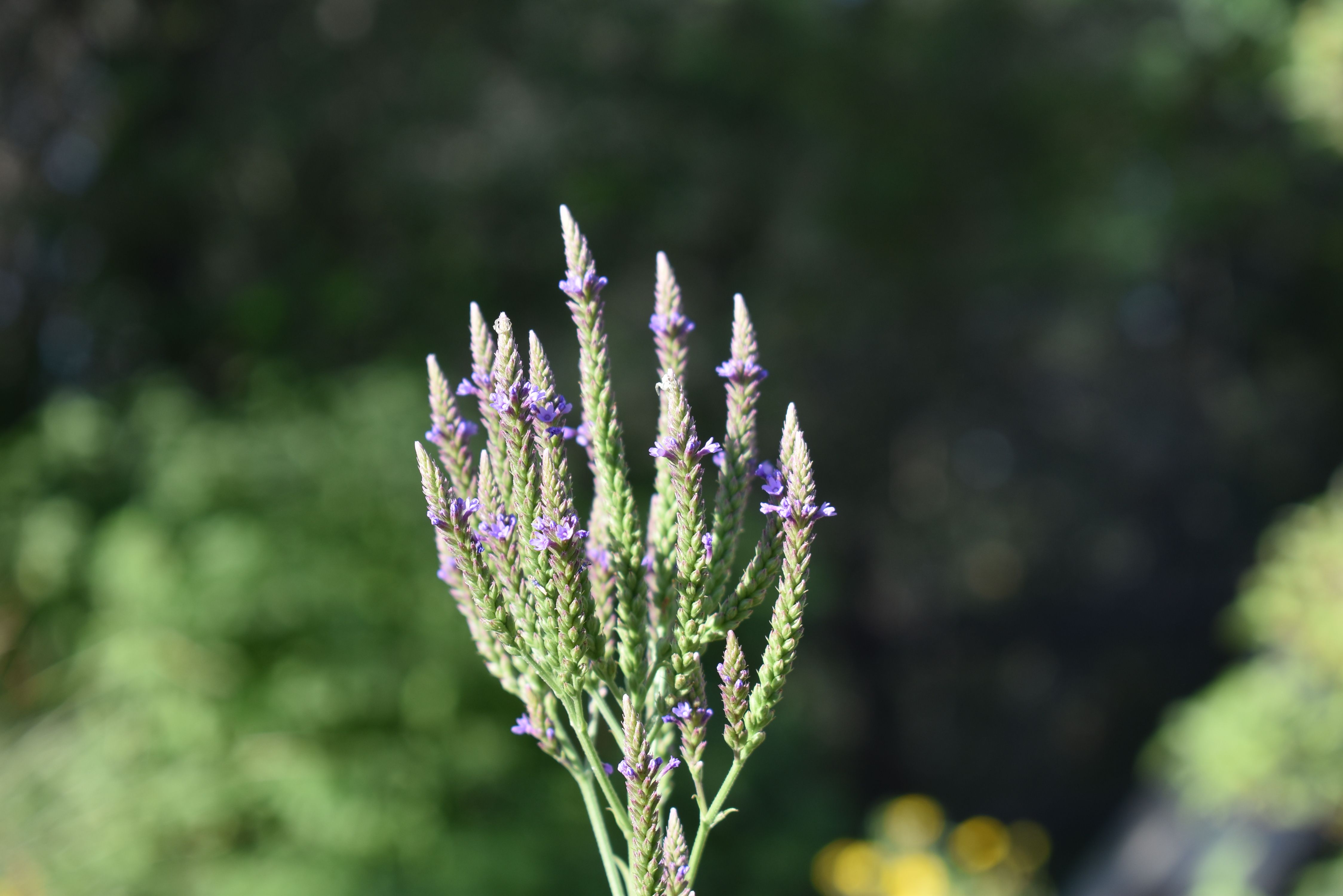
Blue Vervain Verbena hastata
Rough, sharply toothed foliage grows in irregular clumps. Attractive flower spikes sit high above the foliage on hairy, extremely slender candelabra-like branching stems. The spikes are made of tiny, densely packed, purple-blue flowers and are enjoyed for most of summer and may even last into early fall. Blue Vervain prefers wet soil (although it can handle moderate dryness) making it perfect for rain gardens, bioswales and along waterways.
-
Blue Waterfall Bellflower Campanula poscharskyana 'Camgood'
A trailing perennial, this bell flower works well in rock walls and in between steppers in a pathway. Numerous small bell-shaped flowers with white centers cover the creeping foliage.
-
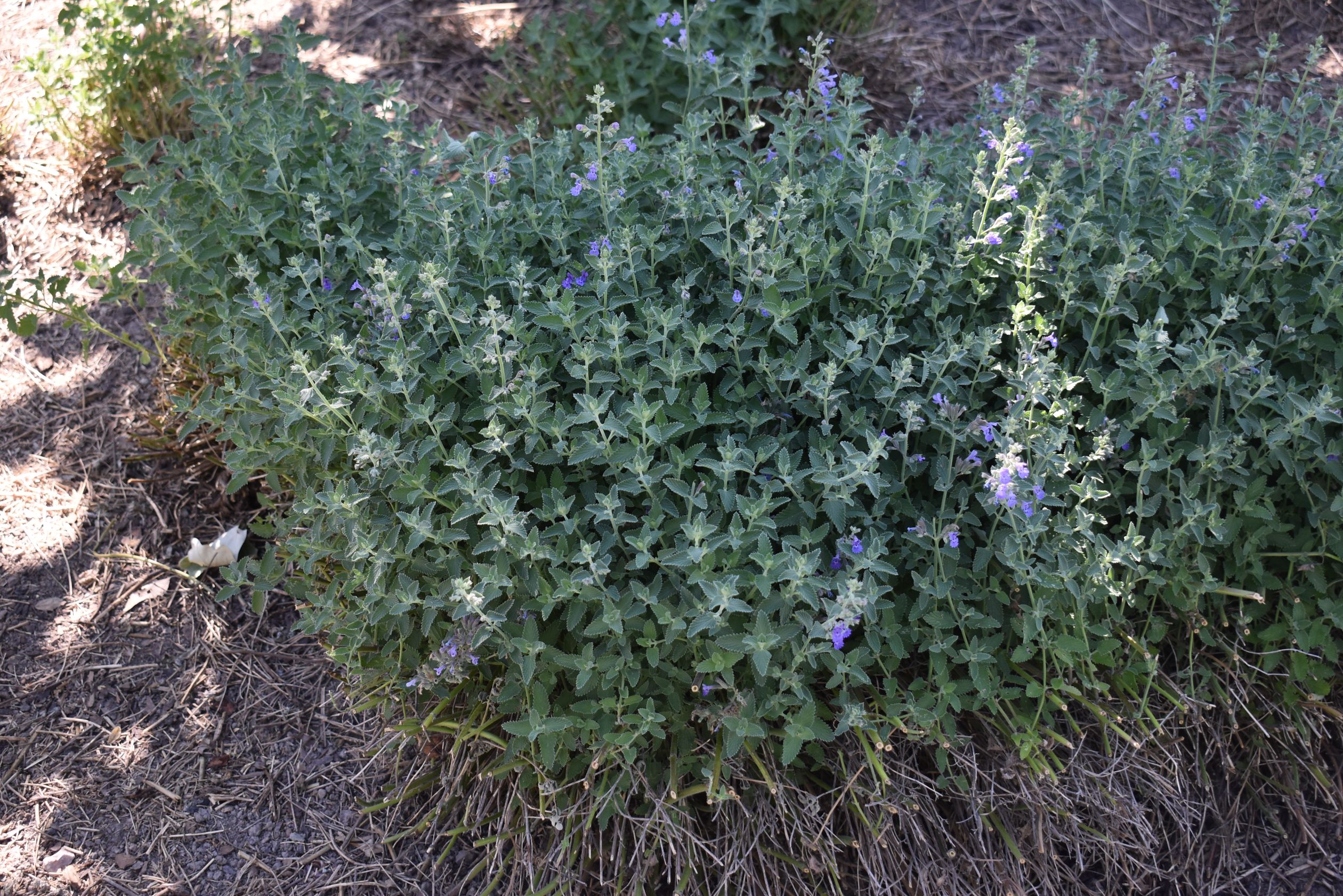
Blue Wonder Catmint Nepeta racemosa 'Blue Wonder'
Dwarf, mounding perennial with oval, deeply veined, grayish green, aromatic leaves. Summer brings loose clusters of small lavender blue flowers that rebloom almost continually throughout the summer. Related to catnip and is somewhat enticing to cats.
-

Blue Zinger Sedge Carex 'Blue Zinger'
This perennial sedge has grass-like, bluish-green foliage that grows in fountaining clumps. It works well in shade and prefers moderate moisture but can tolerate some drought. Functions well planted en mass as a lawn alternative, which can be mowed once a year to keep a tidy look. Can also be planted singly for the look of a small ornamental grass.
-

Blue-Stemmed Goldenrod Solidago caesia
Pointed green leaves droop below clusters of small yellow flowers that run the length of long arching purple stems. Also known as Wreath Goldenrod, this lovely wildflower is native to eastern north America and has a unique form and texture that stands out in woodland and pollinator gardens.
-
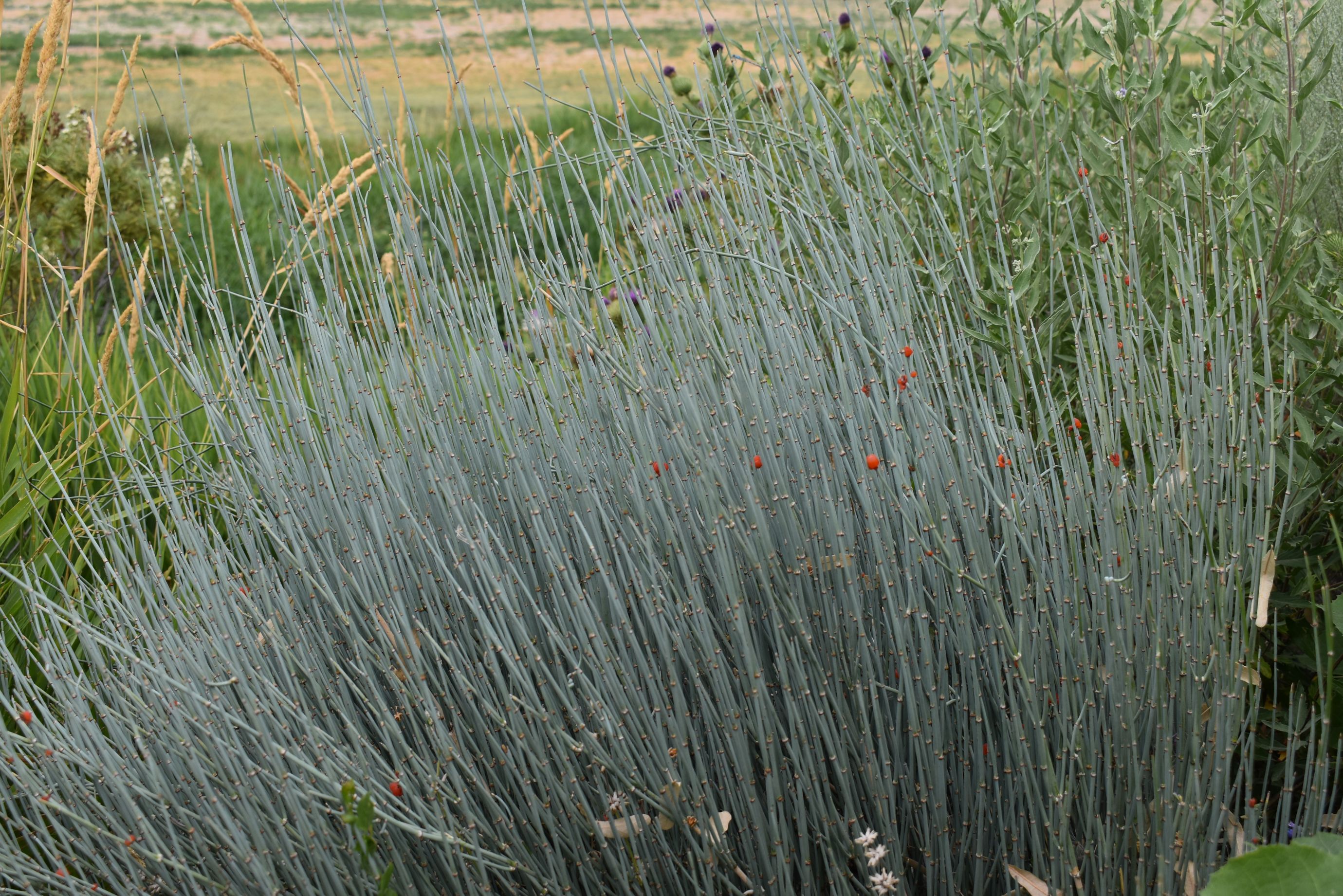
Bluestem Joint Fir Ephedra equisetina
A large evergreen shrub native to China and central Asia. The stems are blue gray in color and finely textured. Clusters of small yellow flowers bloom in spring turning to red berries. This shrub is extremely drought tolerant and needs full sun.
-
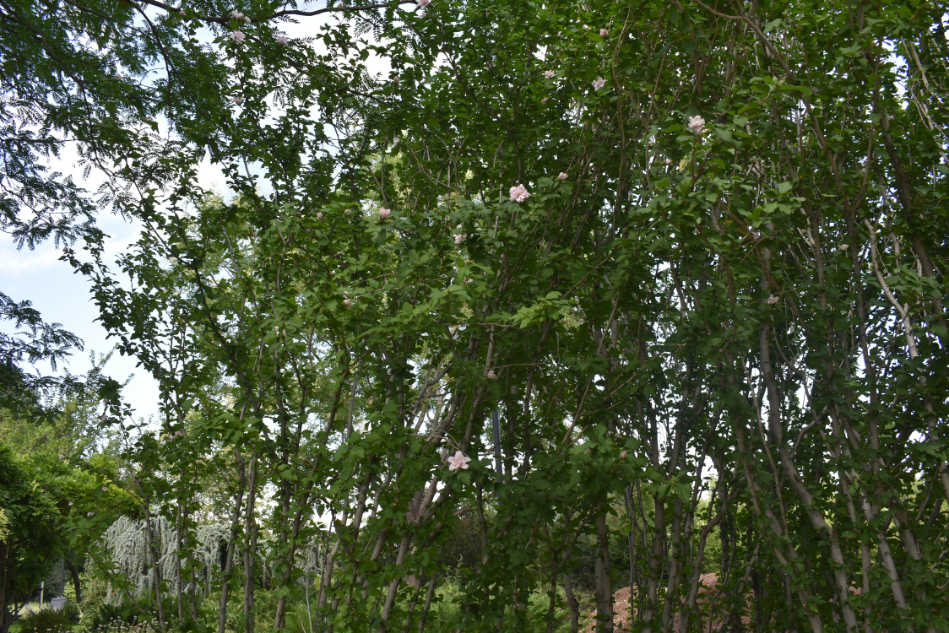
Blushing Bride Rose of Sharon Hibiscus syriacus 'Blushing Bride'
Vigorous, multi-stemmed, upright, deciduous flowering shrub. Numerous showy, rich-pink, double flowers, fading to white, are borne throughout the summer. Attractive 3-lobed, coarsely toothed leaves grow on erect stems. Tolerant of heat, drought, and poor soils. Prefers fertile soils with moderate amounts of water.
-
Bonsai Dwarf Tall Fescue Festuca arundinacea 'Bonsai'
Deep rooted, green, cool season perennial turf grass. Tolerates some shade, foot traffic and recovers well after drought. Does best in well drained clay soils. Uses less water than Kentucky bluegrass with a similar look. Best kept cut at 3 inches or longer. Improvements are constantly being made in the varieties available commercially. Consult your local sod or seed provider for information on the best varieties available.
-
Border Ballet Red-Hot Poker Kniphofia 'Border Ballet'
A grass-like perennial with narrow leaves and clusters of multi-colored flowers held on tall stems above the plant. The flowers of 'Border Ballet' are pastel hues of red, orange, yellow and pink. Grows well in most sites but is intolerant of wet soils.
-
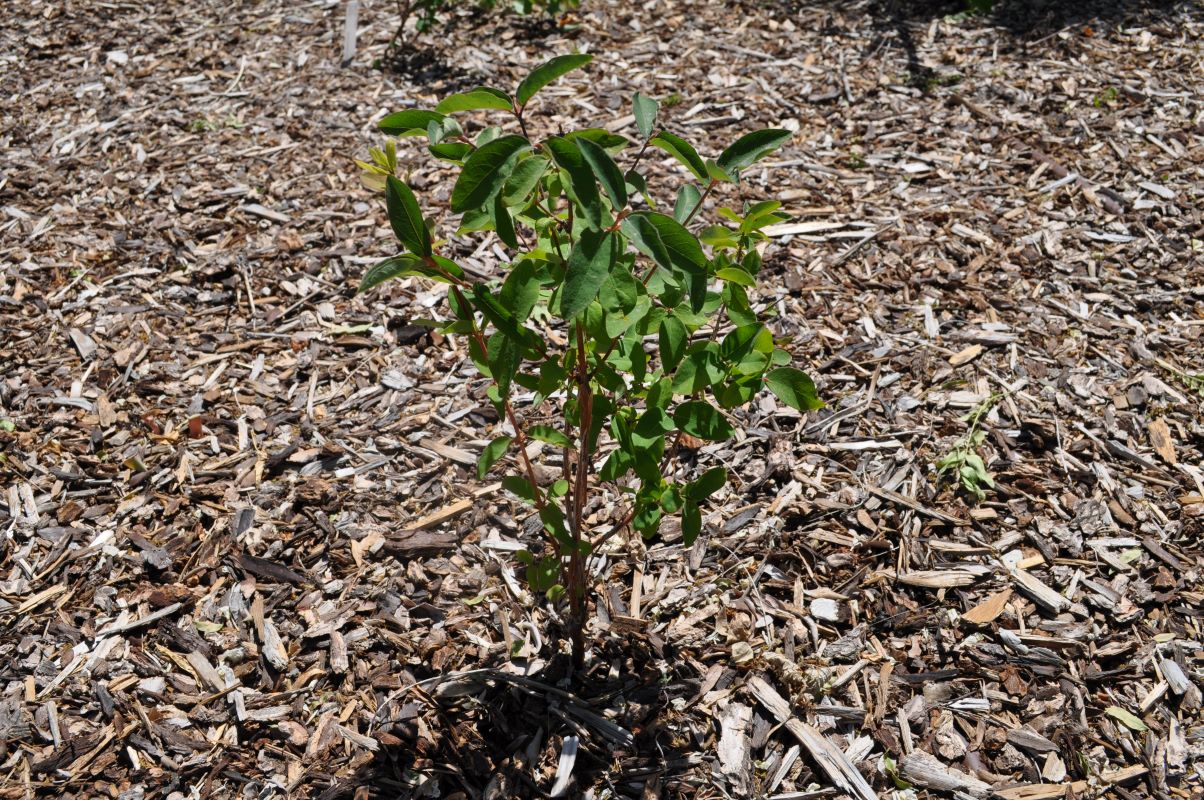
Borealis Honeyberry Lonicera caerulea var. edulis 'Borealis'
This winter-hardy, fruit-bearing plant provides an excellent alternative to growing blueberries. Fragrant, white flowers in early spring are followed by an abundance of elongated, sweet, deep purple-blue berries. This plant has an upright growth habit and tends to be dense with foliage. In order to develop fruit, it needs to be cross-pollinated with another honeyberry. The Aurora or Polar Jewel cultivars are good options. Fruit begins developing one to two years after planting.
-
Bosnian Pine Pinus heldreichii
Native to the Balkans and southeastern Europe, this pine can grow quite tall in its natural habitat. In landscapes it averages 30 - 40 feet tall. Its dense foliage consists of pairs of glossy green needles. In youth, it has a pyramidal habit but spreads with age. Its cones are noted for their purple to blue coloring. It can tolerate a wide range of conditions but performs poorly in soggy soils or extreme heat.
-
Boughton Silver Wormwood Artemisia stelleriana 'Boughton Silver'
Compact, spreading, evergreen perennial. Forms a carpet of deeply-lobed, fragrant, silvery-grey foliage. Inconspicuous yellow flowers grow on white stems in late-summer or early-fall. Plant in well-drained soils in full-sun. Prefers sandy soil but is adaptalble to different soil types. Perfect for planting in borders and as an accent.
-

Boulder Blue Fescue Festuca glauca 'Boulder Blue'
Clump-forming mounded ornamental grass with bluish-gray foliage that is bluer than the species. A prolific bloomer, this grass's seedheads appear late-spring to early-summer. Shines as a groundcover in mass plantings or as a neat border. Tolerates some drought and alkaline soils. Pull out dead leaves by hand or with a rake in the early spring for a healthy plant and a natural look.
-

Bountiful Harvest Iris Iris 'Bountiful Harvest'
Upright growing perennial with fragrant flowers. Blooms are short-lived and may only last for 3-7 days. Flowers are deep purple with white on its falls. Long, lance-shaped leaves are attractive and deer resistant.
-
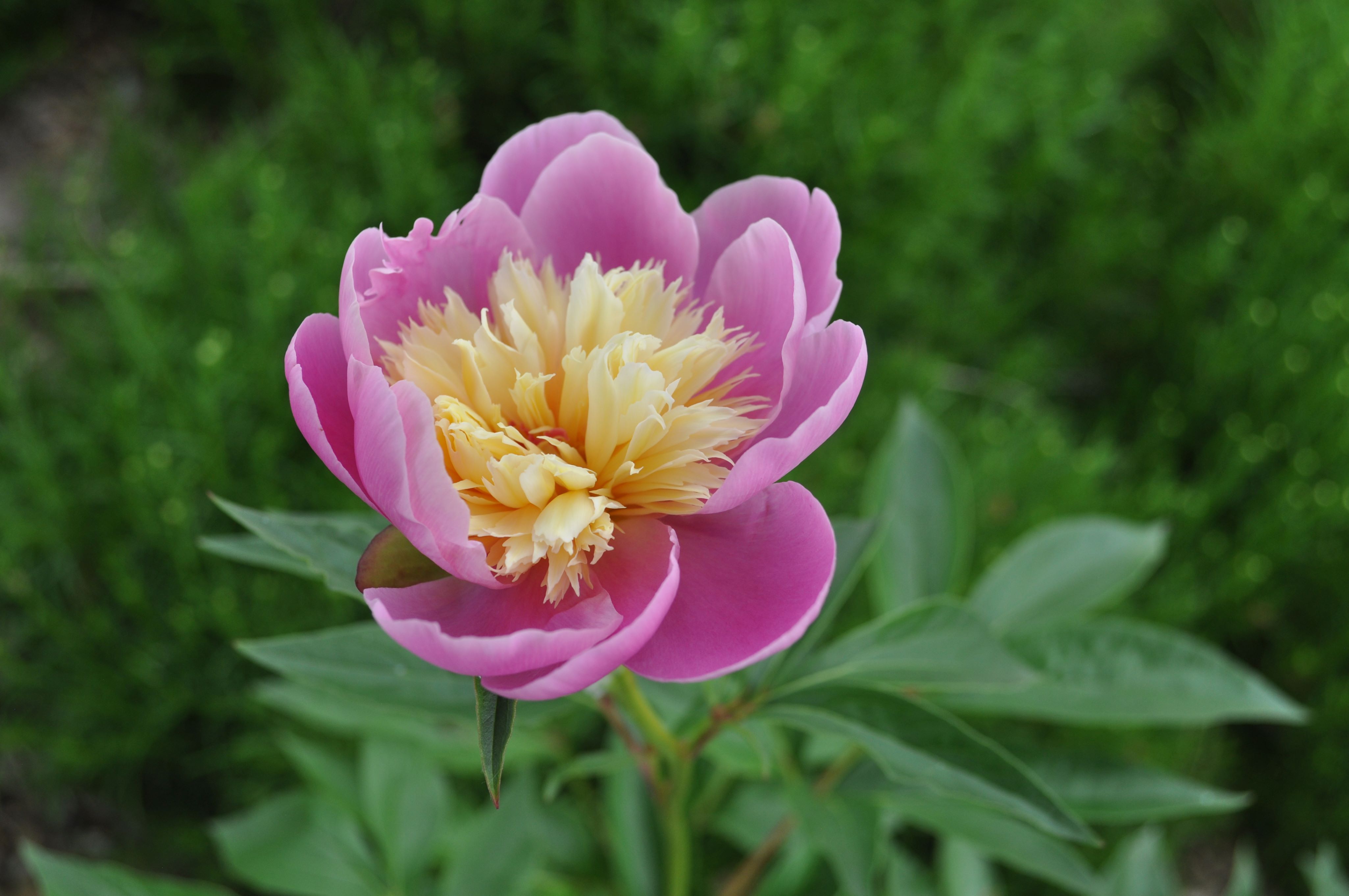
Bowl of Beauty Peony Paeonia 'Bowl of Beauty'
Clump-forming, bushy herbaceous perennial. Rosy-pink petals surround the pale yellow center petals like a bowl. Abundant mid-green deeply-lobed foliage grows on stiff upright stems. Plant in fertile well-drained soils. Tolerates some drought once established.
-
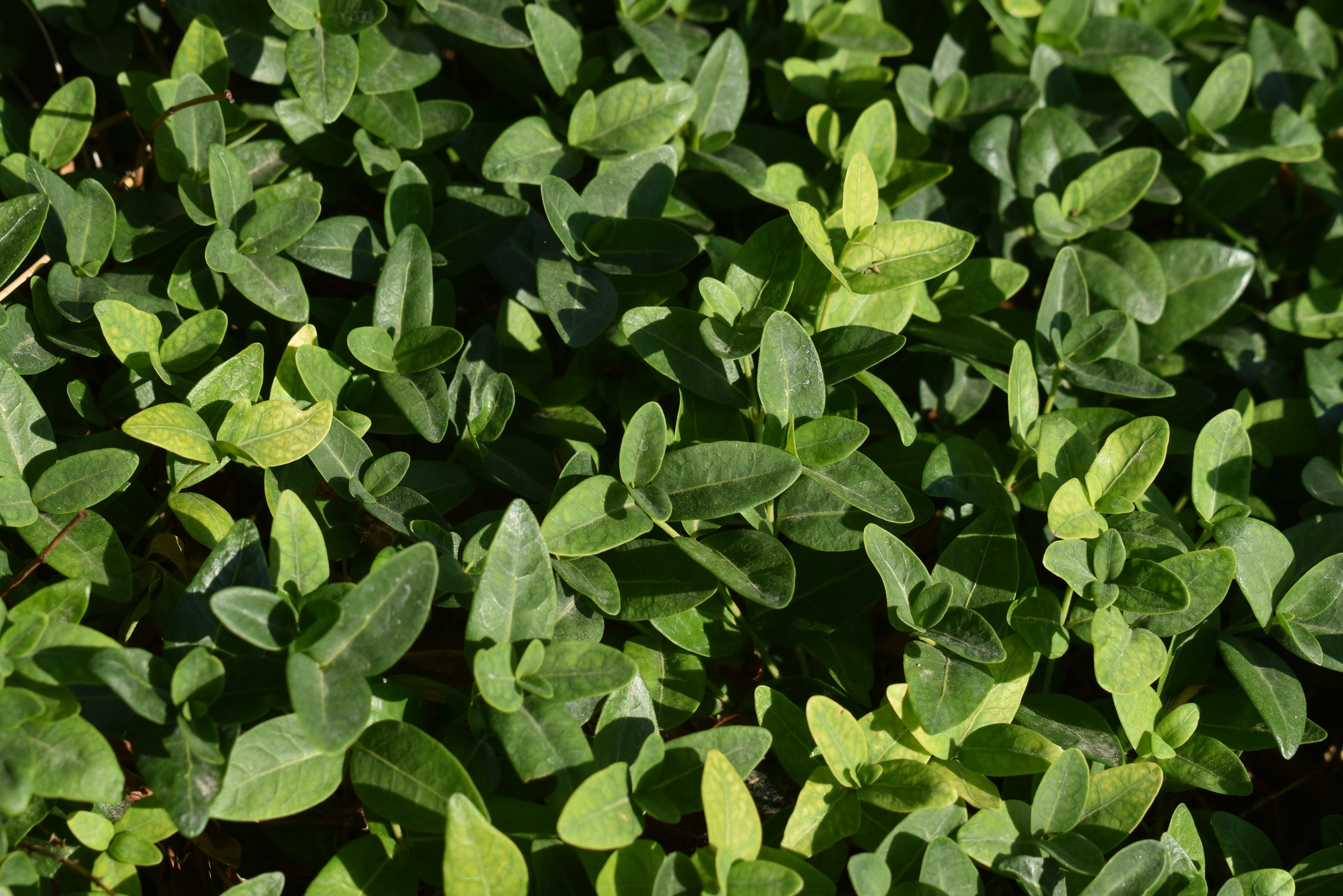
Bowle's Variety Dwarf Periwinkle Vinca minor 'La Grave'
Low-growing, evergreen perennial. Stems become somewhat woody overtime. Produces large two inch violet-blue flowers in early-spring to autumn. May be somewhat aggresive, but this variety is less so than the species. Will tolerate a wide variety of soil but prefers moderate amounts of water in protected areas.
-
Bradford Flowering Pear Pyrus calleryana 'Bradford'
A popular medium-sized deciduous tree that starts out narrowly conical and grows rounder and broader with age. Clusters of white flowers bloom in early spring followed by small brown-red fruit that are prized by the birds. Broad, glossy, toothed leaves are dark green turning red to purple in the fall.
-
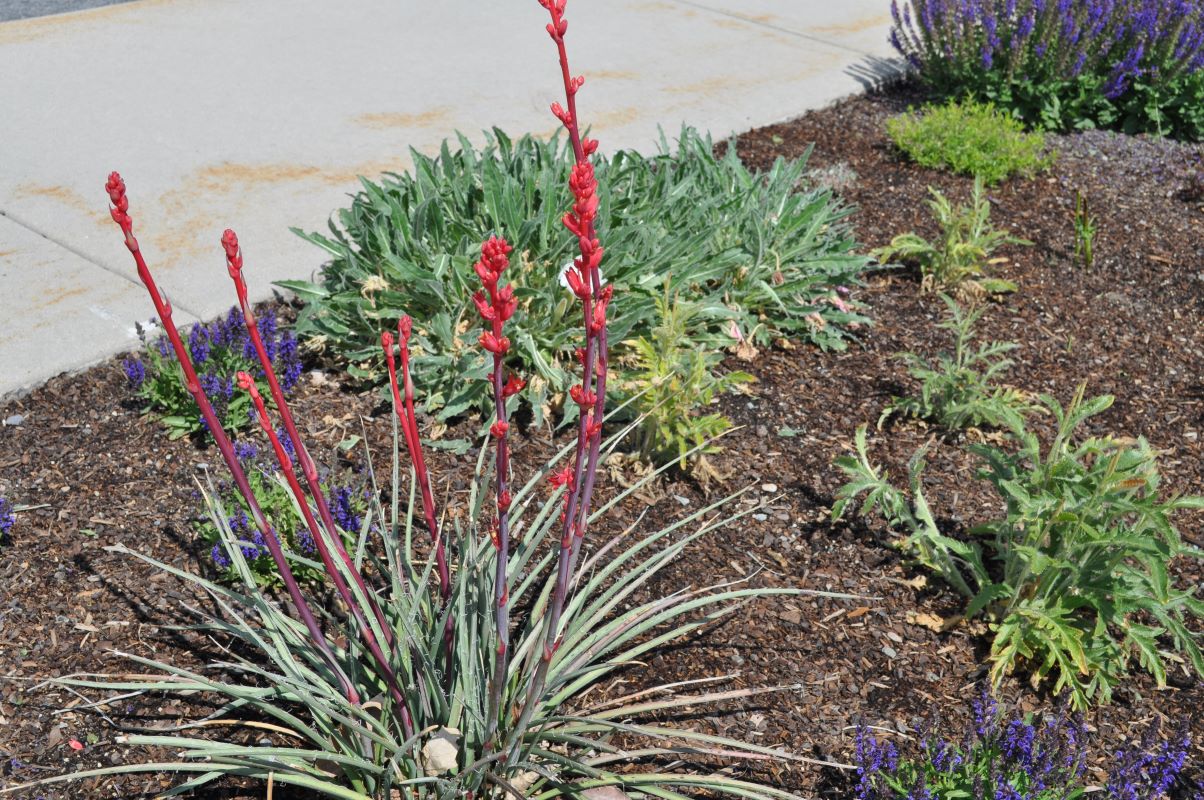
Brakelights Red Yucca Hesperaloe parviflora 'Perpa'
Fire-engine red flowers of this compact cultivar begin blooming in early summer and last throughout the season. Long, fleshy, evergreen leaves grow up from its base. It is tolerant of many soil types and very drought tolerant. It needs full sun to thrive.
-

Bressingham White Bergenia Bergenia 'Bressingham White'
A low-growing perennial with thick, rounded evergreen leaves. Reddish green stalks emerge in the spring and produce clusters of pure white flowers that are much improved over the species. Even without the flowers, the glossy green leaves are very ornamental. It needs consistent moisture to grow well and does best with some shade. Looks great in mass plantings.
-

Bridges' Penstemon Penstemon rostriflorus
Semi-evergreen perennial or subshrub. Stems branch from a woody base and large tap-root. Linear foliage is non-descript. Red-orange tubular flowers grow on upright stems and bloom throughout the summer. Grow in well-drained soil.
-

Bright Edge Yucca Yucca filamentosa 'Bright Edge'
A broadleaf evergreen shrub, this yucca has long, rigid, sword-shaped leaves with bright-green edges that grow basally and are tipped with spines. Curly, thread-like filaments develop along the leaf margins. Tall stalks growing out of the center of the plant produce clusters of large white flowers in the summer. Grows well in poor soils and tolerates drought.
-
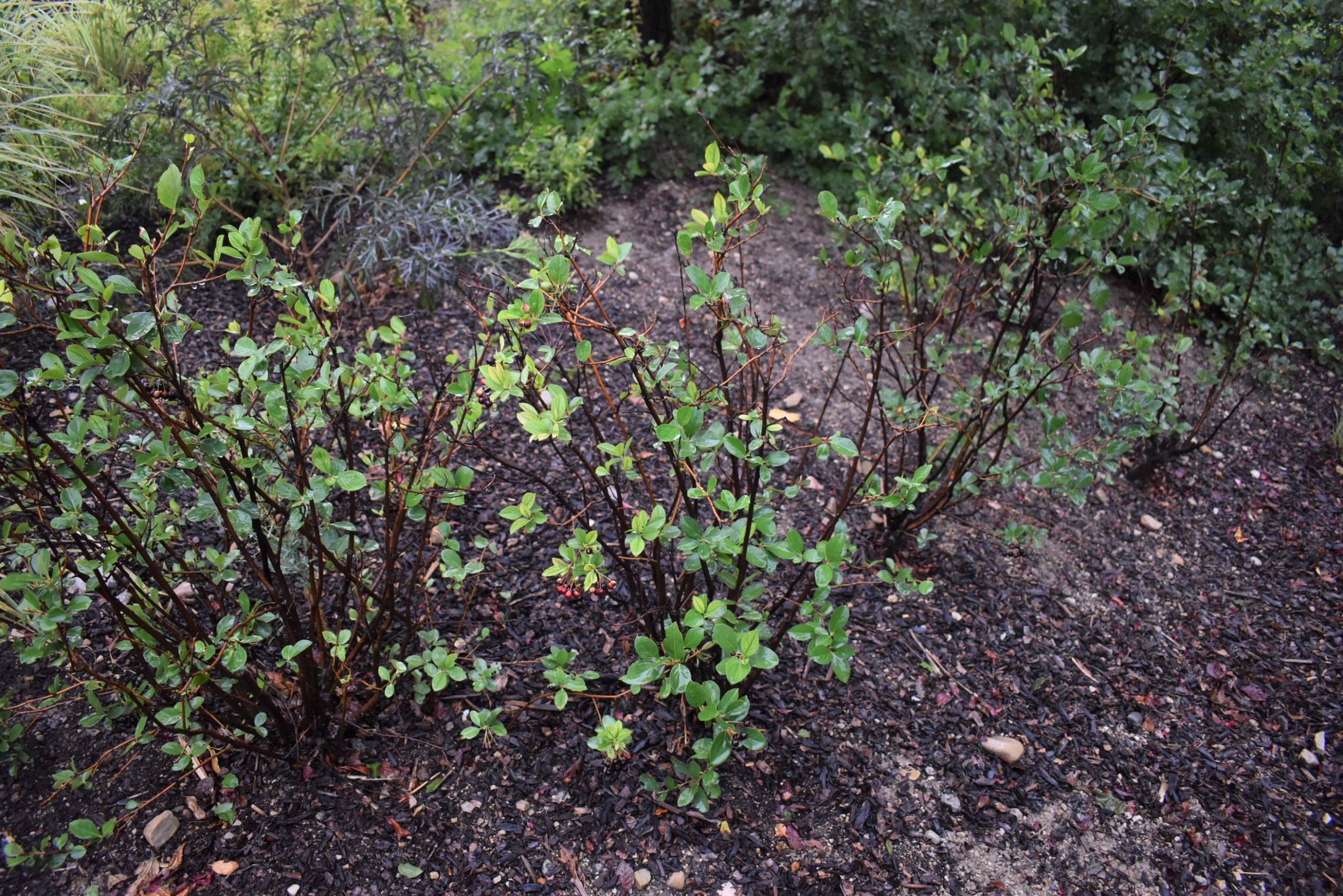
Brilliant Red Chokeberry Aronia arbutifolia 'Brilliantissima'
This tall, vase-shaped deciduous shrub offers something different in every season. Pure white flowers bloom in early-spring followed by bright red berries that turn black in late summer. The berries are technically edible but, as the common name suggests, quite astringent and better left to the birds. Its glossy dark-green leaves are grey-green underneath and turn a brilliant red in the fall, making it one of the brightest plants in the fall landscape. 'Brilliantissima' grows slightly smaller than the species, which is native to the Northeast. Perfect for woodland borders or naturalized areas. Cold hardy and tolerates both wet soils and drought.
-

Brilliant Stonecrop Sedum spectabile 'Brilliant'
Brilliant Stonecrop has upright stems that display whorls of fleshy, light-green leaves. Summer brings large, flat head clusters of tiny rosy-pink blossoms. This succulent adds interesting texture and color to the landscape.
-
Bristlecone Pine Pinus aristata
This bristlecone pine is a Rocky Mountain native. Very slow growth means that trees may live for several hundred years. Short dark green needles emerge in a bristly, bottlebrush-like manner from the branches. An excellent specimen for any yard. Will grow more rapidly with additional moisture, but very hardy and very drought tolerant.
-

Broadleaf Cattail Typha latifolia
This spreading wetland perennial Utah native is not waterwise. It grows naturally in wetlands, including soils with standing water. Long, linear grass-like leaves grow in large clumps. Green and yellow flowers grow in tight spikes that turn brown, eventually taking on their characteristic corn dog appearance. The plant spreads through large rhizomes. At the Conservation Garden Park, these perennials grow in our wetland areas near the stream and in bioswales where large quantities of water are naturally present.
-
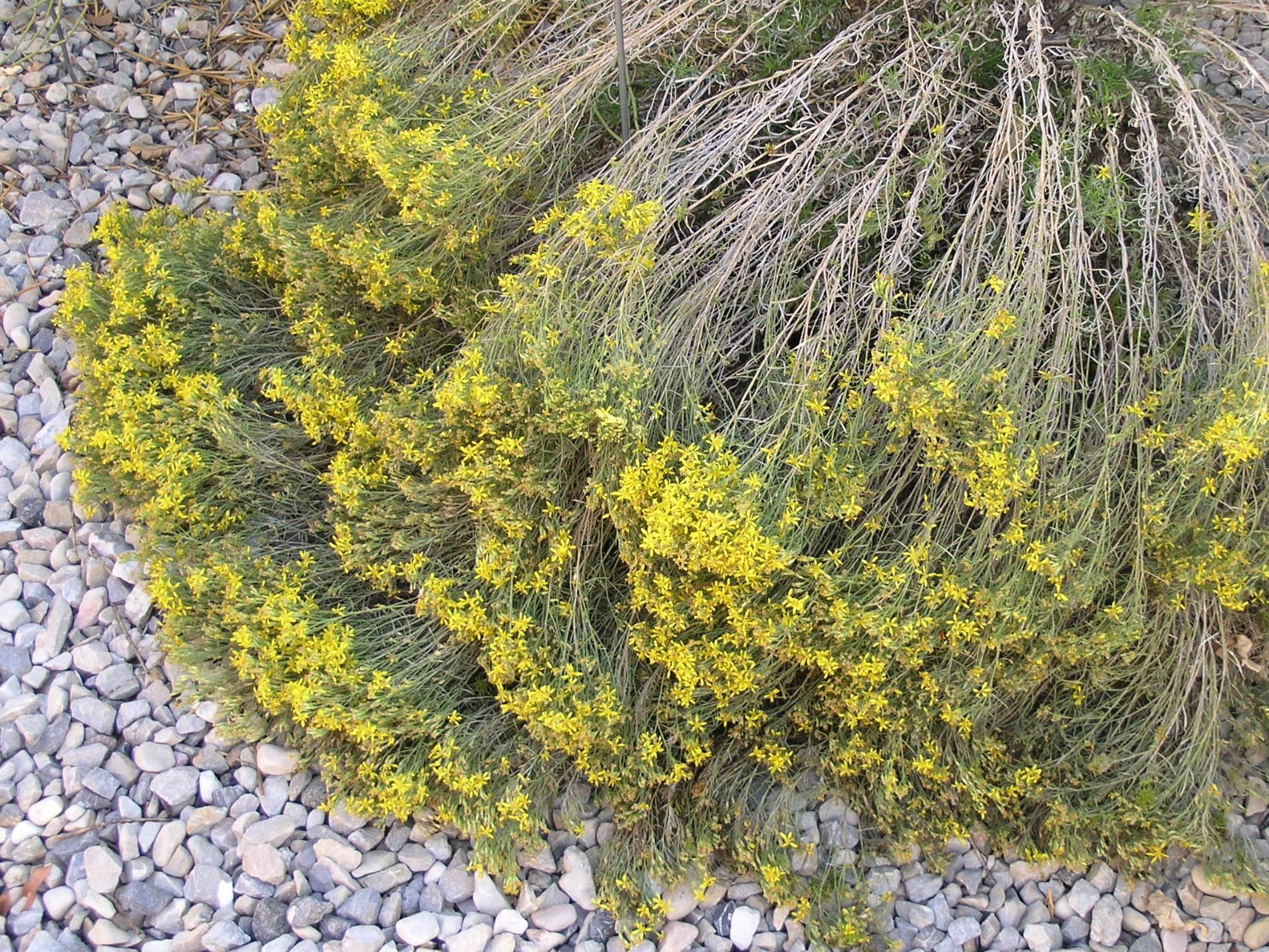
Broom Snakeweed Gutierrezia sarothrae
This small, mounding shrub is native throughout the Intermountain West. Mid-green linear leaves grow on twiggy branches. Produces clusters of golden yellow flowers in late summer. Unpalatable to wildlife. Plant in well-drained soils in full sun. Do not overwater or over-fertilize as it will cause the plant to grow overly vigorously and lose its form. May be hard to find in nurseries.
-

Bruns Weeping Serbian Spruce Picea omorika 'Pendula Bruns'
Elegant weeping evergreen. Small columnar tree. Great as a hedge, specimen or even planted in a mass. The two-tone silver and green foliage create interest all year long. Works in narrow spaces and smaller landscapes.
-
Buckeye Belle Peony Paeonia 'Buckeye Belle'
This bushy herbaceous perennial provides showy, velvety, deep red flowers with yellow stamens on sturdy stems with attractive foliage underneath. This neatly compact plant is both deer and disease resistant, as well as attractive to butterflies and other pollinators. It also makes a good cut flower. Prefers full sun but will tolerate some mild afternoon shade. Grows best in moderately moist, well drained soils. This is a cultivar of the hybrid Paeonia officinalis x P. lactiflora.
-

Budd's Yellow Dogwood Cornus sericea 'Budd's Yellow'
This multi-stemmed, rapidly-growing deciduous shrub has bright yellow stems provide great winter interest. Spreads by suckering but not invasively. Bright green leaves turn attractive shades of yellow, red and purple in the fall. Tiny yellow flowers are not very showy but turn to small white fruit that are preferred by birds. Younger branches have the best coloring. Remove 20-30% of the oldest branches each spring to stimulate growth and brighter coloring. Grows best with regular watering. The species, Cornus sericea, is synonymous with C. stolonifera and is native to Utah.
-

Buffalo Grass Buchloë dactyloides
Very hardy warm-season perennial shortgrass. Native to North American prairies. Light green grass blades turning tan to lavender when dormant. Spreads by stolons. Can be mowed and grown as a low water-use turfgrass. Fine blades are soft and will withstand considerable traffic. Grows best during the warmest part of the year (i.e. summer). Comes out of dormancy in early June and returns to dormancy in September. Left unmowed, the seed heads provide some interest. Will not tolerate high elevations, sandy soil, or shade.
-

Buffalo Juniper Juniperus sabina 'Buffalo'
Low-growing evergreen shrub with feathery, bright green foliage that retains excellent color through the winter. Tolerant of many soil types and will tolerate low water situations once established.
-

Bulbous Oat Grass Arrhenatherum elatius var. bulbosum 'Variegatum'
Clump-forming ornamental grass with a spreading tuberous root system. Long, slender leaves are variegated with green and cream stripes running the length of the leaf. May become invasive in areas with too much water or fertilizer. Plant in an area with room to grow. In colder regions, mildly attractive flowers will bloom on tall stalks, but there are rarely blossoms in areas with hot summer nights.
-

Bur Oak Quercus macrocarpa
Very large deciduous trees with quite uniform shapes. Light brown to grey bark is deeply ridged on older trees. Leaves are deeply lobed and, as with most members of the White Oak family, have rounded edges. Produces many acorns with a large cap that covers most of the shell. The acorns and leaves require some cleanup in highly maintained landscapes. Acorns are edible but may require some processing to remove the bitter tannins. Tolerant of many soil types.
-
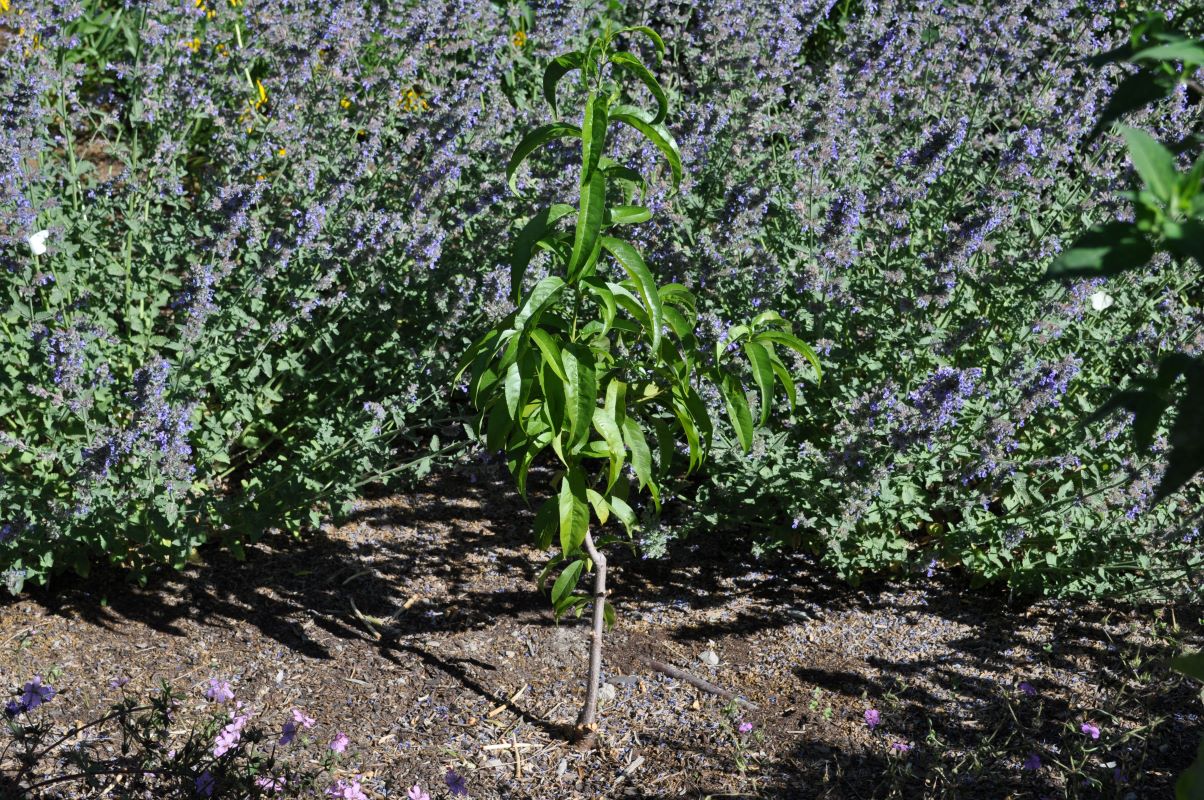
Burbank July Elberta Peach Prunus persica 'Burbank July Elberta'
This peach tree is loved for many reasons. It will add color and interest in your landscape with spring’s fragrant pink flowers. It then produces fruit with red skin and sweet, yellow flesh in late summer. The pit is small for the size of the fruit. It is self-pollinating and heat tolerant.
-

Burgundy Bunny Fountain Grass Pennisetum alopecuroides 'Burgundy Bunny'
This dwarf grass is both attractive and drought tolerant. Deep red streaks highlight the grass throughout the summer, followed by fluffy, white plumes. In the fall, the grass turns entirely red. It works well planted along borders, in containers or in mass-plantings.
-
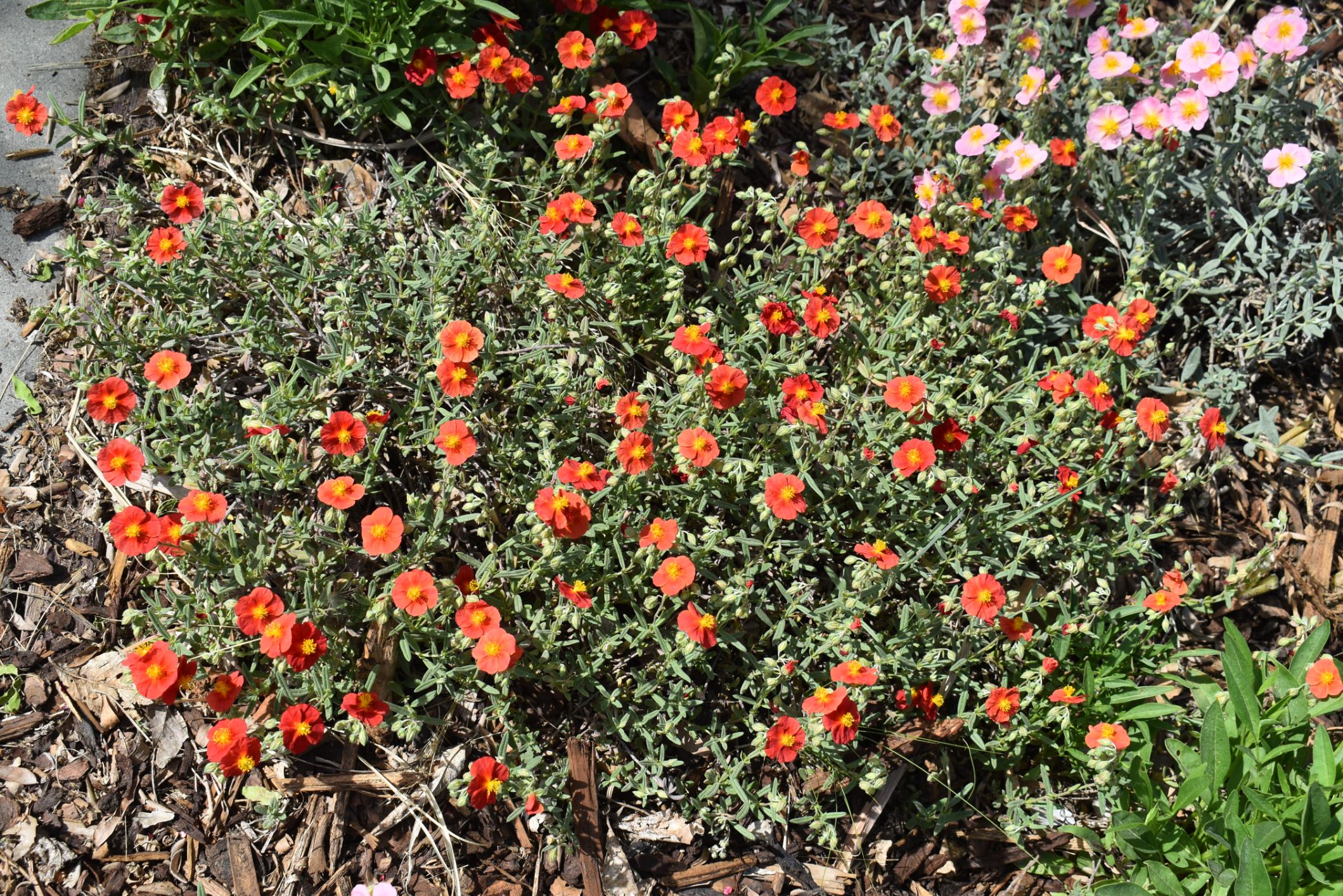
Burgundy Dazzler Sun Rose Helianthemum nummularium 'Burgundy Dazzler'
Drought tolerant and showy, this sun rose works well as a ground cover, in borders, or in naturalized areas. The burgundy-red flowers with yellow eyes begins blooming in early summer and prefers full sun. Foliage is evergreen.
-
Burgundy Lace European Filbert Corylus avellana 'Burgundy Lace'
A stunning ornamental shrub that can be made into a single-trunk tree if suckers are removed. New growth emerges a rich, burgundy red that fades to a dark, bronze-green with age. The leaves are heavily serrated with prominent veins, creating a textured surface and lacey look.
-
Burkwood Viburnum Viburnum x burkwoodii
Tall semi-evergreen multi-stemmed shrub with spring flowers that resemble large snowballs. Buds are pink and open with white flowers. Requires cross-pollination to produce inedible but visually interesting red-black berries in late summer to early fall. Can withstand some drought but prefers regular watering.
-
Bush's Lace Engleman Spruce Picea engelmannii 'Bush's Lace'
Upright growing conifer with pendulous branches. Slow growing tree. Grown for blue evergreen foliage that creates a skirt around its base as it ages.
-
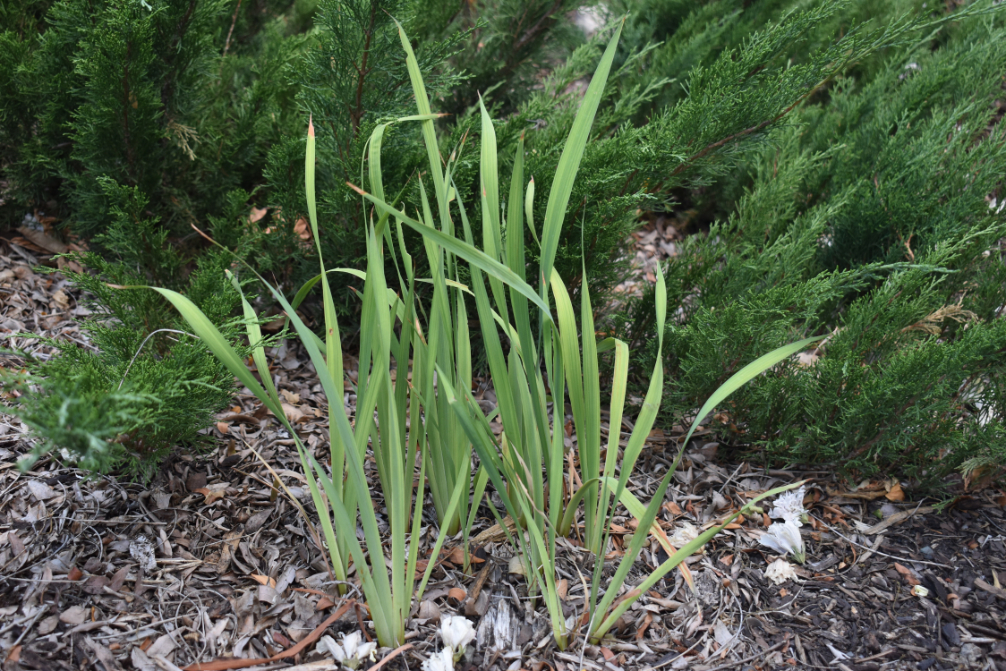
Butter and Sugar Siberian Iris Iris sibirica 'Butter & Sugar'
This herbaceous perennial produces delicate, creamy white and yellow flowers on top of arching, slender green leaves. The foliage will keep its color into the fall. It grows best in full sun but tolerates part shade. This Iris is perfect for planting in rain gardens, around ponds or water features, or in naturalized areas. It is also deer resistant and tolerant of clay soils.
-

Buzz Hot Raspberry Butterfly Bush Buddleja davidii 'Hot Raspberry'
Butterfly bushes have been loved by gardeners for centuries for their large flower clusters, long bloom time, and attractiveness to butterflies and other pollinators. This cultivar is set apart by large conical clusters of vivid raspberry-pink flowers in a compact frame. Enjoy a show of blooms, butterflies and pollinators all summer and fall.
-
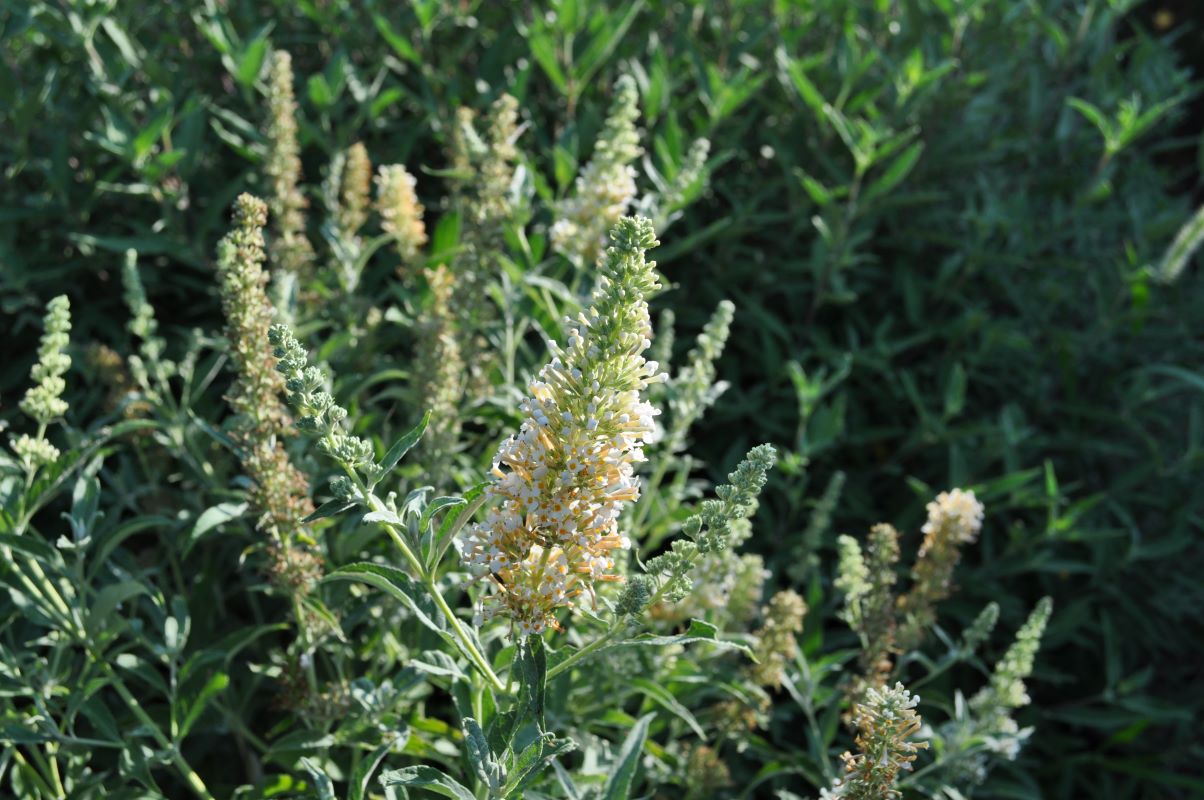
Buzz Ivory Butterfly Bush Buddleja 'Ivory'
Beautiful summer blooming shrub with spikes of ivory flowers. The Buzz Series butterfly bushes are more compact and won't take over in your landscape. It is attractive to butterflies.
-
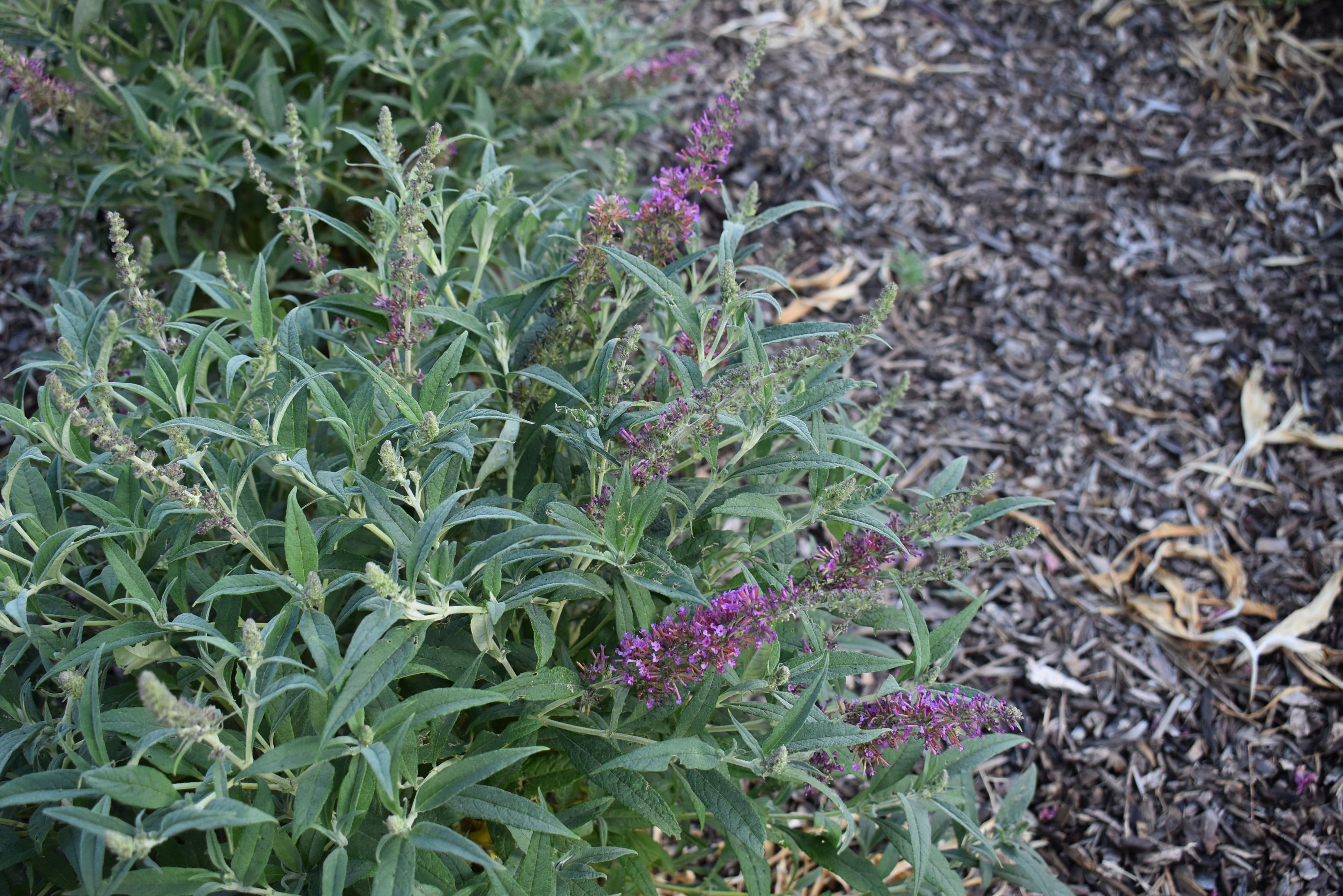
Buzz Magenta Butterfly Bush Buddleja davidii 'Tobudpipur'
Beautiful summer blooming shrub with spikes of magenta flowers. The Buzz Series butterfly bushes are more compact and won't take over in your landscape. It is attractive to butterflies.
-

Baby Blue Eyes Spruce
This dwarf evergreen grows at a slow rate, only two to three inches per year. Nice pyramidal shape with sharply pointed, four sided, blue-green needles arranged radially on the shoots. Prefers full sun.
Picea pungens 'Baby Blue Eyes'
Mature Size: 10-15' tall x 8-10' wide
-

Baby Cakes Blackberry
This thornless hybrid dwarf blackberry provides an excellent addition to any edible home garden. The small size of this plant makes it a good option for either patio containers or garden beds. Produces large, juicy berries usually two times per year on second-year canes.
Rubus 'APF-236T'
Mature Size: 3-4' tall and wide
-

Baby Sun Lanceleaf Coreopsis
A compact coreopsis with solitary, yellow, daisy-like flowers that have jagged petal tips. It blooms from late spring through the summer. Grows best in dry to medium well drained soil in full sun. Loves poor or rocky soils. Prompt deadheading of spent flowers encourages additional blooming. Does not self seed. Tends to sprawl if grown in moist or fertile soil.
Coreopsis grandiflora 'Baby Sun'
Mature Size: 15-20" tall x 12" wide
-

Bailey Compact American Cranberrybush
This dwarf version of the species grows significantly shorter. Three-lobed leaves are green, but not showy until the fall when they turn striking shades of red. It produces clusters of white flowers in spring followed by small red berries that the birds won't touch. It prefers plenty of moisture but will handle some drought.
Viburnum trilobum 'Bailey Compact'
Mature Size: 5-6' tall and wide
-

Bailey Red Twig Dogwood
Vigorous, suckering, deciduous shrub with deep-red winter shoots. Has dark green leaves turning to red or orange in autumn. Small white flowers appear in clusters up to 2 inches across in late spring, followed by white fruit. Grows best in full sun and well-drained, moderately moist soil. Berries are mildly toxic and may cause stomach aches. The species, Cornus sericea, is synonymous with C. stolonifera and is native to Utah.
Cornus sericea 'Baileyi'
Mature Size: 6' tall x 12' wide
-

Baja Daylily
Clump-forming herbaceous perennial with long, grass-like leaves. Large flowers are bright red with yellow centers and bloom throughout the summer. Tolerant of many soils, heat and low-water situations.
Hemerocallis 'Baja'
Mature Size: 24-30" tall x 18-24" wide
-

Bald Cypress
Although this conifer appears to be evergreen during the summer, it loses its needles in the late fall and winter, making it deciduous. The tall, conical tree grows broader with age. Can be found growing naturally in swampy areas but tolerates less water and somewhat dry conditions. Prefers acidic soil and should not be planted in soils with a pH higher than 7.5. Attractive bright green needles are quite flat and turn a bronze brown in the fall before falling off the tree. The base of the trunk is quite broad, even in youth and may form knobby "knees" in especially wet areas.
Taxodium distichum
Mature Size: 50-70' tall x 20-45' wide
-

Ballerina White Wand Flower
This whimsical, low-water perennial provides striking small white flowers on tall stalks above a mound of leaves. The deep-green foliage can have traces of red in them. It blooms early summer until September.
Gaura (syn Oenothera) lindheimeri 'Ballerina White'
Mature Size: 12-18" x 12-14" wide
-

Banana Cream Shasta Daisy
All summer long, this compact perennial displays creamy white blossoms with hints of yellow. The centers are a vibrant dark yellow. These flowers are held on sturdy, upright stems held above roughly toothed, elongated, elliptical leaves. This shasta daisy is great for garden beds, pots and cut flowers.
Leucanthemum x superbum 'Banana Cream'
Mature Size: 15-18" tall x 18-24" wide
-
Banana Yucca
Rosette-forming evergreen shrub. Long lance-shaped gray to blue-green leaves grow from the woody base. Leaf tips are quite stiff and form a sharp spine. Creamy white pendant flowers grow on tall stalks above the plant in spring. With two or more plants the flowers will grow an edible banana-shaped fruit that was used as a food source by native Americans. Requires little or no water once established.
Yucca baccata
Mature Size: 4' tall and wide
-

Bandwidth Maiden Grass
An upright, dwarf maiden grass with vibrant bands of yellow and green foliage. There are light, airy, golden-brown plumes that emerge in the fall and hold on through winter. This ornamental grass is great as an accent plant or grown in mass groupings.
Miscanthus sinensis 'Bandwidth'
Mature Size: 2.5-3' tall and wide
-

Bar Harbor Juniper
Low-growing evergreen shrub. Needles are scale-like when mature and more awl-like when younger. This cultivar does not flower or set fruit. The blue-green foliage turns purplish in the winter. Does not tolerate wet soils. Prefers hot and relatively dry sites. Though adaptable to many soils, this shrub prefers sandy soils.
Juniperus horizontalis 'Bar Harbor'
Mature Size: 8-12" tall x 5-6' wide
-

Barbara Mitchell Daylily
Clump-forming herbaceous perennial with long, grass-like leaves. Ruffled, soft-pink flowers bloom throughout the summer. Tolerant of many soils, heat and low-water situations.
Hemerocallis 'Barbara Mitchell'
Mature Size: 18-24" tall and wide
-

Baroness Schroder Peony
Clump-forming, bushy herbaceous perennial. Abundant mid-green deeply-lobed foliage grows on stiff upright stems. Large fragrant double white flowers are loose and irregularly margined. Plant in fertile well-drained soils. Tolerates some drought once established.
Paeonia lactiflora 'Baroness Schröder'
Mature Size: 2.5-3' tall and wide
-

Barren Strawberry
Low-growing groundcover that looks similar to a strawberry. Leaves are trifoliate and medium green with serrated edges. Flowers resemble those of the strawberry but are yellow and produce inedible fruit. Spreads readily and forms an attractive green carpet.
Waldsteinia ternata
Mature Size: 4-6" tall x 6-12" wide
-

Basin Wildrye
Large ornamental bunch grass native to much of North America especially the Great Basin. Foliage grows green to blue-green and begins to turn dormant in late-summer. Spiked seed head grow on tall stems above the clump. Tolerates a wide range of soil and water conditions.
Leymus cinereus
Mature Size: 2-5' tall x 1-3' wide
-

Basket-of-Gold
This low-growing, spreading perennial is covered in profuse yellow flowers. Its sprawling form is particularly attractive in rock gardens or on rock walls. The foliage is gray-green and fades somewhat in the summer heat.
Aurinia saxatilis
Mature Size: 6-12" tall x 12-18" wide
-

Batik Iris
Upright growing perennial with fragrant flowers. Blooms are short-lived and may only last for 3-7 days. Flowers are deep purple with white splashes and stripes. Long, lance-shaped leaves are attractive and deer resistant.
Iris 'Batik'
Mature Size: 24-26" tall x 18" wide
-
Beacon Hill Cedar of Lebanon
This weeping variety of the Cedar of Lebanon grows in a weeping form that can be trained to grow very tall or allowed to grow in a more meandering form. Short green needles are soft and grow on sweeping branches. It is adaptable to drought and poor soils but performs best with plenty of water.
Cedrus libani 'Beacon Hill'
Mature Size: 40-60' tall x 5-10' wide
-
Bear's Breeches
This plant has a clumping habit but can spread aggressively by creeping rootstocks. The leaves are glossy green with spiny, thistle-like leaves that arch to the ground. The flowers are pure white snapdragon-like flowers with reddish-purple hooded look. Flower spikes are 3-4 feet tall. They prefer average, well-drained soil and should not be overwatered.
Acanthus spinosus
Mature Size: 3-4' tall x 2-3' wide
-

Beargrass
Resembles a grass but is a member of the Agave family. Native to the southwestern United States. Very tolerant of a variety of soil conditions and requires little or no water once established. Spreads by rhizomes.
Nolina microcarpa
Mature Size: 4' tall x 6' wide
-

Beauty of Livermere Oriental Poppy
Deep red flowers on sturdy stems bloom in late spring. This cultivar is characterized by a dark blotch at the base of each crepe papery petal. The foliage dies back after blooming, so hide among perennials that will later cover the browning foliage.
Papaver orientale 'Beauty of Livermere'
Mature Size: 2.5-3' tall x 2' wide
-

Beavertail Cactus
Bristly succulent with gray-green, fleshy, flattened pads. Small needles are tinted red. Bright pink flowers bloom in spring. Prefers light soils and and little water once established.
Opuntia basilaris
Mature Size: 2' tall x 4' wide
-
Becky Shasta Daisy
This clump-forming perennial produces large, pure white flowers with yellow centers in late-summer to autumn. Its leaves are green and glossy with toothed margins. This cultivar is noteworthy as one of the largest growing shasta daisies. Plant it in well-drained soils. It will tolerate some drought but prefers moderate amounts of water.
Leucanthemum x superbum 'Becky'
Mature Size: 3-4' tall x 2-3' wide
-

Bees Jubilee Clematis
Large flowers in varying shades of pastel pink make an impact even in shady areas. A thick bar of magenta runs down the middle of each petal, creating a beautiful contrast for the creamy yellow stamens. Under ideal conditions, this vine puts on two flower shows: first in late spring to early summer, and another in late summer to early fall. When the flowers fade, attractive wispy seed heads follow. Perfect for spilling over containers, climbing up trellises and arches, or weaving its way through planting beds.
Clematis 'Bees Jubilee'
Mature Size: 8-20' tall and wide
-

Beijing Gold Tree Lilac
This beautiful, yet hardy tree is ideal for urban areas. It has an upright spreading habit with arching branches. Early summer brings creamy yellow blossoms. The foliage turns a golden yellow in fall that contrasts well with its cinnamon-colored bark.
Syringa pekinensis 'Zhang Zhiming'
Mature Size: 15-20' tall x 10-15' wide
-

Bella Blue Self-Heal
A vigorous, low-growing groundcover to quickly fill in gaps in sun or part shade. Round clusters of purple flowers bloom profusely from late spring to early fall. This European plant was traditionally used to treat injuries and diseases.
Prunella grandiflora 'Bella Blue'
Mature Size: 6-8" tall x 18-24" wide
-

Ben Ledi Sun Rose
Low-growing, evergreen, shrubby perennial. Small, silvery green, lance-shaped leaves are downy. Bears profuse deep pink rose-shaped flowers in late-spring to early-summer. Grows well as a groundcover or in rock gardens. Presents a very stunning show when covered with flowers.
Helianthemum 'Ben Ledi'
Mature Size: 12" tall x 24" wide
-

Ben More Sun Rose
Low-growing, evergreen, shrubby perennial. Small, silvery green, lance-shaped leaves are downy. Bears profuse bright-orange rose-shaped flowers in late-spring to early-summer. Grows well as a groundcover or in rock gardens. Presents a very stunning show when covered with flowers.
Helianthemum 'Ben More'
Mature Size: 12" tall x 24" wide
-
Berggarten Sage
This cultivar of the wonderfully aromatic culinary sage can be used ornamentally and for culinary purposes. 'Berggarten' has a more compact shape and wider, rounder leaves than other types of sage. This semi-evergreen shrub has rounded, fuzzy, gray-green foliage that takes on a hint of purple in the sun. Clusters of purple-blue flowers bloom on upright stems above the plant, attracting large numbers of bees and butterflies. Tolerates drought and heat, but do not overwater.
Salvia officinalis 'Berggarten'
Mature Size: 18-24" tall and wide
-

Berry Blue Honeyberry
This upright shrub has small, cream-colored flowers in the spring that give way to large, sweet fruit that taste like wild blueberries with a hint of currant. Honeyberries ripen much earlier than other fruits, such as a couple weeks before strawberries. They can be harvested in late May to early June. It requires two varieties with similar bloom time to pollinate such as Blue Belle, Blue Sky, or Blue Bird.
Lonicera caerulea var. edulis 'Berry Blue'
Mature Size: 4-5' tall and wide
-

Berry Garcia Itoh Peony
Clump-forming, bushy herbaceous perennial. Abundant mid-green deeply-lobed foliage grows on stiff upright stems. Large fragrant double peach flowers are loose and irregularly margined. Petals flare out from light to dark orange-pink, with contrasting yellow stamens in the centers. Plant in fertile well-drained soils. Tolerates some drought once established.
Paeonia 'Berry Garcia'
Mature Size: 2-2.5' tall and wide
-
Bertram Anderson Lungwort
A very dependable and showy spring-blooming perennial with attractive long, narrow, green foliage with silver spots. The pink buds open to reveal cobalt-blue flowers which bloom on the ends of arching stems and can add color to completely shady beds. They can handle some morning sun but need to be in afternoon shade to avoid leaf scorch. This Lungwort is semi-evergreen in warmer areas.
Pulmonaria longifolia 'Bertram Anderson'
Mature Size: 8-10" tall x 18-24" wide
-
Betty's Blue Lavender
Great multi-use plant used as an herb for its soothing fragrance and as a water-wise landscape plant. A compact, bushy shrub with gray-green leaves and a pretty Mediterranean look. The fragrant, deep purple to blue blossoms form on long stalks up to 3 inches long, in late spring to early summer. These can be harvested in their bud stage and dried for indoor use. Prefers full sun but can handle some shade.
Lavandula angustifolia 'Betty's Blue'
Mature Size: 12" tall x 12-24" wide
-
Beurre D'Anjou Pear
Deciduous, fruit-bearing tree. Pure white flowers bloom in mid-spring followed by medium to large pears that ripen in September. Unlike other pears, D'Anjou's ripen green with only a slight blush and are more tart than other pears. Requires moderate amounts of water to support fruit growth.
Pyrus communis 'Beurre D'Anjou'
Mature Size: 20-30' tall x 15-20' wide
-

Beverly Sills Iris
Upright growing perennial with fragrant flowers. Blooms are short-lived and may only last for 3-7 days. Flowers are bright pink. Long, lance-shaped leaves are attractive and deer resistant.
Iris 'Beverly Sills'
Mature Size: 24-26" tall x 18" wide
-

Beyond Blue Fescue
‘Beyond Blue’ was found in the Netherlands as a naturally growing mutation of the beloved ‘Elijah Blue’ fescue. This evergreen to semi-evergreen grass comes in neat, compact mounds of slender, cascading silver-blue foliage. Attractive tan seed heads stand above the foliage in late summer. A great choice for a dynamic groundcover or for areas needing a burst of color.
Festuca glauca 'Casca11'
Mature Size: 8-12" tall x 12-18" wide
-
Beyond Midnight Bluebeard
A very dependable and showy summer-blooming perennial with attractive long, narrow, green foliage with silver spots. The pink buds open to reveal cobalt-blue flowers which bloom on the ends of arching stems and can add color to completely shady beds. They can handle some morning sun but need to be in afternoon shade to avoid leaf scorch.
Caryopteris x clandonensis 'CT-9-12'
Mature Size: 2-2.5' tall and wide
-

Bicolor Sulfur-flowered Buckwheat
This evergreen perennial spreads into a mat of small glossy leaves and produces fluffy yellow clusters of flowers that become copper-red tinted with age. Begins flowering in early summer and continues until the fall. The leaves turn burgundy and remain attractive through the winter. Prefers moderate to dry well-drained soil. Do not overwater.
Eriogonum umbellatum var. dichrocephalum
Mature Size: 6-12" tall x 36" wide
-

Big Berta White Spruce
This hardy Spruce has long needles with an upright and narrow habit. Big Berta has a faster growth rate than other Spruces which results in more open branching.
Picea glauca 'Big Berta'
Mature Size: 12' tall and 6' wide
-

Big Betony
Upright-growing, hairy perennial. Broad, scalloped, green leaves are deeply veined. Hooded purple flowers grow in spikes on tall stems. Grows best in moderately fertile, well-drained soils. Reguires moderate amounts of water. Avoid excessive moisture during the winter months.
Stachys macrantha
Mature Size: 24" tall x 12" wide
-
Big Leaf Variegated Periwinkle
An evergreen groundcover with cream and green variegated leaves. Two-inch purple flowers bloom sporadically throughout the summer. Long, trailing stems root as they spread, forming a mat that prevents weeds and fills in large areas in sun or shade. Can handle unfavorable sites where other plants have failed.
Vinca major 'Variegata'
Mature Size: 8-18" tall x 12-24" wide
-
Big Sagebrush
Medium to large shrub common to Utah and the Intermountain West. Small blue-gray leaves are characterized by three lobes on the tips. Flowers are small and very inconspicuous. Very tolerant of many soil types. Overwatering can cause excessive growth.
Artemisia tridentata
Mature Size: 3-15' tall x 3-10' wide
-

Big Sky Summer Sky Coneflower
This is a hybrid coneflower that was developed by ItSaul Plants®. This perennial has multiple, upright-growing stems that produce large (up to 5 inch in diameter) salmon-peach to rose flowers throughout the summer. Prefers full sun and can survive with moderate to low amounts of water.
Echinacea 'Katie Saul'
Mature Size: 2-3' tall and wide
-

Big Sky Sundown Coneflower
New hybrid coneflower from ItSaul Plants® with deep orange colored flowers with slender petals and orange centers. Dark green leaves are lance-shaped and forms mounds. Makes an excellent cut flower. Attracts butterflies and other wildlife. Once established it can handle short periods of drought but performs best with moderate water.
Echinacea 'Evan Saul'
Mature Size: 2.5-3' tall x 12-18" wide
-

Big Sky Sunrise Coneflower
New hybrid coneflower from ItSaul Plants® with yellow colored flowers with slender petals and orange centers. Dark green leaves are lance-shaped and forms mounds. Makes an excellent cut flower. Attracts butterflies and other wildlife. Once established it can handle short periods of drought but performs best with moderate water.
Echinacea 'Sunrise'
Mature Size: 2.5-3' tall x 18-24” wide
-

Big Sky Twilight Coneflower
New hybrid coneflower from ItSaul Plants® with rosy-red colored flowers with slender petals and dark red centers. Dark green leaves are lance-shaped and forms mounds. Makes an excellent cut flower. Attracts butterflies and other wildlife. Once established it can handle short periods of drought but performs best with moderate water.
Echinacea 'Twilight'
Mature Size: 24-30" tall x 18" wide
-
Big Tuna Mugo Pine
Medium to large rounded to spreading evergreen shrub. Spreading branches are scaly and gray. Dark green needles are born in pairs up to three inches long. Bears dark brown female cones. May require some pruning to shape, simply prune the new growth or "candles." Tolerant of many soil types. Needs well drained soils and fairly drought tolerant.
Pinus mugo 'Big Tuna'
Mature Size: 6-8' tall x 4-6' wide
-

Bigroot Geranium
As suggested by the name, this geranium has thicker rhizomes than many other geraniums making it more adaptable to dry soils and difficult climates. It forms spreading clumps and will form a groundcover over time. Its five-petaled flowers are shades of pink, usually on the lighter side.
Geranium macrorrhizum
Mature Size: 12-18" tall x 18-24" wide
-

Bigtooth Maple
This deciduous tree native to the Western United States has outstanding fall color varying from red to yellow depending on the climate. It tends to stay relatively small when grown in the Salt Lake valley, although it may grow larger in ideal conditions. It often has multiple stems but can be trained to grow on a single trunk. Requires occasional deep soaking to keep healthy. Subject to winter sunscald on bark and some chlorosis. Avoid Rocky Mountain Glow variety due to inferior performance in Utah.
Acer grandidentatum
Mature Size: 15-30' tall and wide
-
BioBlue Kentucky Bluegrass Mix
Cool-season turf-grass with attractive blue-green foliage. This variety, distributed by BioGrass Sod Farms, is a mixture of the more drought tolerant varieties. This mix consists of Moonlight, Prosperity, and Moonlight II varieties of Kentucky bluegrass as well as Silver Dollar and Road Runner perennial rye grass.
Poa pratensis (group)
Mature Size: 6" tall x 4" wide
-

Biokovo Cranesbill
Low-growing herbaceous perennial that spreads by rhizomes. Produces masses of white flowers with pink hues at their throats. Under preferrable conditions it can form a dense mat. Dark green foliage is rounded and slightly lobed.
Geranium x cantabrigiense 'Biokovo'
Mature Size: 6-12" tall and wide
-

BioMeadow Fine Fescue Mix
A mixture of fine fescue grasses including hard fescue (Festuca brevipila), chewings fescue (Festuca rubra subsp. commutata) and red fescue (Festuca rubra). Fine dark green leaves grow from a crown near the soil. Handles cold temperatures well and can be left unmowed for a meadow appearance. It is reported to require less water and fertilizer than Kentucky bluegrass and performs well in both sun and shade. This particular mix is available through BioGrass Sod Farms.
Festuca spp.
Mature Size: 8-12" tall x 6-8" wide
-
BioNative Wheatgrass Mix
A mix of grasses specifically selected to adapt to Utah soils and climate. Species include Critana Thickspike Wheatgrass (Agropyron dasystachym 'Critana'), Fairway Crested Wheatgrass (Agropyron cristatum 'Fairway') and Rosana Western Wheatgrass (Pascopyrum smithii 'Rosana'). Will reach one to three feet tall if left unmowed. Cool season grasses keep a suitable green color throughout the year. Great choice for low-maintenance lawn areas.
Agropyron spp.
Mature Size: 12-36" tall x 12" wide
-
BioTurf Dwarf Fescue Mix
Deep rooted, dark green, cool season perennial turf grass. Tolerates some shade, foot traffic and recovers well after drought. Does best in well drained clay soils. Uses less water than Kentucky bluegrass with a similar look. Tall-fescue leaf blades are generally more coarse but this variety was grown for a finer texture. Best kept cut at 3 inches or longer. Improvements are constantly being made in the varieties available commercially. Consult your local sod or seed provider for information on the best varieties available.
Festuca arundinacea 'Bolero'
Mature Size: 2-3' tall x 12-18" wide
-

Birch's Double Cranesbill
Clump forming perennial with mid-green leaves. Purplish-pink flowers are double with shades of blue and resemble tiny roses. Attractive, finely cut leaves are deeply veined. May not be as vigorous as the species. Somewhat tolerant of drought and poor soils but prefers regular water and fertile soils.
Geranium himalayense 'Plenum'
Mature Size: 10" tall x 24" wide
-

Bird Cherry
Also called European Birdcherry. Medium to small deciduous tree and close relative of the native Chokecherry. Spring brings pendulous clusters of white flowers followed by small bitter black edible berries that may be better left for the birds. Serrated green leaves turn yellow in the fall. A very adaptable and easy to grow tree.
Prunus padus
Mature Size: 20-40' tall and wide
-

Bird's Nest Spruce
A shrubby low-growing variety of Norway Spruce. Forms dense bowl-shaped mounds resembling a bird's nest, hence its name. Needles are dark green and grow up to one-and-a-half inches long. Common choice in traditional landscapes due to its adaptability.
Picea abies 'Nidiformis'
Mature Size: 3-6' tall and wide
-

Bishop's Hat
A shade-loving, rhizomatous, clump-forming perennial. It's primarily used as a groundcover in shady areas. The leaves are shaped like a bishop's mitre and hence the common name was coined. Leaves emerged in the spring red-tinged but turn green as they mature. Red and yellow flowers bloom in early spring. This is a good plant for dry shade.
Epimedium x rubrum
Mature Size: 6-12" tall x 12-18" wide
-

Black Beauty Coral Bells
This is a beautiful Heuchera with dark purple, glossy, ruffled semi-evergreen leaves. It has small light pink to white flowers which appear on tall, dark stems in the early summer. These dark, rich colors contrast well with variegated, gray-green and golden foliage plants. This plant can be evergreen, but in harsh winters it might die back and come up from the roots the next year.
Heuchera 'Black Beauty'
Mature Size: 10-16" tall x 24" wide
-

Black Beauty Elderberry
Medium to large deciduous shrub with purple leaves. A cultivar of the European Elderberry. Pinkish-white flowers appear in early summer turning to black fruit. Flowers are lemon scented. Berries are edible and very attractive to wildlife. Have been used to make jams, jellies, and wine. Fruit is not considered as useful as that of the American Elderberry. Leaves and stems are considered mildly toxic.
Sambucus nigra 'Gerda'
Mature Size: 8-15' tall x 4-8' wide
-

Black Chokeberry
Upright, multi-stemmed shrub native to the eastern United States. Dark-green glossy leaves turn wine-red in winter. Clusters of small white flowers bloom in May and are followed by black astringent berries. Berries are edible and have been used to make jams and jellies, but are best left to the wildlife. Tolerates a wide range of soil types.
Aronia melanocarpa var. elata
Mature Size: 5-6' tall and wide
-

Black Flowering Fountain Grass
Dense, clump-forming, perennial grass with foxtail-like inflorescenses. Has narrow, mid-green leaves up to half an inch wide. Tiny creamy-white flowers are begin blooming in June. Very attractive foxtails last into fall. Prefers full sun. Moderately drought tolerant. Shorter than average species height.
Pennisetum alopecuroides 'Moudry'
Mature Size: 2-2.5' tall x 18-24" wide
-
Black Hills Spruce
A slower-growing drought tolerant variety of white spruce. Very dense growth makes it good for wind screens. Bright green foliage turns to bluish-green with age. Makes a great accent plant.
Picea glauca 'Densata'
Mature Size: 40' tall x 20' wide
-

Black Knight Butterfly Bush
Beautiful medium to large shrub flowering shrub. Can be pruned back to desired height each year, even to the ground if desired. Once established, this plant is tolerant of many conditions. Attracts butterflies and bees. This variety is hardier than most and develops extremely dark purple flowers in long panicles.
Buddleja davidii 'Black Knight'
Mature Size: 10-12' tall x 8' wide
-

Black Lace Elderberry
Dark lacy leaves characterize this cultivar of the European elderberry. Pink, lemon scented flowers in the spring to early-summer add to it's beauty. This shrub is an excellent replacement for the Japanese maple as it is more suited to the Utah landscape. It does produce berries that, while edible when cooked, are not as useful for jams and jellies as the American elderberry.
Sambucus nigra 'Eva'
Mature Size: 6-8' tall and wide
-

Black Mondo Grass
These slender, jet-black leaves will be a standout in the garden. This is a unique grass-like specimen for borders or rock gardens in partially shaded areas. It grows in arching clumps with pale purple-pink bell-shaped flowers which bloom in the summer.
Ophiopogon planiscapus 'Nigrescens'
Mature Size: 12" tall and wide
-

Black Pearl Eastern Redbud
A unique cultivar of a classic American tree, with glossy, eggplant-purple leaves that appear almost black. In early spring, vivid pink-purple flowers coat the length of the bare branches. Its graceful open shape is well suited to woodland borders, and its striking color makes it an eye-catching focal specimen.
Cercis canadensis 'JN16'
Mature Size: 15-20' tall x 20-25' wide
-

Black Sagebrush
Evergreen, woody shrub native to the western United States. Elongated leaves with 3-lobed tips are more gray than green. Similar in appearance to A. tridentata except for more compact form. Inconspicuous yellow flowers bloom during the summer. Bark is colored black. Plant in well-drained soils and do not overwater. Works will in informal dry landscape areas.
Artemisia nova
Mature Size: 12-24" tall and wide
-

Black Tower Elderberry
The dramatic deep burgundy foliage makes this upright deciduous shrub a statement in any garden. Bright pink flowers stand out against the dark leaves. Spring flowers turn to blackish berries in the fall. If flowers are not deadheaded berries can be harvested for wine and jam or left for wildlife to enjoy.
Sambucus nigra 'EIFFEL 1'
Mature Size: 6-8' tall x 3-4' wide
-
Black Walnut
Large deciduous tree valued for its hard wood. Nuts are edible and can be messy when they fall. Black walnuts produce a natural growth inhibitor that can cause plants beneath it to grow slowly or die. Usually best planted in large open areas such as parks. May drop its leaves in extreme drought situations.
Juglans nigra
Mature Size: 60-70' tall x 50-70' wide
-

Blackhawks Big Bluestem
This upright native ornamental grass is a colorful accent plant for any landscape. It has slender leaves that begin dark green and turn purple when nights start to cool down. The foliage will be nearly black by mid-fall. Late summer brings beautiful purple-red, flowering stems that rise high above the foliage and are 3-pronged like turkey feet.
Andropogon gerardii 'Blackhawks'
Mature Size: 4-5' tall x 12-24" wide
-

Blackout Coral Bells
This coral bell was given the name “Blackout” for its densely packed, glossy, nearly black leaves. The foliage retains its attractive dark purple foliage throughout the growing season. Summertime brings creamy white blossoms that open into airy, dainty panicles atop long, slender stems. They stand out against the rich foliage beneath.
Heuchera villosa 'Blackout'
Mature Size: 6-10" tall x 12-14" wide
-

Blanc Double de Coubert Rose
This beautiful, fragrant rose is a long-blooming, disease resistant option that thrives in full sun and has some shade tolerance. Attractive deep green foliage provides a nice contrast to the large, beautiful, semi-double pure white flowers. This plant prefers moderately moist, loamy soil with regular, deep watering’s. If cared for properly, it can continue blooming all summer long and up until the first frost.
Rosa 'Blanc Double de Coubert'
Mature Size: 4-7' tall x 3-5' wide
-
Blaze Little Bluestem
This tall, upright ornamental grass will add colorful interest to the landscape. The slender grass blades start off light blue in spring, darken to gray-green in summer and eventually burst with deep reds in the fall. The reds fade into vivid pinks as winter approaches. Summer also bring reddish-brown flowers that sit high above the foliage. They turn into feathery, silver-white seed heads that can persist through winter. Grows in clumps up to eighteen inches across. Grows well in many soil including alkaline and clay. Requires little water once established.
Schizachyrium scoparium 'Blaze'
Mature Size: 2-3' tall x 18" wide
-

Blaze of Glory Climbing Rose
Showy and lightly fragrant, this fiery orange and coral-colored climbing rose is an excellent option for adding brilliant summer color to any full-sun landscape. This climbing rose is a good candidate for growing up fences, pillars or arbors. It prefers moderately moist, well-drained soil, and is disease resistant.
Rosa 'Blaze of Glory'
Mature Size: 12-14' tall x 5' wide
-

Blazing Star
Upright clump-forming perennial that is attractive to bees and butterflies. Spikes of pink-purple flowers appear in the summer opening from the top downwards. Multiple stalks arise from basal tufts of narrow leaves. Will tolerate some drought and poor soils but prefers moderate amounts of water in fertile soils. Requires full sun. Makes excellent cut flowers.
Liatris spicata
Mature Size: 2-4' tall x 8-18" wide
-
Blireana Plum
A cross between Cherry Plum (Prunus cerasifera 'Pissardii') and Japanese Apricot (Prunus mume). This small deciduous tree produces a multitude of double, pink, fragrant flowers in early spring. Long slender branches are covered with dark-purple leaves that turn greenish-purple in the summer. This hybrid is sterile and does not produce fruit. Prefers moderate moisture but tolerates some drought.
Prunus x blireana
Mature Size: 20' tall and wide
-

Blizzard Mock Orange
Multi-stemmed deciduous shrub developed in Alberta, Canada. Selected for its exceptional cold-hardiness and profuse, large, white flowers. Flowers are single with 4-6 petals and very fragrant. Blooms begin in spring and last up to 4 weeks. Tolerates some shade but produces more flowers in full sun. Requires low to moderate amounts of water.
Philadelphus lewisii 'Blizzard'
Mature Size: 4-6' tall x 8-10' wide
-

Blizzard Pearl Bush
This shrub has an upright, rounded form. It has a brilliant show of white, frilly flowers that bloom in the spring. This plant is adaptable to most soils, but does prefer good drainage.
Exochorda 'Blizzard'
Mature Size: 4-6' tall and wide
-

Blonde Ambition Blue Grama Grass
Introduced by David Salman of High Country Gardens, this surprising selection of blue grama boasts chartreuse seed heads held horizontally above the blue green foliage, creating a lovely contrast. Provides great winter interest if left uncut. Requires little care and is adapted to Utah conditions.
Bouteloua gracilis 'Blonde Ambition'
Mature Size: 8-24" tall x 8-18" wide
-

Bloody Cranesbill
Low-growing, compact, clump-forming perennial. Dark green leaves are deeply toothed and smaller than other geraniums. Rose-pink to purple flowers mainly bloom in spring but reappear to a lesser degree throughout the year. Will tolerate some drought. Prune to keep it to a desirable size.
Geranium sanguineum
Mature Size: 8-12" tall x 12-18" wide
-

Bloomerang Dark Purple Lilac
A reblooming hybrid lilac with dark purple flowers in mid spring and again in late summer. The lilacs in the Bloomerang series are extremely disease resistant and enjoy full sun, making them an easy-care choice. Pruning should only be done after the spring flush of blooms, and only if desired. The second bloom occurs on new growth after the spring bloom.
Syringa 'SMSJBP7'
Mature Size: 4-6' tall and wide
-

Bloomerang Pink Perfume Lilac
This is a reblooming lilac with fragrant pink flowers that bloom in mid spring and again in late summer. The lilacs in the Bloomerang series are extremely disease resistant and enjoy full sun, making them an easy-care choice. Pruning should only be done after the spring flush of blooms, if desired. Second bloom occurs on new growth after the spring flush.
Syringa 'Pink Perfume'
Mature Size: 4-6' tall and wide
-

Bloomerang Purple Lilac
A deciduous flowering shrub with clusters of purple flowers that first appear in spring, but unlike most lilacs, reblooms again in summer lasting into fall. This hybrid lilac is a compact form.
Syringa 'Penda'
Mature Size: 4-5' tall and wide
-
Blue Angel Hosta
A hardy perennial that grows in large mounds of thick, rough, wide, oval shaped leaves. The noticeable ribbed veins create additional texture. These leaves come in an attractive shade of blue-green and will bring out the best blue color in light shade. In mid-summer, tall, slender stems rise above the foliage and the tops are covered in dainty, bell-shaped blossoms that come in pale lavender to pure white.
Hosta 'Blue Angel'
Mature Size: 2-3' tall x 3-4' wide
-
Blue Arrow Juniper
Slow-growing evergreen tree with a narrow upright habit. Perfect where space is limited or as a tall screen. Has scale-like needles with attractive blue-green foliage. Reddish-brown bark peels off in long strips. Requires full sun and will tolerate alkaline soils and drought.
Juniperus scopulorum 'Blue Arrow'
Mature Size: 12-15' tall x 2' wide
-

Blue Balloon Bluebeard
This medium sized shrub is best treated as a perennial along the Wasatch Front. Cut back in the fall or early spring to promote fresh new growth each year. Prefers drier soils and full sun. Produces small blue flowers clustered together along each long stem. This variety has a spherical habit, from which "balloon" in the common name is derived. Dark green foliage has a silvery underside. It's fast growing and fragrant.
Caryopteris x clandonensis 'Korball'
Mature Size: 2-3' tall x 2' wide
-
Blue Beaked Yucca
This yucca is usually single trunked and has a treelike habit. The blue-green foliage is evergreen and forms a pom-pom shape on top of the trunk. The narrow foliage is about 2 feet long and has sharp tips. It has beautiful white, bell shaped flowers. It requires very little water.
Yucca rostrata
Mature Size: 6-15' tall x 4-10' wide
-

Blue Bell Bellflower
Strong growing, compact, small mounding plant with leafy base. The foliage is shaped similar to that of a small peach tree. Blue cup shaped flowers bloom in summer. Choice plant for borders.
Campanula persicifolia 'Blue Bell'
Mature Size: 2-3' tall x 12-18" wide
-

Blue Bird Rose of Sharon
Vigorous, multi-stemmed, upright, deciduous flowering shrub. Numerous showy, violet-blue, 5-petaled flowers with purple eyes are borne throughout the summer. Attractive 3-lobed, coarsely toothed leaves grow on erect stems. Tolerant of heat, drought, and poor soils. Prefers fertile soils with moderate amounts of water.
Hibiscus syriacus 'Blue Bird'
Mature Size: 8-10' tall x 6-8' wide
-

Blue Boa Hyssop
This is a showy, low-maintenance, clumping perennial. It provides a brilliant show of deep, violet-blue flowers which bloom June-September. Flower spikes bloom above the aromatic, green foliage. Well-drained soils are preferred.
Agastache 'Blue Boa'
Mature Size: 2-3' tall x 1-1.5' wide
-

Blue Bouquet Speedwell
Clump-forming perennial with ascending, tapered spikes dark violet blossoms during early summer. Dark green leaves are lance-shaped and grow on short stems Prefers full sun and well drained soil. A great cut flower. Attracts bees and butterflies.
Veronica spicata 'Blue Bouquet'
Mature Size: 12-24" tall x 18" wide
-

Blue Chip Juniper
Low-growing evergreen shrub with steel-blue foliage that turns purplish in the winter. Forms a dense mat that keeps out weeds and minimizes maintenance. This cultivar does not flower or set fruit. This is a fairly adaptable plant that thrives in hot, dry sites. Prefers sandy soils and does not tolerate wet soil.
Juniperus horizontalis 'Blue Chip'
Mature Size: 6-8" tall x 7-8' wide
-

Blue Clips Bellflower
Low-growing herbaceous perennial. Violet-blue bell shaped flowers grow profusely in mid to late-spring. Forms a mass of small dark-green leaves that stay compact and mounded. Prefers moderate amounts of water and organic soils. Use mulch to keep the soil cool. Needs moderate watering during the heat of the summer.
Campanula carpatica 'Blue Clips'
Mature Size: 6-8" tall x 12" wide
-

Blue Diddley Chastetree
Although referred to as a tree within its name, it acts as a rounded, dwarf shrub with slender, green foliage that can have a slight silver sheen to it. Spikes full of lavender-blue blossoms contrast beautifully with the foliage throughout summer. Blue Diddley Chaste Tree is a colorful addition to perennial planting beds and mixed borders.
Vitex agnus-castus 'SMVACBD'
Mature Size: 3-6' tall and wide
-

Blue Dwarf Sea Holly
Clump-forming, herbaceous perennial with tall clusters of unique, spiky blue flowers. Leathery, blue-green, spiny leaves grow from basal rosettes and also on upright-growing stems. Plant in well-drained soils. Prefers moderately fertile to poor soils. Protect from excessive winter moisture.
Eryngium planum 'Blauer Zwerg'
Mature Size: 20" tall x 18" wide
-

Blue Flax
Also known as Lewis Flax or L. lewisii, this upright native perennial has delicate, vivid blue blooms that come in spring and disappear by June. Fine green leaves grow in hardy clumps. Named after Lewis of the Lewis & Clark Expedition who discovered it in North American prairies.
Linum perenne var. lewisii
Mature Size: 24" tall x 12" wide
-

Blue Fortune Hyssop
This long blooming, upright perennial is a late summer beauty. Five inch tall spikes of sky blue flowers bloom in mid-summer through autumn and are loved by bees and other pollinators. Its large triangular green leaves are silver underneath. The plant has a slight mint fragrance which is more apparent when leaves are bruised. Prefers moderate amounts of moisture.
Agastache 'Blue Fortune'
Mature Size: 3' tall x 18" wide
-
Blue Giant Glory-of-the-Snow
As implied by the name, this bulb blooms in early-spring sometimes before the snow melts. Blue flowers with white centers bloom prolifically over thin green leaves. They are ephemeral, disappearing as the weather warms, avoiding drought all together.
Chionodoxa forbesii 'Blue Giant'
Mature Size: 6-8" tall and wide
-
Blue Globe Onion
Clump-forming herbaceous perennial with dramatic, blue, globe-shaped flower clusters that bloom in mid to late spring. Long, thin, strap-like leaves grow basally. Enters dormancy after flowering and will die back to the ground only to rebloom next year.
Allium caeruleum
Mature Size: 12-24" tall x 6-12" wide
-

Blue Glow Globe Thistle
This upright-growing perennial grows up to 4 feet tall, topped with thistle-like steel-blue flower heads in the summer. The leaves are spiny and dissected with a rough, dark-green top and downy-white underneath. It is tolerant of many soil types but generally prefers soils that aren't too organically rich. It grows easily from seed and is difficult to transplant due to its large tap root. Deadheading helps to prevent it spreading by seed in the garden.
Echinops banaticus 'Blue Glow'
Mature Size: 24-48" tall x 12-24" wide
-
Blue Grama
A low-growing bunch-type grass native to the northwestern United States plain. This grass can either be left natural, showing off wispy, yellow to tan seed heads or it can be planted densely and mowed short to form a warm season, water-conserving lawn. As a lawn, this grass greens up during May-June and grows well in the heat but will reach dormancy in September.
Bouteloua gracilis
Mature Size: 24" tall x 10" wide
-
Blue Haze Euphorbia
Compact mounding perennial with outstanding narrow blue-green leaves. Summer brings bright yellowish-green flowers. Foliage provides year-round interest. Does not require large amounts of water. Hardy plant needs very little attention.
Euphorbia 'Blue Haze'
Mature Size: 18" tall x 24" wide
-

Blue Hill Sage
Clump-forming perennial. Dark-green, scalloped leaves grow basally. Bears spike-like clusters of pure blue flowers in summer to fall. Flowers are attractive to bees and butterflies. Tolerant of drought. Prefers dry to medium wet soils. Do not overwater.
Salvia x sylvestris 'Blauhügel'
Mature Size: 18-24" tall x 12-18" wide
-
Blue Ice Arizona Cypress
This is a small, fast growing evergreen tree. It works well as a single specimen or row for windbreak. It is perfectly suited for a home evergreen tree due to its small size. This plant has an upright, pyramidal form with handsome blue-grey foliage. It is drought tolerant once established.
Cupressus arizonica 'Blue Ice'
Mature Size: 20-25' tall x 10-12' wide
-

Blue Ice Blue Star
This is a long-blooming, compact Amsonia that blooms longer and has stronger stems than the original species. The deer-resistant foliage turns bright yellow in fall. It blooms in early spring with very dark blue-lavender flowers.
Amsonia 'Blue Ice'
Mature Size: 12-18" tall and wide
-

Blue Marvel Sage
Spikes of violet flowers bloom in early summer over a mound of aromatic, dark green foliage. As the summer progresses, the flowers and the foliage fade. Cutting back the foliage to the basal leaves will result in new growth and blooms, up to three re-blooms in a year in Utah. The plant is drought tolerant once established.
Salvia nemorosa 'Blue Marvel'
Mature Size: 10-12" tall and wide
-

Blue Mist Penstemon
This small penstemon can be found growing in the foothills of Colorado and Wyoming. Dainty spikes of sky blue flowers bloom on upright stalks. The foliage is dark green and the basal rosettes are evergreen.
Penstemon virens 'Blue Mist'
Mature Size: 8" tall x 8-10" wide
-

Blue Moon Wisteria
This climbing vine is a selection of a wisteria native to the southcentral United States. Though less aggressive than other wisterias, this variety is more cold hardy. Clusters of blue pea-like flowers can create a stunning floral display, but the vine may need several years to establish before blooming. This variety may bloom up to three times through the growing season.
Wisteria macrostachya 'Blue Moon'
Mature Size: 15-25' tall x 4-8' wide
-

Blue Moon Woodland Phlox
A large-flowered cultivar of Woodland Phlox, a wildflower native to the Midwest. Clusters of overlapping 5-petalled pastel purple flowers give this perennial a timeless, romantic look. The loosely trailing stems from a low mat of dark, semi-evergreen leaves. Perfect for partly shady woodland gardens. Could be used as a groundcover if planted densely. Prefers moist soil.
Phlox divaricata 'Blue Moon'
Mature Size:
-

Blue Muffin Arrowwood Viburnum
A charming, compact cultivar of a North American native shrub, with many clusters of cream-colored flowers in spring and vibrant blue fruits that ripen in late summer and persist into the winter. The tidy green foliage turns shades of apricot and red in the fall. This shrub is perfect for providing visual structure in the landscape while also benefiting songbirds and pollinators.
Viburnum dentatum 'Christom'
Mature Size: 5-7' tall x 6-8' wide
-

Blue Oat Grass
Evergreen, perennial bunch grass forming a hemispherical mound of bright grey-blue leaves. Bears upright stems with straw colored seed heads in late spring to early summer Prefers well drained, moderately fertile soil and full sun.
Helictotrichon sempervirens
Mature Size: 1-2' tall and wide
-

Blue Queen Sage
Upright, multi-branched perennial. Mid-green leaves are scalloped and often clasping. Bears dark violet-blue flowers on upright spikes from early summer into autumn. Adaptable to varied types of soils. Prefers full sun to minimal shade. Do not overwater.
Salvia x sylvestris 'Blaukönigin'
Mature Size: 2' tall and wide
-

Blue Sage
An upright, woody-based perennial with several branched stems having mid-green, grey-green foliage. Produces beautiful pure blue blossoms in dense clusters from late-summer to autumn. Prefers dry to medium moist soils and requires full sun.
Salvia azurea
Mature Size: 3-5' tall x 2-4' wide
-

Blue Softie Engelman Spruce
Slow-growing evergreen conifer. Dense growth takes a pyramidal form. Provides winter interest. Soft blue foliage color contrasts the needle's pointy texture.
Picea engelmannii 'Blue Softie'
Mature Size: 3' tall x 18" wide
-

Blue Spires Russian Sage
Upright-growing perennial or subshrub. Deeply cut grey-green aromatic leaves grow on tiered branches. Small, tubular, lavender-blue flowers appear in late-summer and are the best feature of this plant. Looks best when cut down to the ground each year. Plant in well-drained soils in a spot with plenty of room to grow.
Salvia yangii (syn Perovskia atriplicifolia) 'Blue Spire'
Mature Size: 2-3' tall and wide
-

Blue Spruce Stonecrop
A low growing succulent with fine, blue, needle-like leaves. It spreads, but isn't overly aggressive. Yellow flowers bloom in early summer, but aren't showy. It tolerates heavy soils and drought.
Sedum reflexum 'Blue Spruce'
Mature Size: 6-8" tall x 15-18" wide
-

Blue Star
This native of the Southeastern United States is a clump-forming perennial and can often be found growing naturally in thickets. Pyramidal clusters of light-blue flowers bloom in May. The leaves are a classic green but may turn attractive shades of yellow in the fall. It tends to lean if not grown in full sun. Though it prefers consistently moist soils, it will tolerate some drought.
Amsonia tabernaemontana var. salicifolia
Mature Size: 2-3' tall and wide
-

Blue Vervain
Rough, sharply toothed foliage grows in irregular clumps. Attractive flower spikes sit high above the foliage on hairy, extremely slender candelabra-like branching stems. The spikes are made of tiny, densely packed, purple-blue flowers and are enjoyed for most of summer and may even last into early fall. Blue Vervain prefers wet soil (although it can handle moderate dryness) making it perfect for rain gardens, bioswales and along waterways.
Verbena hastata
Mature Size: 2-6' tall x 1-2.5' wide
-
Blue Waterfall Bellflower
A trailing perennial, this bell flower works well in rock walls and in between steppers in a pathway. Numerous small bell-shaped flowers with white centers cover the creeping foliage.
Campanula poscharskyana 'Camgood'
Mature Size: 8" tall x 24" wide
-

Blue Wonder Catmint
Dwarf, mounding perennial with oval, deeply veined, grayish green, aromatic leaves. Summer brings loose clusters of small lavender blue flowers that rebloom almost continually throughout the summer. Related to catnip and is somewhat enticing to cats.
Nepeta racemosa 'Blue Wonder'
Mature Size: 8-18" tall x 12-18" wide
-

Blue Zinger Sedge
This perennial sedge has grass-like, bluish-green foliage that grows in fountaining clumps. It works well in shade and prefers moderate moisture but can tolerate some drought. Functions well planted en mass as a lawn alternative, which can be mowed once a year to keep a tidy look. Can also be planted singly for the look of a small ornamental grass.
Carex 'Blue Zinger'
Mature Size: 12-18" tall and wide
-

Blue-Stemmed Goldenrod
Pointed green leaves droop below clusters of small yellow flowers that run the length of long arching purple stems. Also known as Wreath Goldenrod, this lovely wildflower is native to eastern north America and has a unique form and texture that stands out in woodland and pollinator gardens.
Solidago caesia
Mature Size: 1.5-3' tall and wide
-

Bluestem Joint Fir
A large evergreen shrub native to China and central Asia. The stems are blue gray in color and finely textured. Clusters of small yellow flowers bloom in spring turning to red berries. This shrub is extremely drought tolerant and needs full sun.
Ephedra equisetina
Mature Size: 4-6' tall x 3-8' wide
-

Blushing Bride Rose of Sharon
Vigorous, multi-stemmed, upright, deciduous flowering shrub. Numerous showy, rich-pink, double flowers, fading to white, are borne throughout the summer. Attractive 3-lobed, coarsely toothed leaves grow on erect stems. Tolerant of heat, drought, and poor soils. Prefers fertile soils with moderate amounts of water.
Hibiscus syriacus 'Blushing Bride'
Mature Size: 8-10' tall x 6-8' wide
-
Bonsai Dwarf Tall Fescue
Deep rooted, green, cool season perennial turf grass. Tolerates some shade, foot traffic and recovers well after drought. Does best in well drained clay soils. Uses less water than Kentucky bluegrass with a similar look. Best kept cut at 3 inches or longer. Improvements are constantly being made in the varieties available commercially. Consult your local sod or seed provider for information on the best varieties available.
Festuca arundinacea 'Bonsai'
Mature Size: 24-36" tall x 12-18" wide
-
Border Ballet Red-Hot Poker
A grass-like perennial with narrow leaves and clusters of multi-colored flowers held on tall stems above the plant. The flowers of 'Border Ballet' are pastel hues of red, orange, yellow and pink. Grows well in most sites but is intolerant of wet soils.
Kniphofia 'Border Ballet'
Mature Size: 18-24" tall x 12-18" wide
-

Borealis Honeyberry
This winter-hardy, fruit-bearing plant provides an excellent alternative to growing blueberries. Fragrant, white flowers in early spring are followed by an abundance of elongated, sweet, deep purple-blue berries. This plant has an upright growth habit and tends to be dense with foliage. In order to develop fruit, it needs to be cross-pollinated with another honeyberry. The Aurora or Polar Jewel cultivars are good options. Fruit begins developing one to two years after planting.
Lonicera caerulea var. edulis 'Borealis'
Mature Size: 3-8' tall and wide
-
Bosnian Pine
Native to the Balkans and southeastern Europe, this pine can grow quite tall in its natural habitat. In landscapes it averages 30 - 40 feet tall. Its dense foliage consists of pairs of glossy green needles. In youth, it has a pyramidal habit but spreads with age. Its cones are noted for their purple to blue coloring. It can tolerate a wide range of conditions but performs poorly in soggy soils or extreme heat.
Pinus heldreichii
Mature Size: 50-70' tall x 20-40' wide
-
Boughton Silver Wormwood
Compact, spreading, evergreen perennial. Forms a carpet of deeply-lobed, fragrant, silvery-grey foliage. Inconspicuous yellow flowers grow on white stems in late-summer or early-fall. Plant in well-drained soils in full-sun. Prefers sandy soil but is adaptalble to different soil types. Perfect for planting in borders and as an accent.
Artemisia stelleriana 'Boughton Silver'
Mature Size: 6" tall x 18" wide
-

Boulder Blue Fescue
Clump-forming mounded ornamental grass with bluish-gray foliage that is bluer than the species. A prolific bloomer, this grass's seedheads appear late-spring to early-summer. Shines as a groundcover in mass plantings or as a neat border. Tolerates some drought and alkaline soils. Pull out dead leaves by hand or with a rake in the early spring for a healthy plant and a natural look.
Festuca glauca 'Boulder Blue'
Mature Size: 15" tall x 12" wide
-

Bountiful Harvest Iris
Upright growing perennial with fragrant flowers. Blooms are short-lived and may only last for 3-7 days. Flowers are deep purple with white on its falls. Long, lance-shaped leaves are attractive and deer resistant.
Iris 'Bountiful Harvest'
Mature Size: 24-26" tall x 18" wide
-

Bowl of Beauty Peony
Clump-forming, bushy herbaceous perennial. Rosy-pink petals surround the pale yellow center petals like a bowl. Abundant mid-green deeply-lobed foliage grows on stiff upright stems. Plant in fertile well-drained soils. Tolerates some drought once established.
Paeonia 'Bowl of Beauty'
Mature Size: 1-2' tall x 2-3' wide
-

Bowle's Variety Dwarf Periwinkle
Low-growing, evergreen perennial. Stems become somewhat woody overtime. Produces large two inch violet-blue flowers in early-spring to autumn. May be somewhat aggresive, but this variety is less so than the species. Will tolerate a wide variety of soil but prefers moderate amounts of water in protected areas.
Vinca minor 'La Grave'
Mature Size: 4-6" tall x 8-10" wide
-
Bradford Flowering Pear
A popular medium-sized deciduous tree that starts out narrowly conical and grows rounder and broader with age. Clusters of white flowers bloom in early spring followed by small brown-red fruit that are prized by the birds. Broad, glossy, toothed leaves are dark green turning red to purple in the fall.
Pyrus calleryana 'Bradford'
Mature Size: 30-40' tall x 25-35' wide
-

Brakelights Red Yucca
Fire-engine red flowers of this compact cultivar begin blooming in early summer and last throughout the season. Long, fleshy, evergreen leaves grow up from its base. It is tolerant of many soil types and very drought tolerant. It needs full sun to thrive.
Hesperaloe parviflora 'Perpa'
Mature Size: 2' tall and wide
-

Bressingham White Bergenia
A low-growing perennial with thick, rounded evergreen leaves. Reddish green stalks emerge in the spring and produce clusters of pure white flowers that are much improved over the species. Even without the flowers, the glossy green leaves are very ornamental. It needs consistent moisture to grow well and does best with some shade. Looks great in mass plantings.
Bergenia 'Bressingham White'
Mature Size: 12" tall and wide
-

Bridges' Penstemon
Semi-evergreen perennial or subshrub. Stems branch from a woody base and large tap-root. Linear foliage is non-descript. Red-orange tubular flowers grow on upright stems and bloom throughout the summer. Grow in well-drained soil.
Penstemon rostriflorus
Mature Size: 12-24" tall x 18-24" wide
-

Bright Edge Yucca
A broadleaf evergreen shrub, this yucca has long, rigid, sword-shaped leaves with bright-green edges that grow basally and are tipped with spines. Curly, thread-like filaments develop along the leaf margins. Tall stalks growing out of the center of the plant produce clusters of large white flowers in the summer. Grows well in poor soils and tolerates drought.
Yucca filamentosa 'Bright Edge'
Mature Size: 20" tall x 24" wide
-

Brilliant Red Chokeberry
This tall, vase-shaped deciduous shrub offers something different in every season. Pure white flowers bloom in early-spring followed by bright red berries that turn black in late summer. The berries are technically edible but, as the common name suggests, quite astringent and better left to the birds. Its glossy dark-green leaves are grey-green underneath and turn a brilliant red in the fall, making it one of the brightest plants in the fall landscape. 'Brilliantissima' grows slightly smaller than the species, which is native to the Northeast. Perfect for woodland borders or naturalized areas. Cold hardy and tolerates both wet soils and drought.
Aronia arbutifolia 'Brilliantissima'
Mature Size: 6-8' tall x 3-4' wide
-

Brilliant Stonecrop
Brilliant Stonecrop has upright stems that display whorls of fleshy, light-green leaves. Summer brings large, flat head clusters of tiny rosy-pink blossoms. This succulent adds interesting texture and color to the landscape.
Sedum spectabile 'Brilliant'
Mature Size: 18" tall
-
Bristlecone Pine
This bristlecone pine is a Rocky Mountain native. Very slow growth means that trees may live for several hundred years. Short dark green needles emerge in a bristly, bottlebrush-like manner from the branches. An excellent specimen for any yard. Will grow more rapidly with additional moisture, but very hardy and very drought tolerant.
Pinus aristata
Mature Size: 20-40' tall and wide
-

Broadleaf Cattail
This spreading wetland perennial Utah native is not waterwise. It grows naturally in wetlands, including soils with standing water. Long, linear grass-like leaves grow in large clumps. Green and yellow flowers grow in tight spikes that turn brown, eventually taking on their characteristic corn dog appearance. The plant spreads through large rhizomes. At the Conservation Garden Park, these perennials grow in our wetland areas near the stream and in bioswales where large quantities of water are naturally present.
Typha latifolia
Mature Size: 4-6' tall and wide
-

Broom Snakeweed
This small, mounding shrub is native throughout the Intermountain West. Mid-green linear leaves grow on twiggy branches. Produces clusters of golden yellow flowers in late summer. Unpalatable to wildlife. Plant in well-drained soils in full sun. Do not overwater or over-fertilize as it will cause the plant to grow overly vigorously and lose its form. May be hard to find in nurseries.
Gutierrezia sarothrae
Mature Size: 2' tall and wide
-

Bruns Weeping Serbian Spruce
Elegant weeping evergreen. Small columnar tree. Great as a hedge, specimen or even planted in a mass. The two-tone silver and green foliage create interest all year long. Works in narrow spaces and smaller landscapes.
Picea omorika 'Pendula Bruns'
Mature Size: 6-8' tall x 2' wide
-
Buckeye Belle Peony
This bushy herbaceous perennial provides showy, velvety, deep red flowers with yellow stamens on sturdy stems with attractive foliage underneath. This neatly compact plant is both deer and disease resistant, as well as attractive to butterflies and other pollinators. It also makes a good cut flower. Prefers full sun but will tolerate some mild afternoon shade. Grows best in moderately moist, well drained soils. This is a cultivar of the hybrid Paeonia officinalis x P. lactiflora.
Paeonia 'Buckeye Belle'
Mature Size: 2' tall x 2-3' wide
-

Budd's Yellow Dogwood
This multi-stemmed, rapidly-growing deciduous shrub has bright yellow stems provide great winter interest. Spreads by suckering but not invasively. Bright green leaves turn attractive shades of yellow, red and purple in the fall. Tiny yellow flowers are not very showy but turn to small white fruit that are preferred by birds. Younger branches have the best coloring. Remove 20-30% of the oldest branches each spring to stimulate growth and brighter coloring. Grows best with regular watering. The species, Cornus sericea, is synonymous with C. stolonifera and is native to Utah.
Cornus sericea 'Budd's Yellow'
Mature Size: 5-8' tall and wide
-

Buffalo Grass
Very hardy warm-season perennial shortgrass. Native to North American prairies. Light green grass blades turning tan to lavender when dormant. Spreads by stolons. Can be mowed and grown as a low water-use turfgrass. Fine blades are soft and will withstand considerable traffic. Grows best during the warmest part of the year (i.e. summer). Comes out of dormancy in early June and returns to dormancy in September. Left unmowed, the seed heads provide some interest. Will not tolerate high elevations, sandy soil, or shade.
Buchloë dactyloides
Mature Size: 2-5" tall x 72" wide
-

Buffalo Juniper
Low-growing evergreen shrub with feathery, bright green foliage that retains excellent color through the winter. Tolerant of many soil types and will tolerate low water situations once established.
Juniperus sabina 'Buffalo'
Mature Size: 1' tall x 10' wide
-

Bulbous Oat Grass
Clump-forming ornamental grass with a spreading tuberous root system. Long, slender leaves are variegated with green and cream stripes running the length of the leaf. May become invasive in areas with too much water or fertilizer. Plant in an area with room to grow. In colder regions, mildly attractive flowers will bloom on tall stalks, but there are rarely blossoms in areas with hot summer nights.
Arrhenatherum elatius var. bulbosum 'Variegatum'
Mature Size: 6-12" tall and wide
-

Bur Oak
Very large deciduous trees with quite uniform shapes. Light brown to grey bark is deeply ridged on older trees. Leaves are deeply lobed and, as with most members of the White Oak family, have rounded edges. Produces many acorns with a large cap that covers most of the shell. The acorns and leaves require some cleanup in highly maintained landscapes. Acorns are edible but may require some processing to remove the bitter tannins. Tolerant of many soil types.
Quercus macrocarpa
Mature Size: 70-90' tall x 60-80' wide
-

Burbank July Elberta Peach
This peach tree is loved for many reasons. It will add color and interest in your landscape with spring’s fragrant pink flowers. It then produces fruit with red skin and sweet, yellow flesh in late summer. The pit is small for the size of the fruit. It is self-pollinating and heat tolerant.
Prunus persica 'Burbank July Elberta'
Mature Size: dwarf 8-10' tall x 8-10' wide
-

Burgundy Bunny Fountain Grass
This dwarf grass is both attractive and drought tolerant. Deep red streaks highlight the grass throughout the summer, followed by fluffy, white plumes. In the fall, the grass turns entirely red. It works well planted along borders, in containers or in mass-plantings.
Pennisetum alopecuroides 'Burgundy Bunny'
Mature Size: 12-18" tall and wide
-

Burgundy Dazzler Sun Rose
Drought tolerant and showy, this sun rose works well as a ground cover, in borders, or in naturalized areas. The burgundy-red flowers with yellow eyes begins blooming in early summer and prefers full sun. Foliage is evergreen.
Helianthemum nummularium 'Burgundy Dazzler'
Mature Size: 8-12" tall x 18-24" wide
-
Burgundy Lace European Filbert
A stunning ornamental shrub that can be made into a single-trunk tree if suckers are removed. New growth emerges a rich, burgundy red that fades to a dark, bronze-green with age. The leaves are heavily serrated with prominent veins, creating a textured surface and lacey look.
Corylus avellana 'Burgundy Lace'
Mature Size: 16-20' tall and wide
-
Burkwood Viburnum
Tall semi-evergreen multi-stemmed shrub with spring flowers that resemble large snowballs. Buds are pink and open with white flowers. Requires cross-pollination to produce inedible but visually interesting red-black berries in late summer to early fall. Can withstand some drought but prefers regular watering.
Viburnum x burkwoodii
Mature Size: 8-10' tall x 6-8' wide
-
Bush's Lace Engleman Spruce
Upright growing conifer with pendulous branches. Slow growing tree. Grown for blue evergreen foliage that creates a skirt around its base as it ages.
Picea engelmannii 'Bush's Lace'
Mature Size: 6-15' tall x 4' wide
-

Butter and Sugar Siberian Iris
This herbaceous perennial produces delicate, creamy white and yellow flowers on top of arching, slender green leaves. The foliage will keep its color into the fall. It grows best in full sun but tolerates part shade. This Iris is perfect for planting in rain gardens, around ponds or water features, or in naturalized areas. It is also deer resistant and tolerant of clay soils.
Iris sibirica 'Butter & Sugar'
Mature Size: 26-28" tall x 18-24" wide
-

Buzz Hot Raspberry Butterfly Bush
Butterfly bushes have been loved by gardeners for centuries for their large flower clusters, long bloom time, and attractiveness to butterflies and other pollinators. This cultivar is set apart by large conical clusters of vivid raspberry-pink flowers in a compact frame. Enjoy a show of blooms, butterflies and pollinators all summer and fall.
Buddleja davidii 'Hot Raspberry'
Mature Size: 3-4' tall x 2-3' wide
-

Buzz Ivory Butterfly Bush
Beautiful summer blooming shrub with spikes of ivory flowers. The Buzz Series butterfly bushes are more compact and won't take over in your landscape. It is attractive to butterflies.
Buddleja 'Ivory'
Mature Size: 2-3' tall and wide
-

Buzz Magenta Butterfly Bush
Beautiful summer blooming shrub with spikes of magenta flowers. The Buzz Series butterfly bushes are more compact and won't take over in your landscape. It is attractive to butterflies.
Buddleja davidii 'Tobudpipur'
Mature Size: 2-3' tall and wide